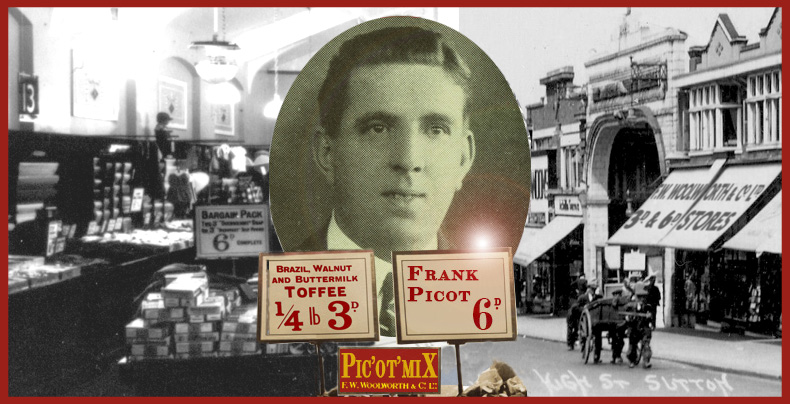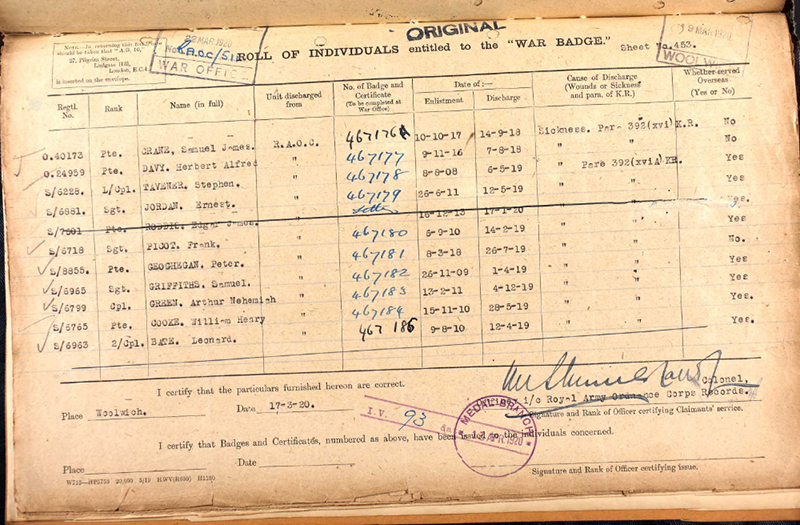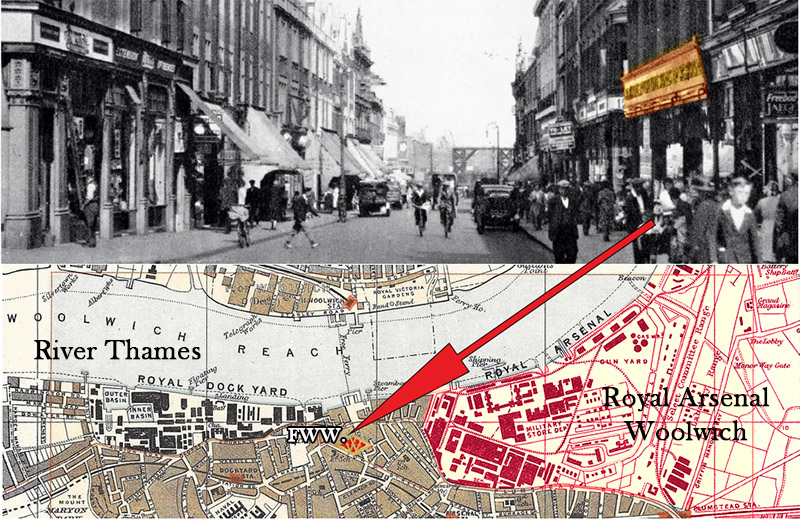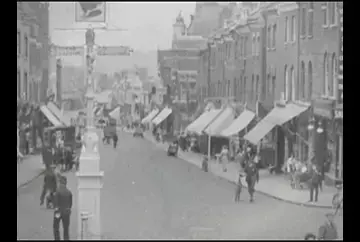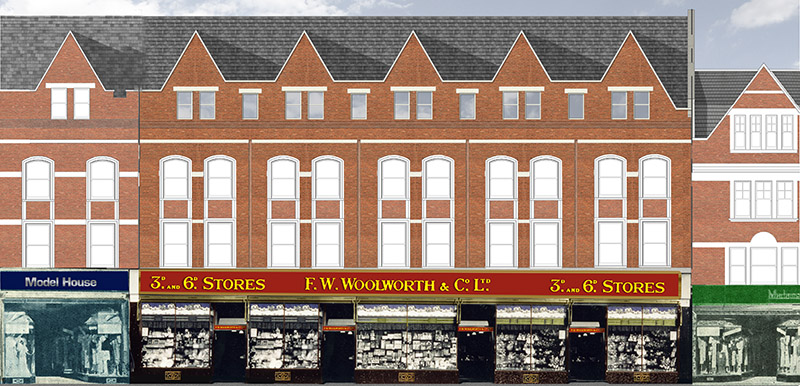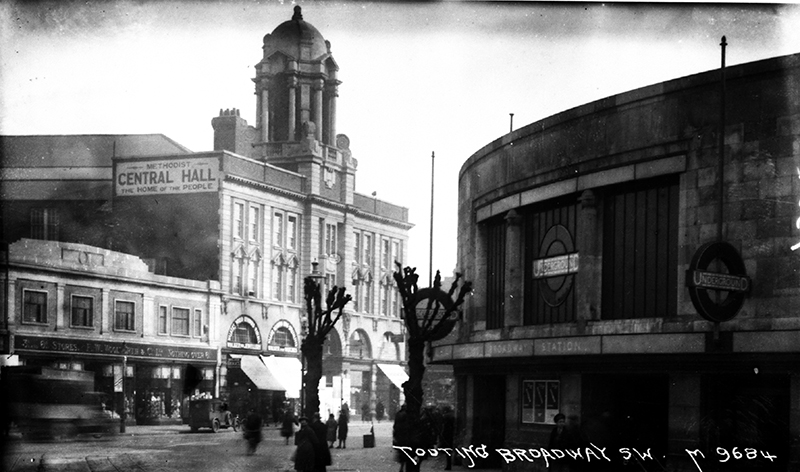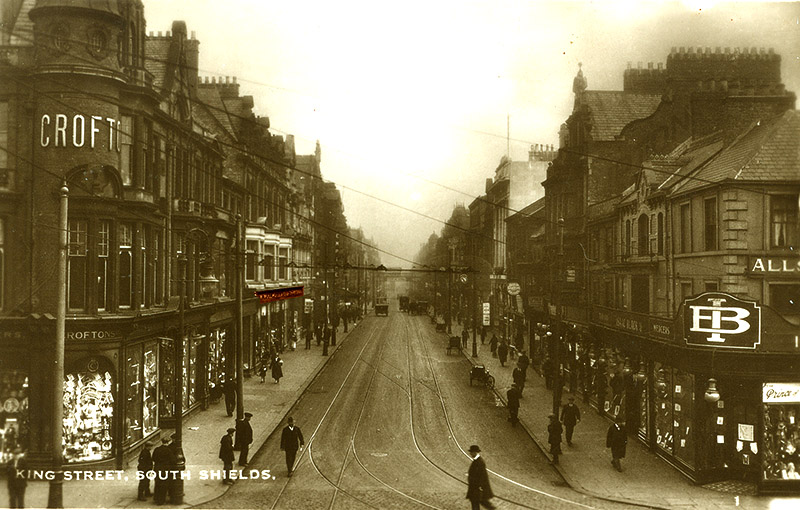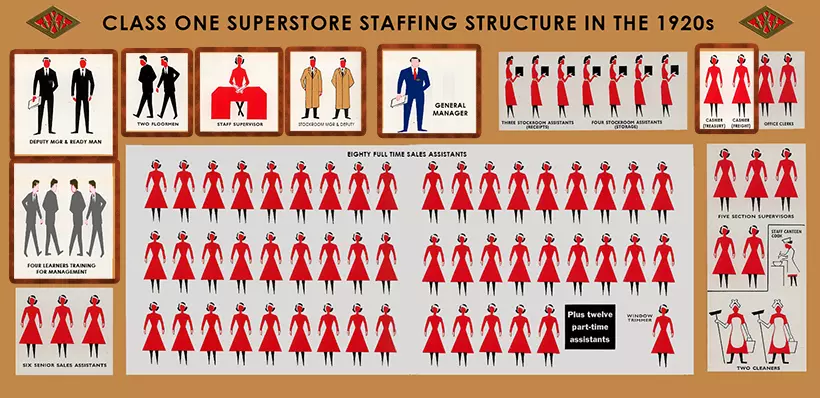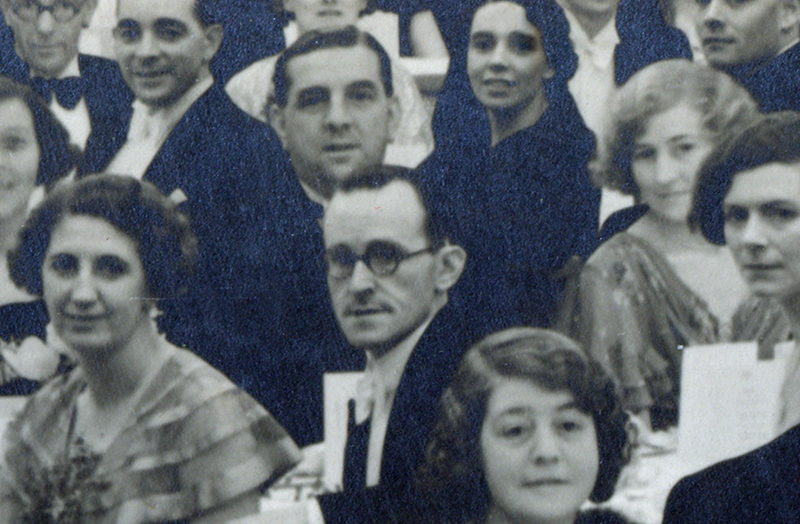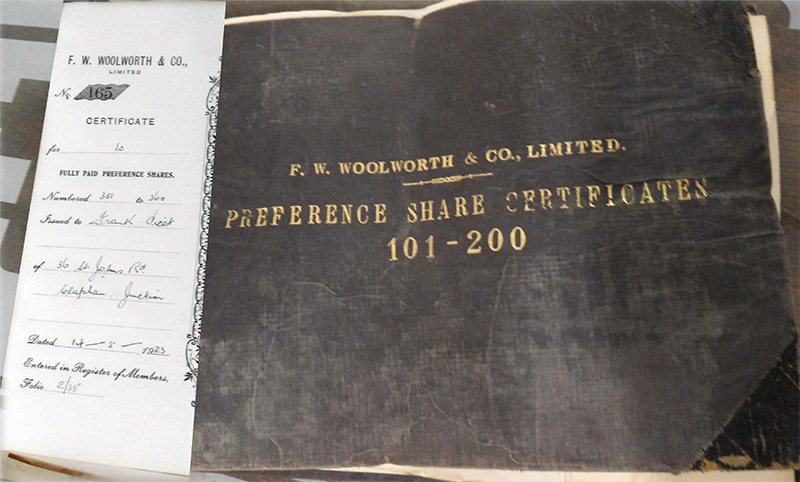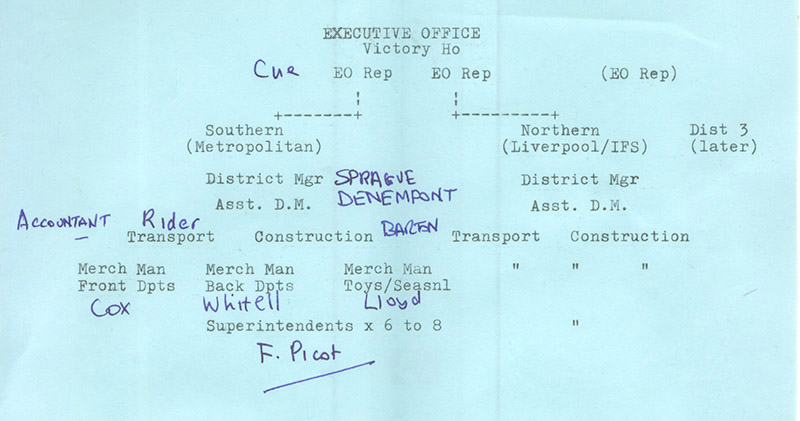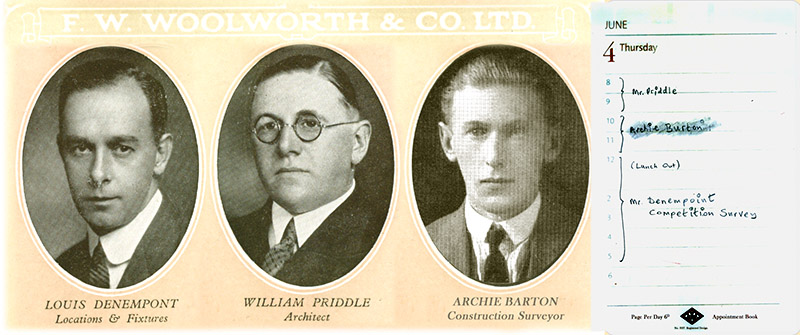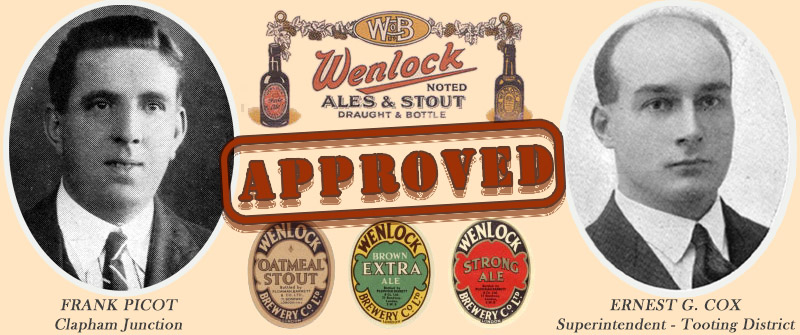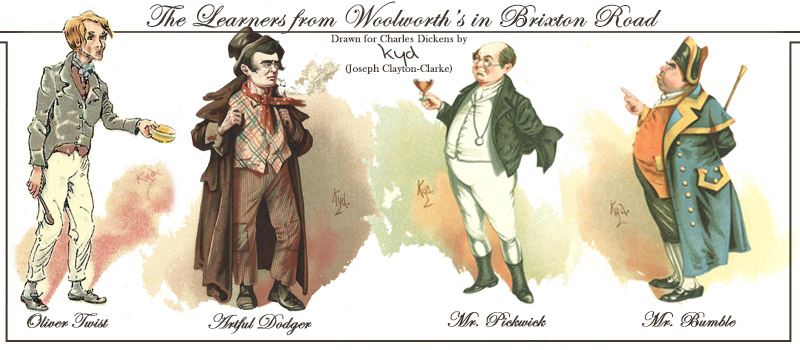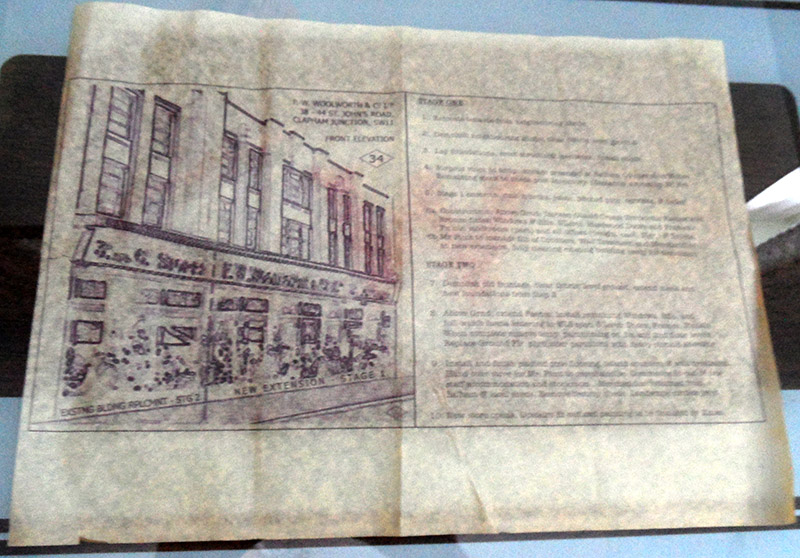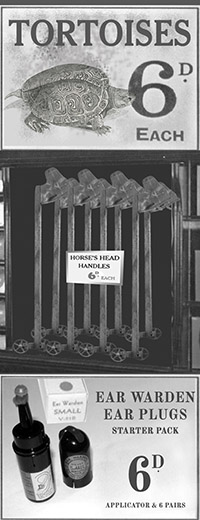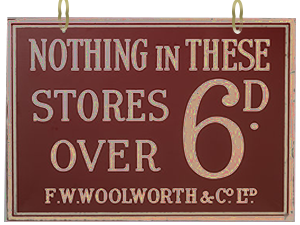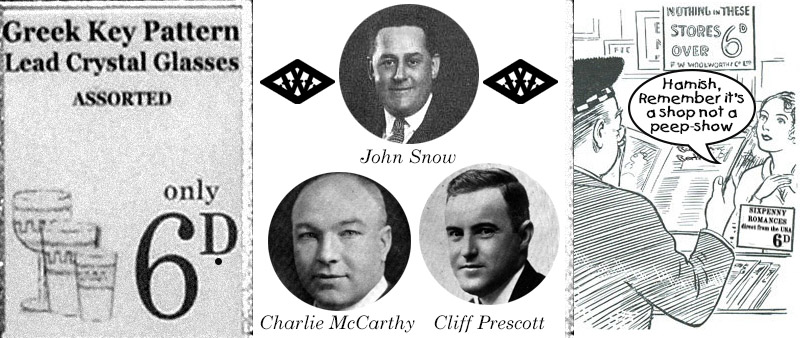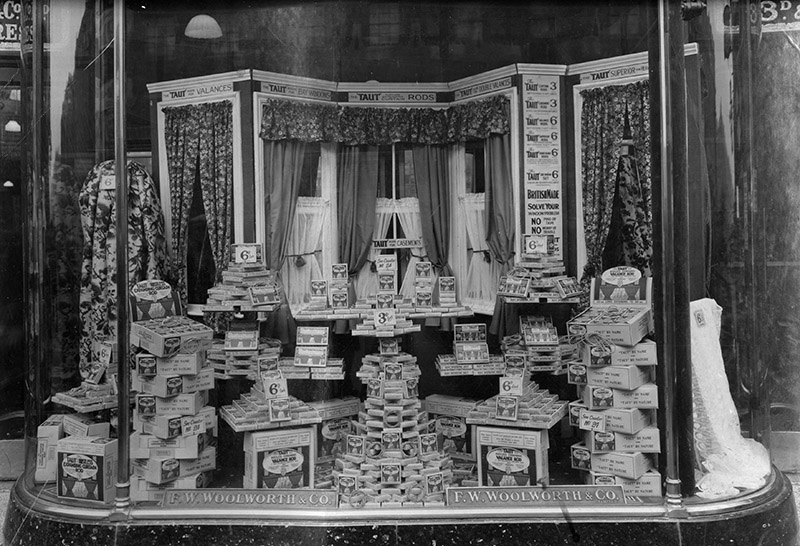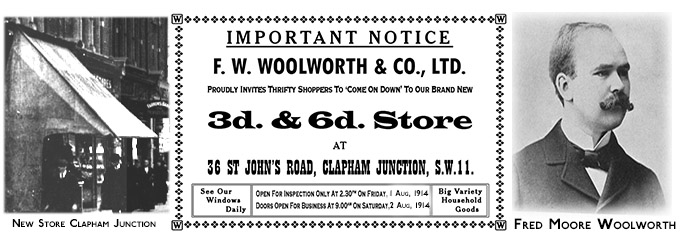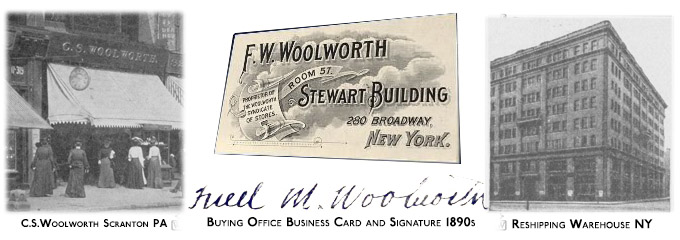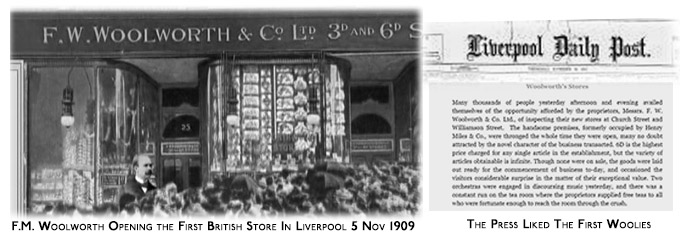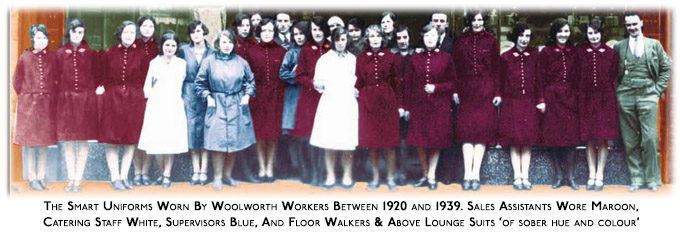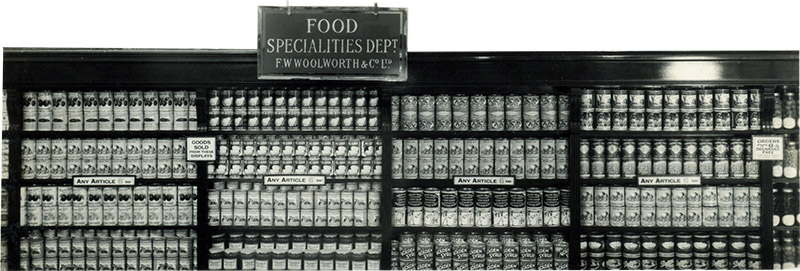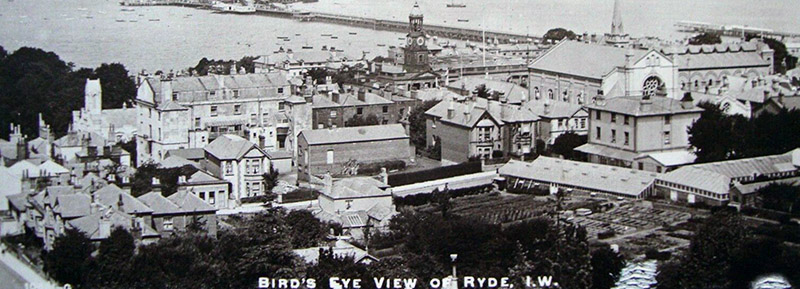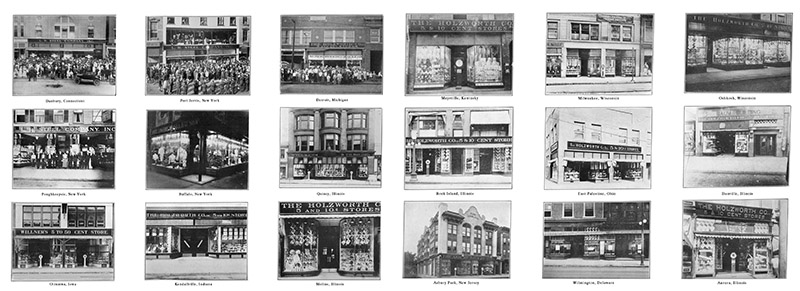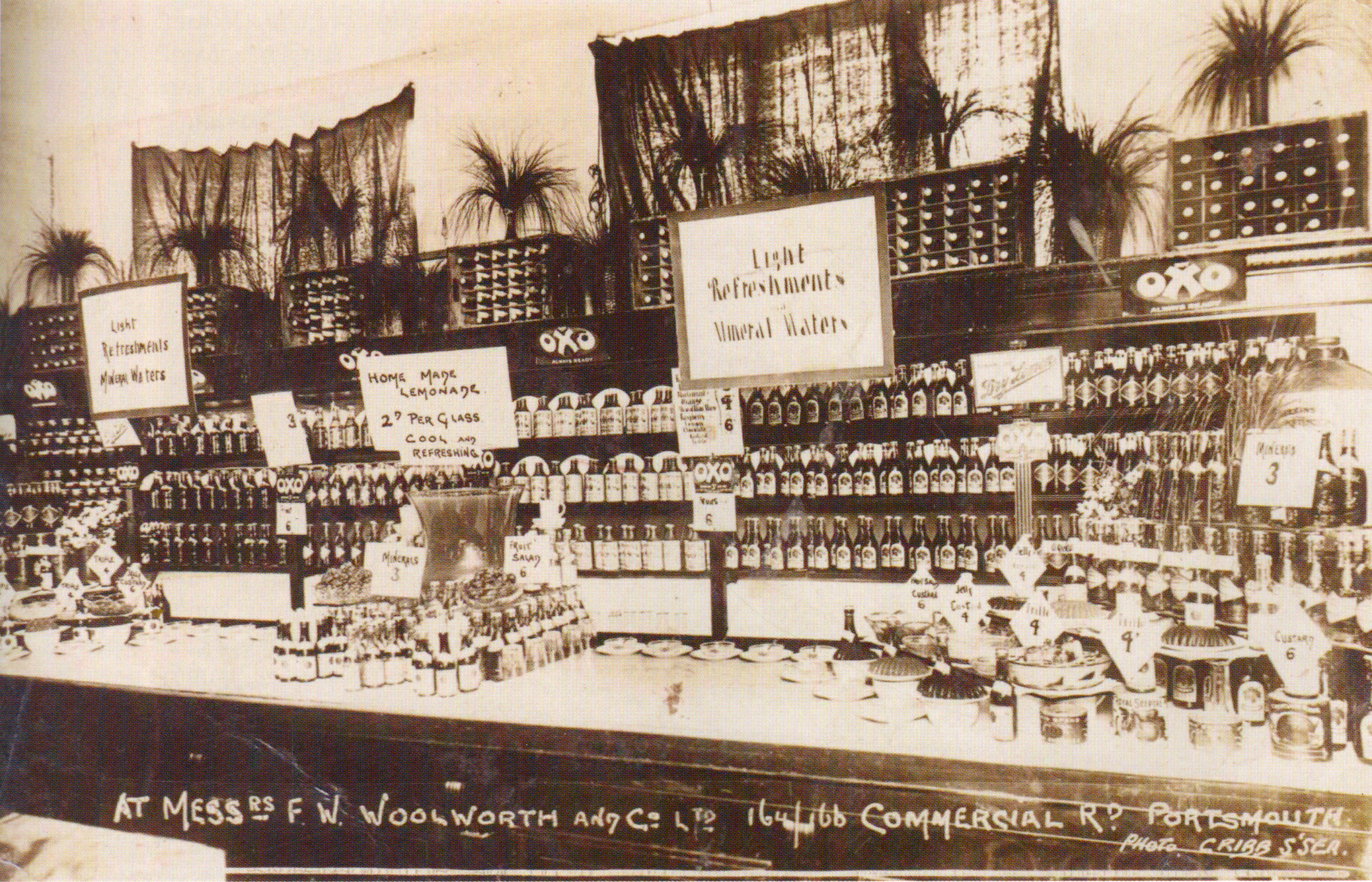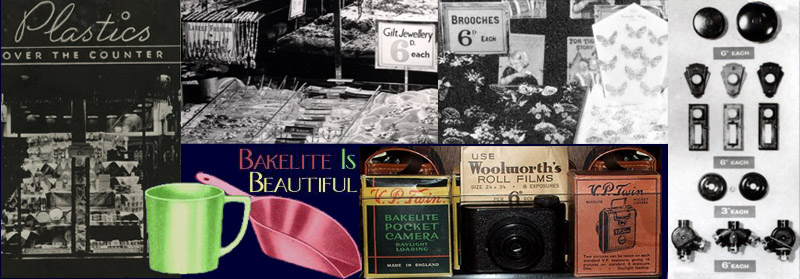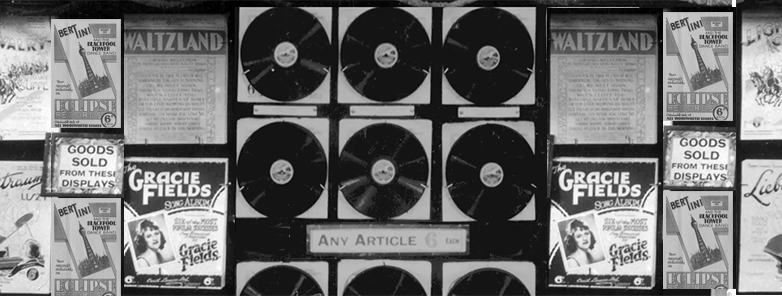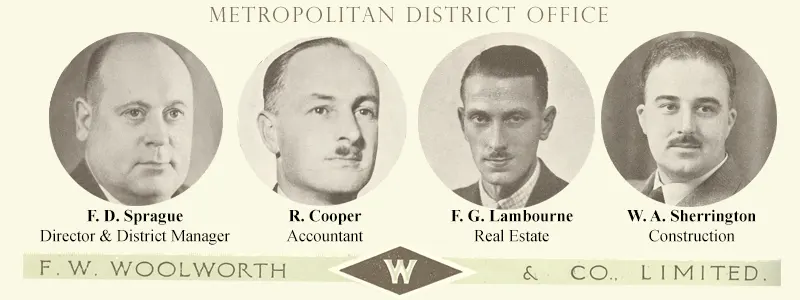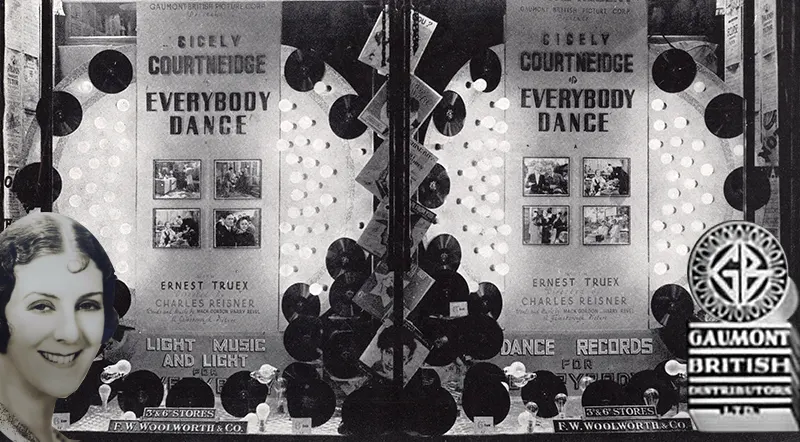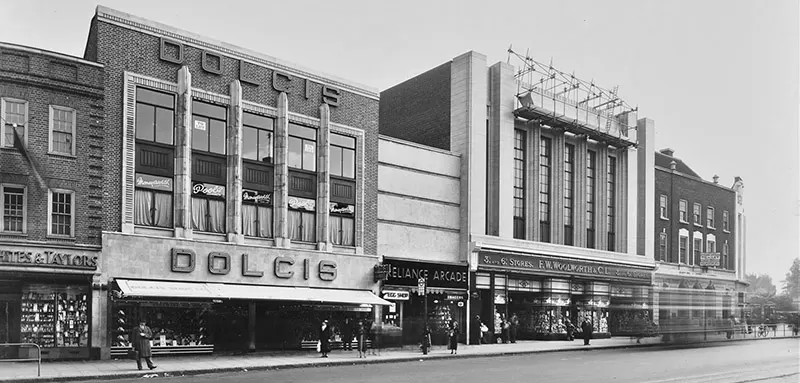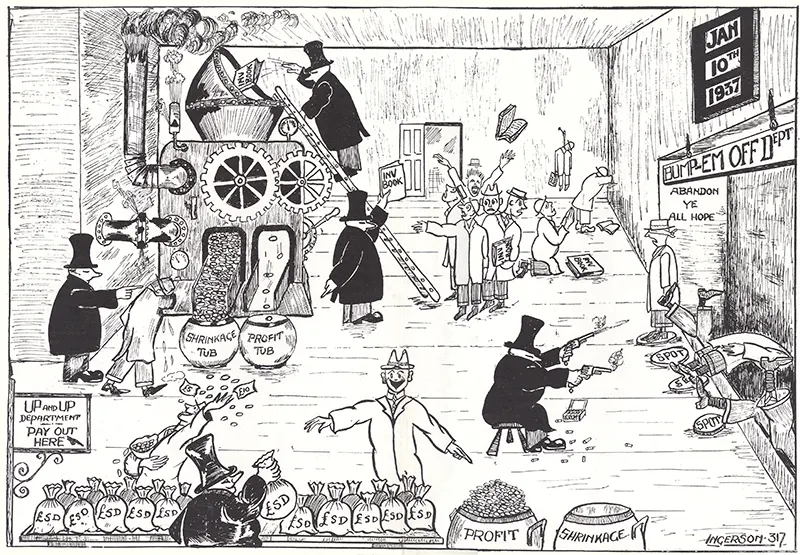The Woolworths Museum
Picot Mix Special Feature
Frank Picot
Trailblazer and master-builder
Frank had enlisted in the Army straight from school in September 1910, committing to serve for twelve years. He hoped to see the world, and perhaps be posted to India. But the powers-that-be had other ideas. They picked up on a mention that he was highly numerate and a "good organiser" in a reference from his Head Teacher and weighted this more heavily than the customary "keen sportsman who is equally happy as captain or team member". He would learn about factory mass-production and the logistics of getting everything from big guns to munitions from the production line to the battlefield. He was allocated to the Army Ordnance Corps, which in turn assigned him to their main munitions factory, the Royal Arsenal, on the south bank of the River Thames in Woolwich to the South East of London.
After basic training Frank arrived in Woolwich in late Autumn, 1911. The local talk-of-the-town was a new "Yankee Bazaar". F. W. Woolworth favoured city suburbs with local heavy industry for its first openings. Its founder had hand-picked a spot in Hare Street for his second branch in the South of the Country, and it had proved a big hit. Years later Picot would confide to the girls at his Woolies - London's first in Brixton - that 'Store 9' had been a home from home when he was in the Army. He vividly remembered cramming his pockets with threepenny chocolate bars and penny gobstoppers and building an awesome shine on his boots with Meltonian's finest tupenny boot-black!
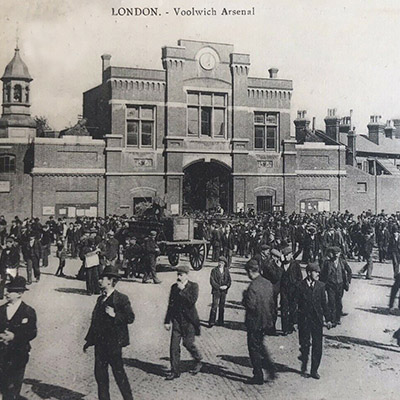
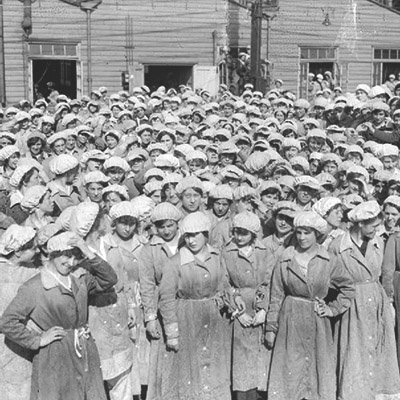
Frank quickly found his feet. He showed a keen interest in the work undertaken by civilians, who were a mix of older skilled craftsmen for specialist work, and local young men on the production lines. He had the common touch and was able to suggest improvements to the way that finished products were stored and despatched to where they were needed. His natural authority earnt the respect of fellow soldiers and civilians alike. Soon he was promoted to Corporal. He began to divide his time between the Arsenal and fieldwork, tracking the whole supply line, undertaking training and familiarisation with those who would use the output, and, for larger items like field guns undertaking inspections of items reported as faulty.
The outbreak of War prompted major changes. The all-male environment (with only four women in the workforce) was transformed by a mass influx of women workers for the production lines. By 1918 more than 24,000 were producing bullet cases and TNT in huge quantities. Frank was much more comfortable among this group than most of the soldiers, earning promotion to Sergeant. While others stayed away, he kept a close eye on the production line workers, especially "the canaries" who worked in the notoriously dangerous TNT shed. They had earned the nickname because the volatile explosives caused a yellowing of the skin, which became more pronounced the longer the woman had served. By engaging, Frank made his birdies feel valued, motivated and, so far as possible, safe. Senior Officers approved as the better the workers' morale, the higher their productivity.
TNT was not the only risk that he faced. When he joined up, he had hoped to see the world. What he got was several spells in the trenches each year throughout the War. Officers were under orders to keep visiting Ordnance men safe as they fixed the big guns or gathered learning to improve the munitions and supply lines. But they could do little to protect visitors from German mustard gas attacks. Frank suffered repeated exposure, leading to recurring breathing difficulties, particularly in cold, damp weather, which would plague him for life. The noxious, acrid chemical weapon ultimately led to Frank's early Honourable Discharge from the Army. Ostensibly young and fit, the Medical Officers at the discharge hearing warned him to take care. He would be vulnerable to bronchial diseases in Civvy Street.
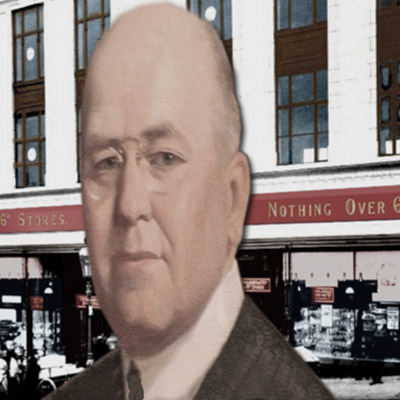
Long before the concept of outplacement, old soldiers had to fend for themselves. After enquiring in the Woolwich Woolies, Frank sent a telegram to the MD, Fred Woolworth, offering his services. To his surprise a post-boy brought a response before 9am the following morning:
- VICTORY HO, KINGSWAY * WOULD BE HONORED TO MEET YOU * STORE WOOLWICH 8AM MONDAY NEXT * CONFIRM ATTENDANCE * SINCERELY FMW
After the Armistice, the supremo had written a note saying ""ex-servicemen, particularly volunteers with leadership experience, make excellent learners. Seek them out." And Fred led by example.
Frank ticked all the boxes. He looked the part. He had natural charm and was assertive. But above all he had experience of "managing girls", knew what a supply line was, and appreciated the importance of paperwork. The MD offered 50/- (fifty shillings or £2.50) per week for a training period, and then "how tall can an oak tree grow?"
The question was rhetorical. He outlined the future potential earnings, with a percentage of store profits, perhaps as high as twelve percent. A small store made maybe £5,000 - "you do the math". He admitted to being impressed by the riposte "six hundred quid a year, then?" and turned straight to the practicalities. He advised Frank to take a room in a Guest House in Carshalton Road, turn right at the Cock Inn, and he would find store 71 just down the hill on the right, tucked between the Gaumont Cinema and the Sutton Arcade, at 91 High Street. As they shook hands to seal the deal, Fred whispered "The quicker you learn, the sooner you'll earn that six hundred. Welcome aboard, Son" and with that he was whisked away. A follow-up letter confirmed that he should arrive bright-eyed and bushy-tailed at 7 o'clock prompt on Monday, 30th June 1919.
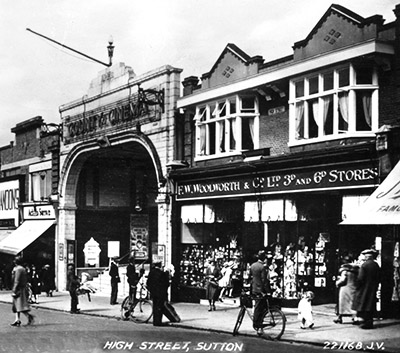
The Sutton store, (shown, left and below with one view taken at lunchtime, and another in the early morning with the sun blinds down, extracted from J. & V. Valentine's Postcards sold inside for sixpence the pair), had opened to great acclaim in July 1916. The firm's builders had surpassed themselves, fully joining two existing shop units upstairs and down. They had added a level, full-width fascia and preserved the symmetry of the double-bay frontage despite the marked downward slope of the hill. The pictures also show the elegant, galleried, open grand entrance porch of the new Gaumont British cinema right next door.
It had been a hit from the start, attracting shoppers from every point of the compass, local people were topped up with visitors from Morden, Hackbridge and Mitcham Junction, Epsom and Reigate, thanks to Thomas Tilling's buses and Southern Electric's cheap-day return train tickets.
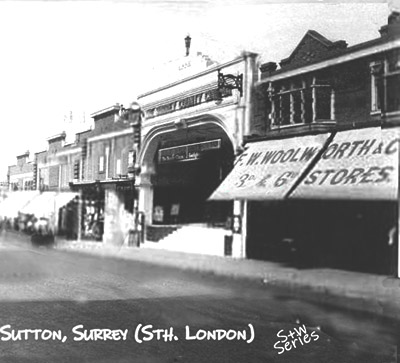 Frank soon found that the store's prime position enticed all manner of customers. They included the well-to-do en-route to Shinners Department store opposite, thrifty bargain-hunters from the glazed arcade, and goggle-eyed revellers from the Gaumont. Many a romance blossomed as queue-busting Romeos treated their Juliets to a tuppenny ice-cream, washed down with a penny cuppa or cream soda at the tea bar during the interval. Hours were extended to 10.30pm each night.
Frank soon found that the store's prime position enticed all manner of customers. They included the well-to-do en-route to Shinners Department store opposite, thrifty bargain-hunters from the glazed arcade, and goggle-eyed revellers from the Gaumont. Many a romance blossomed as queue-busting Romeos treated their Juliets to a tuppenny ice-cream, washed down with a penny cuppa or cream soda at the tea bar during the interval. Hours were extended to 10.30pm each night.
Each Thursday to Saturday night Picot was made 'Manager for the night', tasked with shepherding the stragglers out, and gathering the day's takings into 'pick up bags' to go in the safe for counting in the morning. Before heading home, he had first dibs on a staff perk - eating up any ice-cream out of the freezer "waste not, want not".
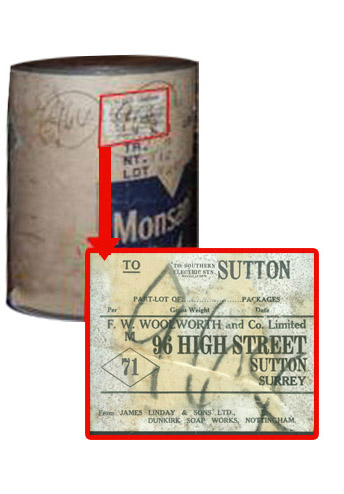 Frank's suit and tie were strictly for the evening shift. Like every learner he was assigned to the stockroom. It may seem strange to place a fast-track trainee manager behind the scenes, but it was the engine room of the store, with connections to everything else.
Frank's suit and tie were strictly for the evening shift. Like every learner he was assigned to the stockroom. It may seem strange to place a fast-track trainee manager behind the scenes, but it was the engine room of the store, with connections to everything else.
All deliveries were received and recorded in the stockroom, which fulfilled orders from the salesfloor and handled any returns or claims. Suppliers sent goods on special terms by rail to the local station. Every few days a Carter Paterson lorry ferried them the last mile to the store. Managers could send a boy to collect anything they needed urgently.
The supply chain was ahead of its time. Using rail had a much lower carbon footprint than lorries or horses. From 1912 suppliers were encouraged to use the firm's reusable containers to ship goods to stores. The metre tall drums, made of rigid, shock-proof cardboard, with a metal lid and base were packed with straw and virtually indestructible.. It is remarkable that some ways of working were so sustainable years before climate change became recognised as an issue.
In Autumn 1919 a family crisis forced Frank to approach his Store Manager, William Carlisle, with a special request. He knew that it was company policy that no holidays were to be taken until an employee had completed a year's service. But could he please take a fortnight off unpaid, as soon as possible? The boss asked him to explain himself. He reported that his brother, Corporal George Fauvel Picot, had been injured by a mine in the final months of the war but had made light of his wounds. A year on he had suddenly collapsed, brought down by shrapnel, which had begun to move. Over multiple operations the Regimental Surgeon had managed to remove nearly all the fragments, noting that the patient must have been in very severe pain for an extended period for the debris to become so widely dispersed and deeply embedded. Months of bed-rest were required for the wounds to heal. When he had finally been signed off as ready for release, he had proved unable to stand, let alone walk. It would be a long road back.
At George's request, rather than move him to a facility in Wales, the Royal Welsh Fusiliers had found him a rehabilitation bed at the 2nd Durham V.A. Hospital in South Shields. Frank explained that George had briefly lodged in South Shields before volunteering for the Army in 1914. He had been approached by a long-lost relative, inviting him as a house guest. Host and guest had quickly become friends, Frank continued. The VA Hospital had called him to express concern about his brother, who seemed to have given up and was not responding to treatment, even though there was every chance that - after building his strength - he would be able to walk again unaided. Under interrogation, George's surgeon had admitted that he feared that the main injury was in the head rather than the legs. His prescription was a good talking to from someone he trusted to raise his spirits and stiffen his resolve, and that someone .... was Frank.
Carlisle replied ""NO! Absolutely not, I won't hear of it. Unpaid leave, unthinkable. Now paid leave that is a different matter. Have you the money for a train ticket? Anyway draw £10 from my account in the Office as a gift. No need to pay it back, I've got plenty. Then go fetch your things at once and take a cab to King's Cross for the sleeper up to County Durham. And don't come back until your brother is on the mend. Family is important, the firm will cope. I'll handle the Super, don't you worry."
As ever, Frank did more than he was told to. He waxed lyrical about the wonder of Woolworth, how the work was rewarding and potentially very lucrative, and how FWW loved military men. When his brother asked whether they might take "a cripple?", rather than rise to the bait, he wired FMW and asked him. He under-estimated his MD's generosity of spirit and kindness. The reply brought a rare tear to his eye.
- FPICOT C/O 2ND DURHAM VA * WILL TAKE ANY PICOT * CRIPPLE BE DAMNED * FIX MEET WHEN READY * GOD'S SPEED TO RECOVERY * FMW @ WOOLCOTID
The groundwork had been laid. All George had to do was months of intensive exercises and physiotherapy through the summer and autumn. Before Frank returned to London the brothers agreed that they would spend Christmas together in the capital. Over the holidays Frank would arrange for George to meet with Fred, and the rest would be up to him. Months later, the day before Christmas Eve 1919 George stepped confidently out of a hansom cab in Kingsway, WC2 and into the lobby at Victory House under his own steam, without sticks. He would shake hands with the MD, who would greet his guest at the appointed hour and invite him to "step onboard the elevator for the ride of a lifetime". By January 1920 he too would be going up. You can read more of his story at the foot of the page.
Meanwhile, ten days after leaving, Frank was ready to climb back into the saddle. Bill Carlisle greeted him like a long-lost son, relaxing his normal gruff, rather aloof persona for a moment, he grunted "Hear you fixed it?", "Yep", "Good. Stockroom is backed up. Better snap to it. Um. Er. Cock Inn for lunch, my treat, twelve noon, don't be late. You can tell me all about it.". As he climbed the stairs back up to his bench and Freight Book, Frank couldn't help but smile. (If you are using a PC or tablet with a WEBP supporting browser, the film on the right looks down Sutton High Street from the Cock Inn at the top to Woolworth's at No. 96 a little way down on the right. Hit [F5] to make it play again.)
Back in the harness the Learner spent his time wisely. Gaining confidence, he began to apply the military precision that he had learnt at Woolwich Arsenal to the Woolworth Stockroom. Merchandise was stacked neatly in the bins (racks of wooden shelving), while boxes, crates and oversized lines like galvanized buckets and bowls, large china planters and suitcases were stacked straight and true in the bulk area. Everything was counted, with stock-on-hand figures updated in front of the goods each time stock was requested by the salesfloor. He made it policy to go to the salesfloor and collect the stock requests each morning, after the Store Manager's inspection, and frequently wheeled the trollies down himself. This allowed him to get to know the girls and the customers and to learn how each item was displayed and priced. He volunteered to collate each counter's daily reports of sales, best sellers and customer requests that could not be fulfilled. Each day he created a summary for his Manager and, once approved forwarded a copy of the best seller and poor item reports to the relevant buyers at "Executive Office", Woolworth's headquarters at Victory House in Kingsway, WC2. Word of his diligence and meticulous attention to detail soon got back to Fred Moore Woolworth, who nodded sagely muttering "must've been recruited by a wise man" chortling away to himself. "I guess the question is - is it time? Send a memo to the Super telling him to administer the test, and report back."
The test - conducting a complete daily inspection of the store with the Superintendent interrupting at every turn - proved he was ready. He knew the departments, he knew all of the girls, perhaps too well, it seemed he knew the item number of each of the five thousand products, which supplier it came from, what quantity came in a box and even the "G" (gross margin, a close-guarded secret among management). He could even reel off what the lead-time was and how many of each thing there were upstairs. Many a learner took five or even seven years to reach this standard, even then a fair number only just scraped through. The Super wired his MD:
- TO FMW @ WOOLCOTID * PICOT * ANSWER YES * SUGGEST 78 STREATHAM ON ANNIV. OF APPT. * EGC
The dye was cast, though. in keeping with tradition Frank was not told until Saturday night as he locked up. As if from nowhere the Superintendent and his Manager materialised on the doorstep. "Give me those keys at once, young man. You will never lock up this store again, do you hear me?" Sheepishly Frank handed over the bunch, wondering which of his many sins had been found out. Who had blabbed? But neither boss nor boss's boss could keep a straight face. Reaching into the other pocket, "Ernest by name and earnest by nature" G. Cox pulled out a different bunch. "But you will be needing these to unlock Streatham High Road on Monday morning. Not a moment before 7am. No visiting for a sneak peek. Congratulations, Store 78 is yours, and if I may say very well deserved. The best morning inspection I have ever witnessed and that's a fact. And that will be the minimum standard I'll expect from now on.
For Frank, Monday, 27 June, 1920 marked a new beginning. It fell 362 days after he had joined Woolies, being the nearest Monday to the Anniversary. CEO Fred Moore Woolworth had kept his promise, offering a 12% commission rate, almost twice the average, reflecting the fact that his protégé had stepped up and proved himself willing to learn ... and ready to earn.
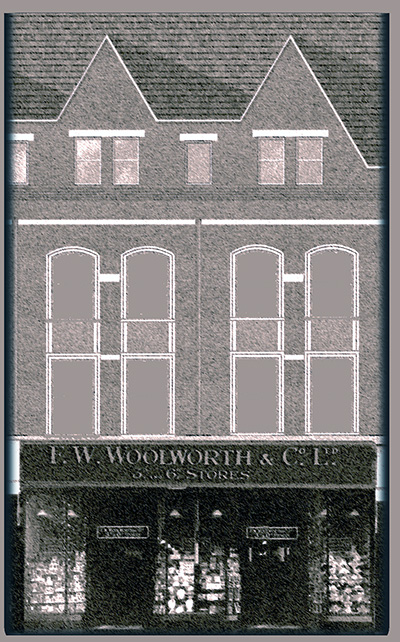
Like Sutton, Store 78 had been forged out of two existing shop units during the Great War. It was nicknamed "The Victory Store" because it had opened just three days after the Armistice on Thursday, 14 November, 1918. The welcome news had buoyed the nation and had got people spending early for Christmas.
The American Chief Property Scout, Louis Denempont, had hand-picked the location at the midpoint between two successful stores, No. 7 Brixton and No 12. Croydon, all lying on the same arterial road which stretched from the Houses of Parliament at Westminster all the way to the South Coast at Brighton. The landlord, who owned the whole block, had offered a generous rent, fixed for sixty years, and had promised to let the neighbouring properties to the right on short-term leases so that Woolworth's could expand when the store was a hit. The lease included an access path along the back of those shops to a yard with gates into Kingscourt Road, a side-turning to the right of the block.
E.G. Cox, the Superintendent, had singled out Frank because he felt that the store, which seemed to be running well, had vast untapped potential. Like most first-store managers, his predecessors had been very hands-on. The training regime had done little to teach them to delegate. They had busied themselves with display, dressing the windows, setting up promotions and laying out counters themselves. They had spent the rest of each day watching customers like hawks from a vantage point near the doors. Woolworth considered the loss of profit through theft or breakage, known as shrinkage, to be a measure of how effective their managers were. That is why they felt the need to prevent "rough-types" from Tulse Hill bring their evil ways from Brixton to little Streatham. They claimed to have frustrated multiple incursions by "tinkers from Mitcham Fair".
On his inspections Cox had used the Company's trusted Checking List to see whether everything was available. He had consistently found that a large number of best-sellers were missing. The stockroom appeared tidy, but closer examination had revealed that the merchandise was muddled and hard-to-find.
Simply put Frank's challenge was to do what he did. His ability to charm the birds from the trees made it easy for him to persuade his young, female staff to do most of the salesfloor work for him. Learners and floormen could watch for thieving and breakages. He would focus behind the scenes, regimenting the stockroom into a logical order that would be easy to manage, checking sales reports and raising slip orders for missing merchandise and getting them posted to the suppliers the same day, or telephoning them to get the goods despatched immediately, on the promise that written confirmation would follow. Within weeks sales started to rocket, and staff morale hit an all-time high. An elderly spinster who had joined as floorwalker (staff supervisor) on opening day, explained that previous Managers had barked orders as if they were talking to a dog, but had not followed up to make sure they were carried out. By contrast Mr. P. explained tasks clearly, asked nicely, and praised lavishly at his next morning inspection, or looked disappointed if the issue remained unresolved. "They can't do enough to please him", she reported.
For his part Frank complained to the Super, and later to Fred Woolworth when he called in unannounced, that the premises were far too small. There was a crush at the entrances as shoppers arrived from hither and yon. The well-to-do from Dulwich and the Edwardian Villas of the Norwoods and Crystal Palace, swelled the regular clientele from Streatham, Streatham Common, St. Leonards and Norbury. "Seventy-eight needs an extension", he argued.
The MD gave a different diagnosis - the store wasn't big enough for its Manager but was adequate for the location. Now the systems were in place, a lesser man could take the helm, freeing young Picot for a move up.
Cox duly shuffled his deck of Managers to make a space for Frank at Mitcham Road, Tooting. Foot for foot of selling space, Store 64 generated by far and away the most sales and profit of any of his outlets, thanks to its proximity to the entrance to Tooting Broadway station on the London Underground, with its fast Northern Line service to the City, and the Tram terminus. But Cox also saw similarities to the Sutton store, which he knew Frank could exploit.
It had been a ground-up build to the Company's own specification. In 1912 the architects North and Robin, based near to the firm's headquarters in Kingsway had designed an elegant building in Chatham High Street (Number 17) which copied the best features from the first purpose-built outlet in Castle Street, Bristol (No. 10, built in 1911, which was designed locally) and had refined its design at Clarence Street, Kingston (No. 43, built in 1914), each to acclaim, before coming up with a simple repeatable formula which balanced elegance and distinctiveness with a low construction cost and a fast build. It had worked well in Upper Market Street in Hanley, at the heart of the Potteries in Staffordshire (No. 55, built in 1915). They were commissioned to make further refinements at Tooting, where the company had bought surplus land that had been cleared by J. Arthur Rank to give access to develop his huge Methodist Central Hall in Mitcham Road. Rank, then at the helm of the milling and flour business established by his Father, had a strong social conscience and deep religious convictions. The Central Hall had been established both for worship and for his pet project, a Methodist Cinema, which would show a mix of documentary films and dramas that he had commissioned, and blockbusters from others that conformed with his strict moral code.
When Frank arrived, the "tall building next door" attracted huge crowds of movie-goers several nights a week, but did not offer either a bar or a café for refreshments in the interval. It was destined to be the first of a chain that would dominate the movie industry by the beginning of World War II, owning both the Odeon and Gaumont British brands, and most of the country's film studios and production facilities.
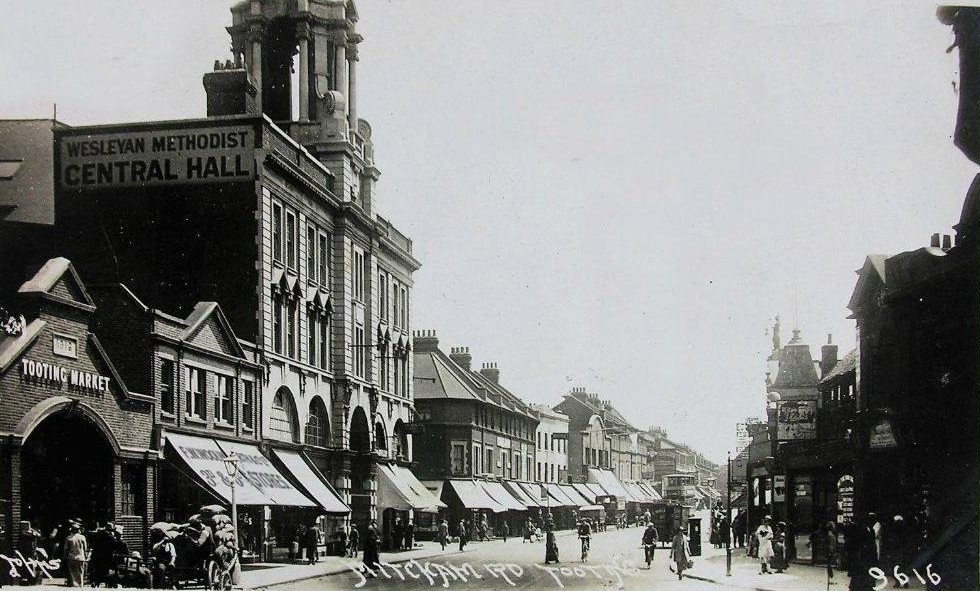
Fortuitously Rank's surplus land could not have been better placed for the maximum passing trade. The Woolworth Store was clearly visible from the iconic art deco entrance of Tooting Broadway Underground Station, and many London tram routes terminated within feet of the door. The junction of Mitcham Road and Tooting High Street, affectionately known as "Amen Corner", (the end of one prayer often preceding the start of another), marked the spot to swap from the slow suburban services which carried tens of thousands of commuters from their homes in the leafy suburbs of Wallington, Carshalton, Mitcham, Belmont and Rose Hill, and Express Services to town, either above or below ground. Many filled the short wait for a connection with a quick trip to Woolies.
Cox attended the handover of the store at the beginning of October 1920. He was able to confirm that the MD had accepted his new Manager's plea that it seemed unreasonable that he would not see the commission generated on the improvements he had made at Streatham as he had been moved so quickly. Despite the higher sales volume at Tooting, he would continue to get a 12% share of profits, and the firm would guarantee a minimum at the year-end in January of £600 as Frank's wage for the year. His drawing allowance, taking part-payment in advance, would be raised to £12 a week with immediate effect, or as the Superintendent put it, 480 sixpences, a King's ransom for a young man living in digs. His charge appeared content.
On his next visit, to sign-off the planned Christmas counter moves, Cox fully expected that the new man would be devoting his energy to establishing his systems and availability checks behind the scenes. But it was soon clear that this was only a tiny fraction of what Frank had been up to. He had been burning the midnight oil, and had prepared a surprisingly detailed business plan. It proposed radical changes to the layout and offer in-store, and explained the rationale for them:-
- the opening hours would be extended to 10.30pm each night
- Mr Rank's manager would encourage movie-goers to visit FWW in the interval, which he would extend by 10 minutes. Films would screen nightly, except on Sundays ("God's day") and Wednesdays (the 3D & 6D Store's early closing day)
- in exchange many items like ladies' thingummies (undergarments), Yankee Magazines and exotic, risqué Sixpenny Romance job novels, would be moved well away from the Tea Bar to avoid offending the sensibilities of cinema-goers
- in a side deal, the store would prepare an agreed number of pre-packed bags of weigh-out sweets, selecting only fruit drops, Everton peppermints and soft-centre chocolate coated candies (all of which did not crunch), with wax wrappers removed (to avoid rustling) and would s8pply these to its neighbour at threepence a quarter (roughly 1½p per 125 grams at the time, £1.26 at today's prices). Cinemagoers would be blissfully unaware that they were paying a premium to eat Woolworth sweets, which would be unrecognisable in the dark without the distinctive look and smell of their brightly coloured jackets. The opening order would be 100 bags a day. Any change would be notified a week in advance. The plan noted that the store would take the opportunity to clear any lumpy stocks within the selection to avoid wastage. This informal "gentlemen's agreement between Managers" was described as a 'win-win', that would swell the coffers of both neighbours.
- virtually every item of merchandise would move, with space allocations for ranges being adapted up and down. This was beyond the scope of the cinema deal, targeting the counters inside the front doors to time-starved commuters, between tram or tube connections. Displays would include a wide selection of books, wrapped, filled finger rolls and sandwiches, chocolate bars and chewing gum for the peckish, miniature Outdoor Girl lipsticks, eyebrow pencils and powder compacts, paper tissues, hosiery and disposable rainhats for the ladies, and briar pipes, tobacco, lighters, sixpenny flat caps and folding pocket umbrellas for the Gentlemen. They would also cater for students, with pens, pencils, rubbers, rulers and scribbling pads for the thousands of passing teenagers heading up to the municipal technical and vocational training schools along the road down to Wimbledon. Many a girl passed the doors on her way to a day's Pitman's Shorthand, Advanced Typewriting or GPO Telephony. Every commuter would "Shop Woolworth's First".
- staff rotas would be tweaked to allow those front island counters to be double-manned in the rush-hours, with one girl registering and the other bagging the goods. All management, including the floormen and learners, would man the floor, managing the queues, keeping the entrances clear and deterring anyone thinking of leaving without paying. They would have plenty of time for behind-the-scenes work between 10am and 4pm.
Cox tried and failed to take the plan in his stride, as if it had been expected. But his face showed that his cogs were whirring to assess the likely impact of the changes on his own commission. He approved the proposal without any changes, and admitted that in one hour the £600 had gone from a worry to an irrelevance.
Within a decade the firm adapted the building to accommodate the runaway success of Frank's changes, widening the store to treble the number of entrances, and the counters straight inside them. And, more than eighty years later, long after the Methodist Central Hall had made way for a Marks & Spencer store seeking a slice of the action, and eons after Woolworths had removed the tea bar to make way for extended displays of Ladybird Clothes and Toys to compete with them, Tooting continued to be one of the top-performing pic'nmix stores in the UK, and to be given a special layout quite unlike most other branches, targeted to commuters, who continue to travel into town on the Northern line to this day. But that was yet to come.
Before waiting for Frank to implement his plan, Superintendent Cox replicated the concept along the Broadway at Store 21, Wimbledon, and up-line at Store 34, Clapham Junction, which were both in locations dominated by huge commuter stations.
After the Annual Inventory on Boxing Day, Accountants computed that Frank's remuneration package would be just ten shillings short of £1,000. The balance was handed over on 31 January 1921. As Fred Woolworth had guessed, £12 per week of advances had hardly taken a nibble out of Frank's commission. With the security of cash in the bank, the year ahead would bring momentous changes.
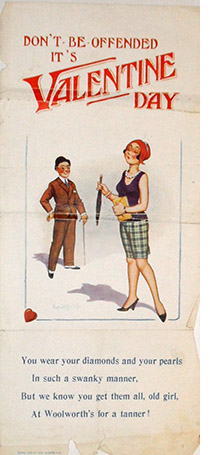 On St. Valentine's Day, if legend is to be believed, Cupid's arrow struck. Frank had always been a ladies' man. Life in the army, and particularly his time at Woolwich had given him a confidence and swagger that eluded most of his peers. The spinster floorwalker at Streatham had spotted at once that he only needed to flutter his eyelashes and most girls would swoon. At Tooting winter evenings brought many a single woman through the doors, particularly during the interval of films in Mr Rank's lovely, warm cinema. On February 14 one straggler didn't return for the second half. Instead, she sat quietly, staring into space, and stretching out a tupenny mug of tea. It is said that Frank took pity, grabbed a large bowl of ice-cream and two spoons and struck up a conversation. Whatever his original intentions, by the end of the encounter he was smitten, she was the one, and, quite literally, Frank's Card was marked.
On St. Valentine's Day, if legend is to be believed, Cupid's arrow struck. Frank had always been a ladies' man. Life in the army, and particularly his time at Woolwich had given him a confidence and swagger that eluded most of his peers. The spinster floorwalker at Streatham had spotted at once that he only needed to flutter his eyelashes and most girls would swoon. At Tooting winter evenings brought many a single woman through the doors, particularly during the interval of films in Mr Rank's lovely, warm cinema. On February 14 one straggler didn't return for the second half. Instead, she sat quietly, staring into space, and stretching out a tupenny mug of tea. It is said that Frank took pity, grabbed a large bowl of ice-cream and two spoons and struck up a conversation. Whatever his original intentions, by the end of the encounter he was smitten, she was the one, and, quite literally, Frank's Card was marked.
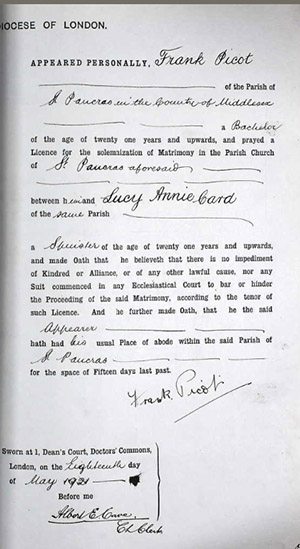
To his relief, the young lady returned the next evening for a repeat showing, but not at the Central Hall cinema. Romance blossomed.
Never backward in coming forward, Frank soon popped the question. The engagement ring was gold and the diamond was real. It most certainly had not come from Woolworth's. And the answer was "Yes"
Nine weeks after their first encounter, on 19 May 1921, all five siblings and both of Frank's parents, along it seemed with half of Woolworth's management and staff from the London Area were there to witness Frank Picot and Lucy Annie Card make their vows in church at St Pancras in the Diocese of London.
At the reception, a telegram from the MD offered a wedding gift of ten days' extra paid holiday to begin the following morning. It is said that brother George caught the bouquet, still up on his hind legs.
Throughout the Spring and Summer, store 64 was buzzing. The layout changes were working. It seemed that each day more and more people were on the doorstep jangling the doors as 8am came around. By nine the front counters were stripped, and the assistants were glad to catch their breath, as the school bells rang, and the last office workers dashed to get to their desks by half past the hour. Morale was at an all-time high. When a replenishment sheet was sent to the stockroom for more merchandise, it was in stock and arrived in a few minutes like clockwork. By first break order was restored, with the glass dividers atop the mahogany counters once again crammed full ready for the hoards to head in at midday for a snack at the tea bar, or a top-up shop.
Mr. P. had rescheduled his morning inspection for 11.30 rather than the traditional 9am to make sure that he saw the store at his best. Like a doctor on his ward rounds, the boss would be accompanied by a regiment of under-managers, including his Deputy, the Floormen and the Learners, with the Floor Walker scribbling down his pearls of wisdom on alternate sheets of a perforated penny pad. Once he had finished, these summaries of 'things to do' would be torn out and handed to each counter as a checklist. Frank had come up with a cunning ruse and asked the note-taker to use a piece neatly cut from a penny sheet of Diamond W carbon paper to keep a copy, just in case. He rarely had to refer back as his team subscribed to the "thy will be done" rule.
By mid-summer it seemed that the boss was on target to treble his commission by the year end, meaning everyone was surprised when he received a 'phone call summoning him to Executive Office. Old hands had seen this happen before, a bit like the games of Snakes and Ladders on the toy counter. Either it meant that their Manager was off to the Head Teacher for a caning over some misdemeanour - a snake - or was about to climb the ladder to a larger store. Traditionally most Managers paced nervously during the first week of January after submitting their Inventory Book and Annual Figures, never going more than a couple of paces away from the 'phone. Some years a quarter of all Managers found themselves in different stores by February 1st, Not in August. What could the matter be?
The wisest long-servers considered that there was nothing to worry about and dampened down the speculation. They explained that FWW always kept newly-weds where they were for at least a year to give them time to adjust and settle in to married life. Everyone was shocked when - questioned by one of his favourites - he told them he would be leaving. He let them think that - as was their way - the powers-that-be were forcing him to move three hundred and fifty miles North and East to County Durham. But the reality was rather different.
Fred Moore Woolworth had not randomly despatched his blue-eyed boy to open his latest emporium in South Shields of all places in the frozen north against his will. His protégé had suggested the location while up visiting his brother George in 1919 and the MD had made a note. Once a site was found and consents were obtained, he had shared the news with Frank, asking who he thought should manage it. Perhaps he expected George Fauvel Picot to be the reply. Unexpectedly Frank put his own name forward. He later confirmed his decision before his wedding, after consulting his intended. He wanted to lead the project from day one. On his trip North, Frank had stayed with the long-lost relatives who had given George a home and had liked them. At his wedding reception they had invited to come and live with them for a while and had plenty of space to accommodate them. Frank had confided that when the opening was a success, he wouldn't overstay his welcome, as a climb onto the next rung of the ladder, to a 'Class 1' superstore, would quickly follow ... or, if it failed, he would face a long walk to the Labour Exchange.
Joining on the ground floor afforded opportunities that Managers did not normally get. He was able to define the store's internal configuration, set its merchandise assortment and shape the workforce. His policies, procedures and entrepreneurial approach could be baked in rather than grafted on later. Instead of inheriting a team from a predecessor, he could shape the staffing profile, place the advertisements and conduct the interviews to hire a staff like no other. Fred Woolworth was happy to let him have his head, and instructed John Ben Snow, the Buying Director, to oversee the plans and make sure that plenty of the desired merchandise was available. Ever the showman, JBS went the extra mile. He laid on a marching band in King Street for opening day, and a chamber orchestra to grace the Restaurant, which would give away hot drinks and toasted tea-cakes free-of-charge for the first week. Stilt-walkers, clowns and magicians were also on hand to set '104' on the road to success.
As opening day approached, there was a frenzy of activity in-store. New clerks spent the morning in the canteen getting trained on "The Woolworth Way". Executive Office had established a firm set of standards and rules for almost everything. Acceptable hairstyles, the wearing of jewellery, the ironing and wearing of uniforms, and footwear were all tightly regulated. There were rules about how to serve customers, add up the price of their shopping using a ready-reckoner table, register the sale, count back change and minimise the amount of wrappings given away. There were also forms galore. Sales reports had to be completed before going on a break, along with a list of any breakages, returns or exchanges, replenishment orders from the stockroom, slow movers and best colours and styles all had their own paperwork, all of which had to be completed in pencil, so that it could be easily corrected by a supervisor, normally a rather stern floorwalker.
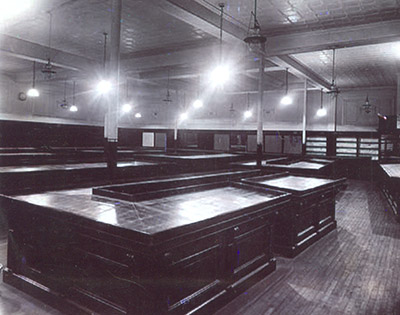 After a hot lunch, cooked onsite and given free until the first payday after opening, the girls were fortified for some "hands-on". The formula of "a day of two halves", relied on split-second timing. The tradesmen putting the finishing touches to the building began at 5am, getting the shop to themselves. By 1pm their day's work was done. In South Shields most headed down King Street to a nearby hostelry where they could wash away the dust and pervasive smell of varnish and feldspar (a wood cleaner and polish) with its natural predator - Newcastle Brown Ale! As they left, they wolf-whistled at the salesgirls' provocative chorus line dance towards the counters, about to be filled.
After a hot lunch, cooked onsite and given free until the first payday after opening, the girls were fortified for some "hands-on". The formula of "a day of two halves", relied on split-second timing. The tradesmen putting the finishing touches to the building began at 5am, getting the shop to themselves. By 1pm their day's work was done. In South Shields most headed down King Street to a nearby hostelry where they could wash away the dust and pervasive smell of varnish and feldspar (a wood cleaner and polish) with its natural predator - Newcastle Brown Ale! As they left, they wolf-whistled at the salesgirls' provocative chorus line dance towards the counters, about to be filled.
Products were neatly arranged into a honeycomb of glass dividers on the tabletops of the mahogany counters, which had been set-up to a detailed layout plan by the whistling shopfitters sent up from Manchester, and staying in digs nearby. When each slot was filled up, a tiny ticket had to be coaxed from a perforated sheet, showing the price. 1D (one old penny, approx. 0.4p), 2D, 2 for 3D, 3D EACH, or 6D were the most common, but there were variants that added "Per ¼ (Quarter Pound, approx 125g), Per Foot (approx. 0.3 metres), or Per Yard (0.9 metres). The very best, or most profitable, lines were given film star treatment, with much larger tickets measuring six inches wide by four inches tall (approx 14 x 10 cm), or for the walls, windows and near the entrances a 7in x 5in version (approx 17cm x 12cm). Many of the big tickets were illustrated and printed in full colour, leading stores to call the products "big ticket lines". The larger signs had to be slotted into metal frames, which were then clamped onto the glass, as defined in yet another rule.
For the week before opening the MD had sent a little surprise as Santa's little helper - none other than brother George, who was eighteen months into his time as a Learner. One new staff member quipped "Are all W Managers called Picot? Does the Buyer have them made in a factory somewhere, and insist each one looks the same?". Fred Woolworth had his reasons. He remembered the family connection to South Shields and thought it would be kind to both of the Picots, relieving the stress of the pre-opening, for sure, but actually George didn't quite have the same grasp of all the product detail that his brother had shown at Sutton, and would benefit from watching his sibling at work, if he was to pass "the test", opening the door to a store of his own.

Fred Woolworth, who had been driven North in his Rolls-Royce the night before, could scarcely make himself heard above the throng when he cut the ribbon to welcome half the world to "our finest red diamond yet". Takings beat all records, and the MD loved the store. Little did he know, after spending the whole day chatting with customers and soaking up the atmosphere, and stepped into the huge cabin of 'the motor' that store 104 would be one of his last openings. Already inside were Frank Picot and his key people. In keeping with his favourite tradition, he had invited them in for a fish and chip supper straight from their newspaper wrappings, which all would eat with their fingers, washed down with beer drunk straight from the bottle, perched on the sumptuous cream leather seats of the limo, which could seat eight in comfort. A fine time was had by all. Once again Fred had shown his legendary common touch, which he hoped would prove that he wasn't hampered by the airs and graces of some of his fellow Directors. His chauffeur knew the pattern well, but still appreciated it every time 'the chief' tossed him a gold sovereign once the revellers had departed, as "a little something" for restoring the vehicle, which was a prized, surprise gift from his cousin, the self-styled merchant prince Frank Winfield Woolworth, to celebrate Fred signing the lease for what would be the hundredth store in the British Isles at Mansfield, Nottinghamshire in 1919. The following morning, after a stop-over in a local hotel for both men, the Roller would be in tip-top condition for the long trip down the A1 home to Hampstead.
Woolworth's sales set a new record at Christmas 1921, with the year end inventory revealing a bumper profit. Shortly after announcing the results and pushing through the appointment of George Picot to manage Store 61 as his first store in Stoke Newington, North London, the MD was urgently summoned home to the USA. His mum was nearing the end, and it was time to say goodbye. He was sitting, holding her hand when she expired, and was relieved that her passing was peaceful and in the fullness of her years. Then suddenly, out-of-the-blue, soon after the funeral he suffered a severe, debilitating stroke. It took until the Autumn for him to rally enough to return to work. In London he was kept out of sight; his absence and illness had been kept a close-guarded secret. With great resolve he Chaired the Annual Review of results in January 1923, lavishing praise on one Frank Picot in his opening address to the Board of Directors. A fortnight later, he too passed away peacefully. One of his final edicts had related to the Picots. As he had arrived back, he promoted Frank to the helm of his beloved Clapham Junction store, bringing husband and wife back to London, with effect from late September.
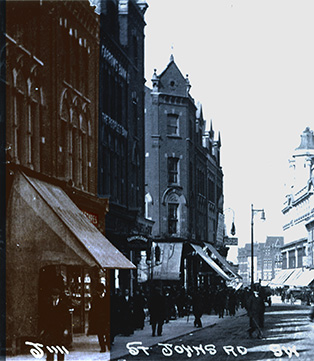
Every Woolworth Store closed immediately when the shock news broke of the sad death of the chain's beloved, Founding MD, Fred Moore Woolworth at the tender age of 51, and again for the whole day of his Funeral, Frank Picot was one of very few specially invited guests from the company that carried Fred's surname above the door, in keeping with instructions left with his Executor, his son Norman Bailey Woolworth. He carried the flag for 125 Store Managers and another 100 senior executives at headquarters who owed their careers, livelihoods and prosperity to their leader's cautious but decisive approach to establishing the Threepenny and Sixpenny Stores as the UK's favourite and most successful retailer.
A new era was about to begin, and Frank would have to sink or swim without the patronage of the firm's Founding MD and guiding light.
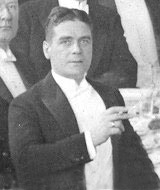 The new MD, elected unanimously by the Boards in London and New York, was an Englishman, William Lawrence Stephenson, the first non-American to take the helm. He had first worked with 'FW' fifteen years earlier, when serving as a Freight Clerk with the wholesaler Edward Owen and Co. in Birmingham. His diligence had impressed the Merchant Prince, as he progressed the huge orders of merchandise for the Five-and-Ten Syndicate. In 1909, he had invited Stephenson onboard to address British reservations about the 'Yankee Invasion'. The gruff Yorkshireman later boasted that he joined "on the ground floor" and had to work his way up. He hadn't hesitated for a second, and had passed the tough Director's examination that was required by law within twelve months.
The new MD, elected unanimously by the Boards in London and New York, was an Englishman, William Lawrence Stephenson, the first non-American to take the helm. He had first worked with 'FW' fifteen years earlier, when serving as a Freight Clerk with the wholesaler Edward Owen and Co. in Birmingham. His diligence had impressed the Merchant Prince, as he progressed the huge orders of merchandise for the Five-and-Ten Syndicate. In 1909, he had invited Stephenson onboard to address British reservations about the 'Yankee Invasion'. The gruff Yorkshireman later boasted that he joined "on the ground floor" and had to work his way up. He hadn't hesitated for a second, and had passed the tough Director's examination that was required by law within twelve months.
At times Stephenson had been frustrated by Fred Woolworth's caution, but he had always found him a good judge of people. He had favourites of his own, but was happy to accept his predecessor's judgement about Picot, particularly after visiting South Shields and hearing tall tales of his service at Tooting. He would keep a keen eye on progress at the flagship Clapham Junction store.
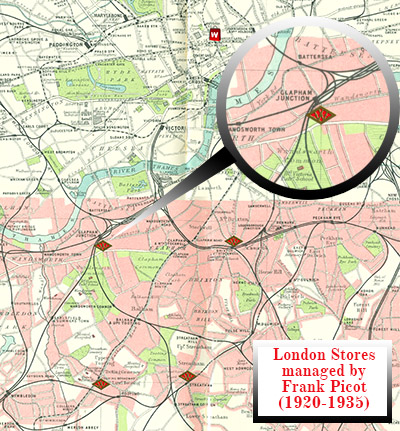
It must have been strange for Frank to take on a store already operating to his commuter store layout. The Superintendent Ernest Cox had applied the principles at both Wimbledon and St John's Road, Battersea in 1921 after they proved so effective in Mitcham Road, Tooting.
Clapham Junction was the ultimate commuter store. All the major railway lines into London from the south converged at the renowned station, making it the perfect spot to change service or switch onto a bus or tram for the final ten minutes into town. Thousands-a-day broke their journeys to nip to the iconic Arding and Hobbs Department store at the western end of St John's Road, with some heading to Woolworths diagonally opposite or M&S a few doors down. FWW was crammed into two very narrow, deep shop units which had been conjoined in 1913.
As the map above shows, Clapham Junction, Tooting and Streatham, the three London stores that Frank had managed, were close together in the bottom quadrant, giving the new man a head start. Store 34 was only a stone's throw from Brixton, where his youngest brother, 23-year-old Phil, would begin his mercantile career as a Learner in February 1923. His middle brother George had settled in well at Stoke Newington, to the north of Thames. It was also within easy striking distance of the chain's HQ, or Executive Office, in Kingsway, WC2 (top centre of the map, pinpointed by a shopping bag motif). The Junction's proximity to the main line station and its status as a class one superstore made it a favoured destination for the Buyers and other Executives to visit. The fast train service meant they could make the trip more quickly than walking along to Store 30 in Edgware Road, near Marble Arch. Frank often found himself with a full diary on Friday afternoons, but always free after 4.30pm as his visitors proved themselves to be poets, an acronym for pushing off early, tomorrow's Saturday!
The superstore brought challenges that Frank had not faced before. For the first time he had a substantial management team, with deputies and under-managers and several learners, as well as two office managers - one for cash and one for freight, a career stockroom manager and deputy and even a telephonist. The demarcation between the roles was clear and all worked hard, but each placed demands on their Store Manager, who could easily fill his week in a merry-go-round of meetings with them. The learners took the most time, and he believed could be used to drive through big changes in how the store was run, but only by rocking the boat. He planned to show them how every task should be done, and use them to train everyone else - whether junior to them, on the same level, or even one of their bosses. He knew there would be fireworks and that he would have to work hard to get everyone on-side.
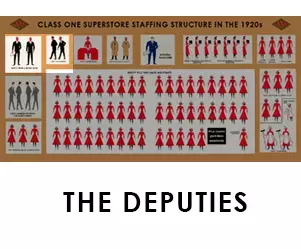 The first objections came from his Deputies and Floormen, who sent an Under Manager to articulate their grievances. They felt that by using the Learners Frank was bypassing the proper chain of command. To their surprise he agreed, but asked for their indulgence for a short time. Learning how to train people was an important part of being a learner, and having to tackle seniors as well as juniors would cement the learning more quickly. The store would benefit too, thanks to an absolutely consistent message to everyone, and the learners would lift some of the burden from the deputies. "Why have a dog and bark yourselves?", he asked. The Deputies agreed to suck it and see for a week or two.
The first objections came from his Deputies and Floormen, who sent an Under Manager to articulate their grievances. They felt that by using the Learners Frank was bypassing the proper chain of command. To their surprise he agreed, but asked for their indulgence for a short time. Learning how to train people was an important part of being a learner, and having to tackle seniors as well as juniors would cement the learning more quickly. The store would benefit too, thanks to an absolutely consistent message to everyone, and the learners would lift some of the burden from the deputies. "Why have a dog and bark yourselves?", he asked. The Deputies agreed to suck it and see for a week or two.
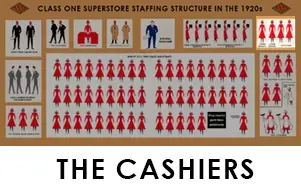 Next in-line to complain were the Office Managers. For the first time in living memory the First Cashier left the fortress of her office and headed for the salesfloor, asking for a few minutes of her Store Manager's time. For many years there had been an unwritten rule that learners were not allowed in the office, yet suddenly they were in and out all of the time. Their interruptions made it hard to count accurately and get the job done. Again, Frank asked if, as a special favour, the ladies would indulge him as he had an important mission, and he was convinced that after some short-term pain there would be a lot of long-term gain.
Next in-line to complain were the Office Managers. For the first time in living memory the First Cashier left the fortress of her office and headed for the salesfloor, asking for a few minutes of her Store Manager's time. For many years there had been an unwritten rule that learners were not allowed in the office, yet suddenly they were in and out all of the time. Their interruptions made it hard to count accurately and get the job done. Again, Frank asked if, as a special favour, the ladies would indulge him as he had an important mission, and he was convinced that after some short-term pain there would be a lot of long-term gain.
 He went on to explain that both the salesfloor and stockroom staff were failing to do some important parts of their job, instead dumping them onto the office when they were busy enough with their own work. Several pieces of store paperwork had to be completed straight away and in the post before the end of the day, making them the responsibility of the person who discovered the problem. For example Form 3 slip orders were essential to order any item that had run out, and an EO57 alerted the Buyer that one of his items was selling exceptionally well, which again was time critical. Similarly, TD3 and TD4 claim forms for delivery shortages had to be made within 24 hours or the supplier could reject them. There were too many people involved to train everyone, which is why Frank had decided the Learners should own the process. By completing the forms in the office, the store copies would be on-hand for the Freight Cashier to check against the following week's statements. He would remind the lads to keep the noise down and work neatly. If their knocking was a problem, he supposed he could issue keys, or perhaps they could be allocated a small space, like a dog's basket and could soon be 'house-trained'. The office team relented, accepting that with a bit of flexibility the dogsbodies would help them to avoid a lot of menial work.
He went on to explain that both the salesfloor and stockroom staff were failing to do some important parts of their job, instead dumping them onto the office when they were busy enough with their own work. Several pieces of store paperwork had to be completed straight away and in the post before the end of the day, making them the responsibility of the person who discovered the problem. For example Form 3 slip orders were essential to order any item that had run out, and an EO57 alerted the Buyer that one of his items was selling exceptionally well, which again was time critical. Similarly, TD3 and TD4 claim forms for delivery shortages had to be made within 24 hours or the supplier could reject them. There were too many people involved to train everyone, which is why Frank had decided the Learners should own the process. By completing the forms in the office, the store copies would be on-hand for the Freight Cashier to check against the following week's statements. He would remind the lads to keep the noise down and work neatly. If their knocking was a problem, he supposed he could issue keys, or perhaps they could be allocated a small space, like a dog's basket and could soon be 'house-trained'. The office team relented, accepting that with a bit of flexibility the dogsbodies would help them to avoid a lot of menial work.
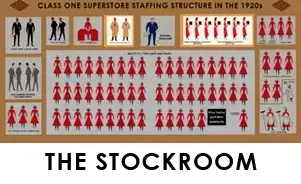 The Stockroom Manager had a lifetime's experience and thought it better to engage with Picot rather than shouting the odds, inviting him for a beer at lunchtime and taking the opportunity for a man-to-man chat. The old-timer quickly found the common ground that would help him to bond with his Manager. The two would later become life-long friends. Within half an hour he had understood that by simply sitting back and watching, the learners would reorganise the stockroom and make it easier to manage, without him or his team having to lift a finger. If things weren't better by the time they were finished he would be welcome to restore it to how it used to be, but going with the flow would probably do the trick.
The Stockroom Manager had a lifetime's experience and thought it better to engage with Picot rather than shouting the odds, inviting him for a beer at lunchtime and taking the opportunity for a man-to-man chat. The old-timer quickly found the common ground that would help him to bond with his Manager. The two would later become life-long friends. Within half an hour he had understood that by simply sitting back and watching, the learners would reorganise the stockroom and make it easier to manage, without him or his team having to lift a finger. If things weren't better by the time they were finished he would be welcome to restore it to how it used to be, but going with the flow would probably do the trick.
The following morning Frank went straight to his office and set to work, reading, signing and store-stamping a mound of papers that had appeared overnight. Before he had reached the bottom of the pile he was interrupted by a knock on the door. His Deputy just wanted to let he know that everything was ship-shape and ready for morning inspection. Asked if the learners would be joining them, the Number Two said, "No it's weird, They've got brown coats on and black faces. They're running round like coalmen moving boxes. Stranger still, out-of-the-blue Doris the Dragon, you know the chief cashier, only walked in with a pot of tea and a plate of biscuits for them. She must've felt sorry for them or something. She muttered something like , 'we've made a list, it's under the custard creams (only broken ones I'm afraid from Dept. 3). Tuck in boys.' And then she just marched out again, looking like the cat that had got the cream. What do you make of that?". Frank laughed and got up to head downstairs. Out of the corner of his eye he could see the stockroom boys, who were paid to move boxes, playing football in the yard. His answer was philosophical. "I'd say, we've won the battle, but the war's only just begun."
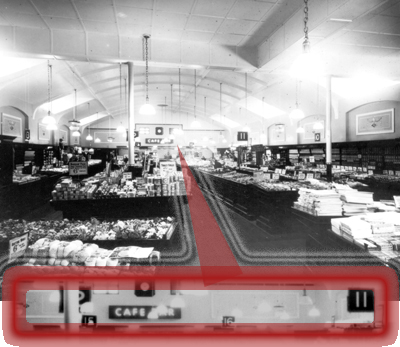 Steadily the availability of best-sellers on the counters improved. The regimented stockroom made items easier to find, while his continuous counts simplified the task of placing an order. The Merchandiser in the office had to calculate a stock commitment (anticipated sales for the next month based on the previous one, adjusted by season), and then subtract the stock on hand to work out what was needed. The quantity calculated would be rounded to the nearest pack-size from the supplier, and then a paper slip order would be written, which had to be countersigned by the Manager, Soon the process was running like a well-oiled machine.
Steadily the availability of best-sellers on the counters improved. The regimented stockroom made items easier to find, while his continuous counts simplified the task of placing an order. The Merchandiser in the office had to calculate a stock commitment (anticipated sales for the next month based on the previous one, adjusted by season), and then subtract the stock on hand to work out what was needed. The quantity calculated would be rounded to the nearest pack-size from the supplier, and then a paper slip order would be written, which had to be countersigned by the Manager, Soon the process was running like a well-oiled machine.
But improved availability alone would neither achieve his target commission nor impress the new MD, even with sharper service. He needed to get more people shopping the back of the store, and to treat themselves in the Café Bar on the back wall, which was often as quiet as the grave.
The problem was clear. In doing such a good job of maximising its income from commuters, the current layout had squeezed in so much near the doors at the front that no-one could see the back through the throng. Until mid-morning, for a spell at lunchtime and from mid-afternoon into the evening, the front of the store was packed. Getting past the crowd was virtually impossible. No wonder many customers didn't even know there was a cafeteria at the back. As a result, the catering offer had been eclipsed by Arding and Hobbs.
 The department store had been fully rebuilt after a disastrous fire in 1909. Its iconic premises included no less than three restaurants, an elegant silver-service dining room, a self-service café and a small snack bar. Its proximity to the station, coupled with prominent signs at the entrances had established it as most customers' favourite.
The department store had been fully rebuilt after a disastrous fire in 1909. Its iconic premises included no less than three restaurants, an elegant silver-service dining room, a self-service café and a small snack bar. Its proximity to the station, coupled with prominent signs at the entrances had established it as most customers' favourite.
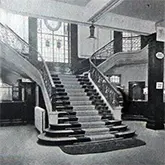
Frank checked out each of the facilities incognito, taking Doris the Dragon up the grand staircase to the 'Top of the Shop Battersea Lounge' for silver service luncheon. Second-time-around he stopped off at the middle floor with his Under Manager to take in the Self-Service Cafeteria. On the third trip he 'slummed it' with the learners, enjoying pie and mash in the Snack Bar near the main entrance in Lavender Hill (beside the tram in the streetside view on the right of the paragraph below this one).
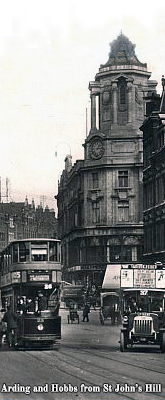
On the way back up St. John's Road he asked them to review the experience. All were agreed that the facilities were clean and well presented, the service was quick and attentive, if a little snooty, and the food was good, but the prices! Five shillings a head for a waitress service lunch, half-a-crown in the refreshment room, and also half-a-crown for little more than half a lunch - pie, mash, coffee - in the snack bar near the entrance.
All of the armchair critics agreed - Woolworth's needed to boast about its 3D and 6D prices! At its Café Bar every main meal was sixpence or less, with all the trimmings - vegetables, chips or potatoes, two slices of bread and butter, a choice of deserts, washed down with tea, coffee or a soft drink. Not one complete meal cost more than one shilling (5p then, £4.44 at today's prices). Put another way, switching to Woolworth's would reward Arding and Hobbs escapees with a saving of up to 80% compared with their previous outlay. Frank knew he would get a good return on the £1 he had invested to feed his key people;. If he played his cards right, it would pay him back a thousand times over within the year.
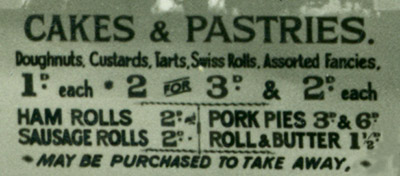 With the support of Superintendent Cox, and approval from MD Stephenson and his newly formed Board Operations Committee, he invested in a minor makeover. A signwriter hand-crafted banners for the side windows next to the entrance doors, and to go on the wall behind the Café Bar, showing the prices, and showcasing the handful of items, like pastries, that could be bought for just one penny. Everything would be made available to take away.
With the support of Superintendent Cox, and approval from MD Stephenson and his newly formed Board Operations Committee, he invested in a minor makeover. A signwriter hand-crafted banners for the side windows next to the entrance doors, and to go on the wall behind the Café Bar, showing the prices, and showcasing the handful of items, like pastries, that could be bought for just one penny. Everything would be made available to take away.
Decorators were paid to work over a weekend to remove the paint from the end wall of the store behind the food counters, replaster them and then add stylish glazed cream quarry tiles, with a maroon red relief pattern, topped with a trademark diamond 'W'. New elaborate, brightly-polished urns that had been designed to resemble Russian Samovars, were installed as a centrepiece, along with glass showcases for the cakes and pastries. To complete the new look, an extra row of incandescent lights, each fitted with an ultra-bright 200 watt sodium bulbs and new shades which appeared to match the rest, but had been engineered to cast their light onto the back wall. No-one would be oblivious to the store's lunch counter in the future!
Frank followed the changes through by having handbills printed, which were handed out with busy commuters' purchases in the morning rush, and dropped door-to-door in the local area. The changes worked liked magic. Hungry customers flocked to the back of the store, some choosing to eat but many taking their selections away with them in greaseproof paper and a waxed bag for later.
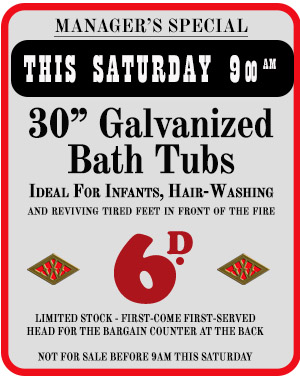 Another ruse to drive traffic to the back of the store drew on the friendships that Frank was striking with the Executive Office Buyers. He asked them to seek out special bargains on their factory visits, like cancelled orders from the West End stores, slight seconds or bin ends. He would pay cash and get the items out of the Supplier's way. "Simply send them to Clapham Junction Station and Frank will do the rest". A winner would be placed in the window on a Monday in front of sign saying limited stocks would be sold for sixpence on Saturday morning at 9AM, first-come first-served, from a bargain counter at the back of the shop.
Another ruse to drive traffic to the back of the store drew on the friendships that Frank was striking with the Executive Office Buyers. He asked them to seek out special bargains on their factory visits, like cancelled orders from the West End stores, slight seconds or bin ends. He would pay cash and get the items out of the Supplier's way. "Simply send them to Clapham Junction Station and Frank will do the rest". A winner would be placed in the window on a Monday in front of sign saying limited stocks would be sold for sixpence on Saturday morning at 9AM, first-come first-served, from a bargain counter at the back of the shop.
Early winners included large galvanized tin baths, fine silk Directoire Knickers 'from Knightsbridge', huge ceramic planters and fancy table and standard lights, some with tiffany shades, all for sixpence. At Easter Cadbury's supplied wonky half pound (200g) chocolate bars for 2D. The queue stopped the trams and buses in St. John's Road and St John's Hill, with traffic backed up all the way to Wandsworth. Six gross (864) sold out before elevensies, and three dozen more were sent to the Police Station as a peace-offering.
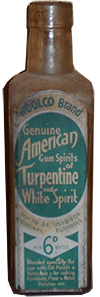
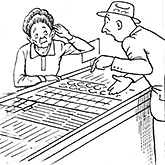
In a reversal of the rule for the front commuter displays, he requested just one, "dead slow and stop" assistant be assigned to serve bargains. Without fail a queue would soon snake around the back counters. As they waited many-a-customer would buy a couple of things at each display, "for the bottom drawer".
He believed the greatest potential came from the new houses and flats that were going up all round the area. The London County Council had embarked on a major scheme to build tenement flats South of the River in support of their "Homes For Heroes" obligations after the Great War, and to re-house people from the insanitary, cramped conditions of the East End slums, which would be pulled down. Private builders targeted well-to-do workers with more elegant apartments and rows of semi-detached and terraced houses with gardens, all around Clapham Common and Battersea Park. The easy commute and large green open spaces made the area first choice for many newly-weds with jobs in the City and West End. Frank aimed to attract all of this new blood to Woolworth's by creating displays specially for them.
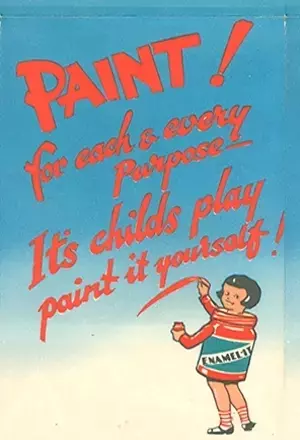
He worked with the Buyer for Department 30 Housewares to build a range of floor coverings, bath mats, drapes and net curtains, and with the Supremo of the pompously named Dept 25 ("Cabinet Makers' and Builders' Hardware") to assemble a selection of twenty tools, including screwdrivers, spanners, a gimlet, saws and a hammer which were supplied in a free large galvanized, cantilever toolbox for the princely sum of ten bob (50p), and sold dozens each week.
The best results were achieved alongside Dept. 25's Assistant Buyer, who was responsible for its Paints and Polishes section, a poet if ever there was one. He helped out with stylish, art deco leaflets promoting the new range of Woolco branded bakelite paints and varnishes from Donald Macpherson & Co., of Bury Lancashire, which were given bold displays. Every other Woolworth's sold a few of these each week "for touch-up and repair jobs about the home". At Clapham Junction the Learners were set to work evangelising the fine-art of pleasing "her indoors" by giving whole rooms, fireplaces, front gates and street doors a makeover. For newly-weds buying or renting their first home in a row of identical properties this was the perfect way of keeping ahead of the Joneses!
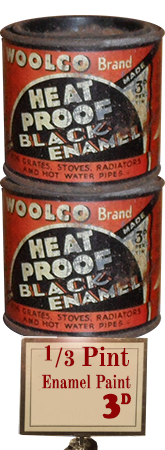 Despite the price of just threepence for a small or sixpence for a large tin, at Easter and in the Autumn when the clocks went back, sales peaked at over £100 a week - a staggering 6,000 assorted paints, brushes and glass bottles of American-style Turpentine Substitute!
Despite the price of just threepence for a small or sixpence for a large tin, at Easter and in the Autumn when the clocks went back, sales peaked at over £100 a week - a staggering 6,000 assorted paints, brushes and glass bottles of American-style Turpentine Substitute!
Frank considered all of these innovations to be sticking plasters. They worked around the real problem, covering over the open wound which was that not only was the store too small for the location, but its unusual shape made it very unsatisfactory for shopkeeper and shoppers alike, only amplified by the unusual and rather claustrophobic curved ceiling of the section that stretched deep behind the neighbouring shops. He believed that Clapham Junction needed to be extended and fully rebuilt to maximise the potential. But, he feared, persuading the powers-that-be to invest in such a project would be virtually impossible, now that Stephenson was at the helm. The new MD had embarked on a mass expansion programme, aiming to open 250 new outlets and trebling the size of the chain by the end of the decade. Word was that he planned huge freehold stores in Prime Shopping Streets, with the newspapers reporting that Woolworth's had acquired land in Oxford Street and Kensington High Street in London, and was negotiating for premises in The Strand, High Holborn and Tottenham Court Road. He had only approved two rebuilds or relocations of existing stores - No. 1 in Church Street Liverpool, to honour the passing of his friend Frank Woolworth, and No. 2 in Fishergate, Preston as a permanent memorial to the brilliance of his mentor and predecessor, the Founder's cousin Fred Moore Woolworth. He convinced himself that it would be worse to make the case and have it rejected than never to ask at all.
For fifteen months the new MD had left Frank alone. Supt. Cox had received praise at two Annual Reviews for the store's performance, and had passed on the Board's appreciation. As requested, on both occasions, he had made clear that Picot was happy where he was, newly married and would welcome more time at Clapham Junction, which had been readily accepted by the Chairman of the Meeting, abruptly bringing a round-table discussion about where he should go next to a halt. While the MD had insisted on reducing most Managers' excessive commission rates if they opted to stay put, for fear that it was the over-payment that was dampening their ambition, Frank's 12% was noted and endorsed by the top-man in both January 1923 and a year later.
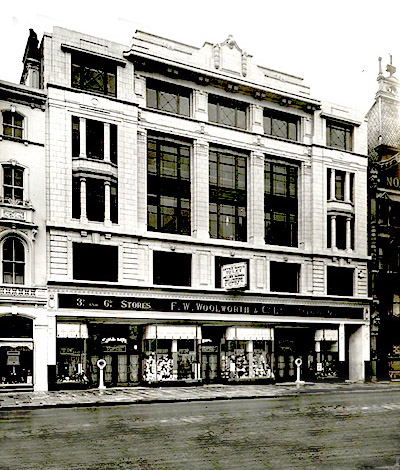
At the beginning of July 1924 Frank's steady routine was interrupted by a special request. Super-Cox revealed it had come from "the very top". Frank's Deputy was to step up as Pro-Tem at the Junction as an extended 'readiness test', releasing his boss for 'special duties'. The Superintendent of the neighbouring London Central District, Herbert Cue needed his unique skills to perfect the much-vaunted new flagship store, No. 161 in Oxford Street, W1, Britain's premier shopping spot. Frank's old chum Johnnie Whitell had been appointed Manager and was doing OK. But he had 250 people to train, and two salesfloors each larger than any existing store, which would stretch anyone.
Stephenson told Cue he was parachuting in Fred Woolworth's secret weapon, and sent Frank. The trouble-shooter had just one "simple" objective - to ensure that all press coverage about the opening was universally positive."
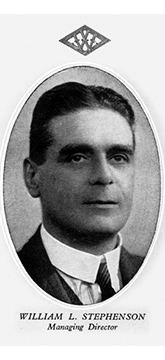 The MD later revealed that his own insecurity had driven the move. He was still building his credibility. He had made good progress with his principal investors, but the financial press was proving a harder nut to crack. His Northern accent seemed to be a barrier. He had cultivated a contact in Fleet Street, home of the British press, who had alerted him that several City Editors harboured doubts about his strategy. One had declared that "Stephenson is giving the 3 and 6 ideas above its station" and another had chipped in "we may need to bring him down before he ruins Fred Woolworth's legacy." The MD knew full well that Picot's mission was far from simple, and he was tying their fates together.
The MD later revealed that his own insecurity had driven the move. He was still building his credibility. He had made good progress with his principal investors, but the financial press was proving a harder nut to crack. His Northern accent seemed to be a barrier. He had cultivated a contact in Fleet Street, home of the British press, who had alerted him that several City Editors harboured doubts about his strategy. One had declared that "Stephenson is giving the 3 and 6 ideas above its station" and another had chipped in "we may need to bring him down before he ruins Fred Woolworth's legacy." The MD knew full well that Picot's mission was far from simple, and he was tying their fates together.
Before the opening Stephenson had been more circumspect in sharing his reasoning with Cue, explaining that the firm's bankers and financial backers would inevitably attend the opening. Probably so too would Gordon Selfridge, the General Managers of Debenham and Freebody, Harrods and the John Lewis partnership. He had heard that the Board of Marks & Spencer planned to attend en-masse. He feared that, with the exception of the financiers, all would like nothing better than to witness the MD "fall on his fat buttocks". He would be obliged if Cue, Whitell and Picot would focus their collective talents on "covering my arse".
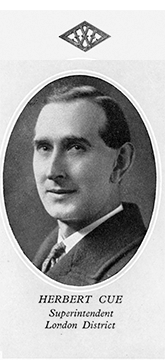
When Cue had enquired as to what skills Picot - for him an unknown commodity - would bring, the supremo had described him as 'our best salesman'. He would suggest tasking Whitell with managing the people, setting-up the staple merchandise displays and the systems and procedures needed behind the scenes, and empowering Frank to weave his magic with the product. Picot would work with the Buyers at EO to cram the store with as many Sixpenny Specials as they could muster. These would be displayed on leading ends near the entrance, on plinths in the main aisles and near the stairs, and would also be dotted around the cornices above the wall counters to create extra theatre in-store. Picot would have three weeks to ensure that the sales promotions, signage and marketing within the store were "the very best that Woolworth's has ever done".
Cue should get Picot to assist on the viewing day, Friday 19 July, mingling among the guests as a Company Executive. He should act as trouble-shooter on the first trading day, Saturday 20th doing everything within his power to make it "the best yet". But his most important task would be to field questions from "the Fourth Estate" (media). Before releasing Picot back to Clapham Junction, Cue should request sales reports for all the deals and promotions, and should "read, learn and inwardly digest", noting that "our late and lamented leader" considered Picot's sales reports to be "second-to-none".
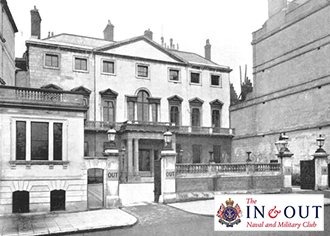 The opening could not have gone better. It was reported that the Managing Director glowed as he cut the ribbon to let the crowds inside for a preview, and spent the day grinning like a Cheshire cat. Even the sternest critic had to admit that "Stephenson has elevated the Bazaar business to an emporium where sixpence truly works wonders. Everyday necessities are complemented with extraordinary luxuries, which leave everyone wondering how ever can they sell that for a tanner?" Frank got a handshake, a pat on the back and after closing was whisked off to the 'In and Out Club' (Londoners' nickname for the Naval and Military Club in Piccadilly) for a pint of bitter and a whisky chaser, before tumbling home to bed. It seemed he had passed the MD's test with flying colours.
The opening could not have gone better. It was reported that the Managing Director glowed as he cut the ribbon to let the crowds inside for a preview, and spent the day grinning like a Cheshire cat. Even the sternest critic had to admit that "Stephenson has elevated the Bazaar business to an emporium where sixpence truly works wonders. Everyday necessities are complemented with extraordinary luxuries, which leave everyone wondering how ever can they sell that for a tanner?" Frank got a handshake, a pat on the back and after closing was whisked off to the 'In and Out Club' (Londoners' nickname for the Naval and Military Club in Piccadilly) for a pint of bitter and a whisky chaser, before tumbling home to bed. It seemed he had passed the MD's test with flying colours.
On his return Frank had found Clapham Junction looking amazing for a Monday. He had secretly hoped it would be a shambles, but by hook or by crook his Deputy had passed muster and would soon be off to pastures new. Picot would have to break in another. He turned his mind to which Learner was ready to step up, blessed that his regime - a veritable Manager Factory - afforded him a genuine choice.
That same morning, soon after he had arrived, there had been a tap at the door. It was the MD's Chauffeur with "a parcel for P. Co." Inside he had found a large box of finest Havana Cigars and a handwritten note on a printed postcard headed From William L. Stephenson, Managing Director, F.W. Woolworth & Co. Ltd. Threepenny and Sixpenny Stores, Victory House, Kingsway, WC.. The supremo had scribbled "Frank, I had these sent over from the Americans' new 5, 10 & 15¢ store in Havana, Cuba. Each cigar was a 15¢ special at store 1400's recent opening - the only way I could top your sixpenny specials. Thank-you. Bill.
Frank would soon be seeing Oxford Street again. As Summer turned to Autumn he received an invitation from Johnnie Whitell, with a short note stuffed inside. His workmate had scrawled a personal message on a piece of store letterhead paper, saying that he admitted he was showing off. He was inviting every Store Manager from London and the South East. and their wives or fiancées, to come and see his beautiful new store, and to be his guest at a full silver-service, five-course dinner which would be served in the Luxury Restaurant on the First Floor. It would be a grand affair, with everyone in 'a penguin suit or a cocktail dress, either will do!'
This was a break with tradition in many ways. There had never been such a large gathering of Store Managers. Traditionally social events were reserved for the Superintendents and those who had been elevated to Executive Office. Even these had been all-male affairs, with wives seeming to be invisible to the Company. Whitell had arranged a studio photographer from New Oxford Street, using apparatus normally reserved for secondary school panoramas, to record the event for posterity. One of those present (a 161 Learner moonlighting as a waiter, destined to be a Superintendent and Executive) very kindly gave the Museum the original, huge print, supplied mounted on stiff grey card with a greaseproof fly-leaf and an ornate cover. Mr and Mrs Frank Picot are near the centre of the image, just under half-way along and just over half-way back. (At the time of the dinner George Picot was managing the store in Exeter, the County Town of Devon (No. 151), and Phil was still a Learner, based at Store 7 Brixton.)
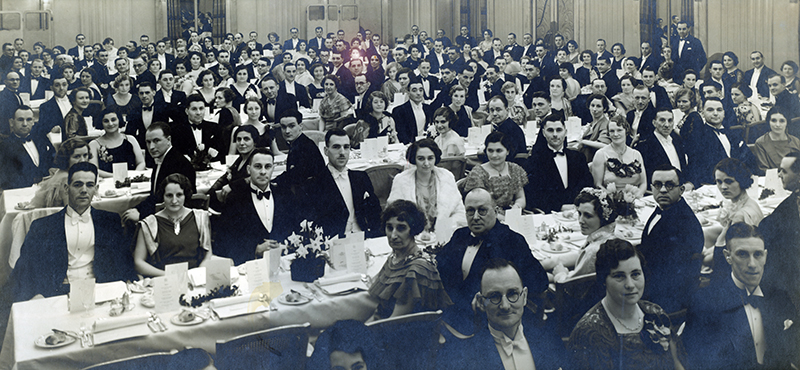
It was almost a year before his next encounter with the MD, which came out-of-the-blue, One Thursday afternoon early in May 1925, by which time life at Store 34 had settled into a familiar pattern, Frank was stopped in his tracks. He found that several Friday slots in his diary were marked 'WLS'. He called the telephonist, who handled the bookings, to his office to ask "What's this entry here?". Unaware, she explained that a very nice man from EO had called, asking to meet him and she had offered him an hour. Firmly but politely he had asked for three, back-to-back, and she had offered the first available. She had asked what name to record and he had received the reply "WLS, he'll know who that is", and after the usual pleasantries had rung off. Frank feared that he had made a terrible faux pas in not spotting this sooner and getting back to the MD with an infinitely more adaptable schedule. But the dye was cast.
A new suit, shirt and tie later, with quadruple Meltonian on the shoes, he paced the store until the allotted hour, quite unable to concentrate. A frenzy of dusting, floor-sweeping and facing up all around the salesfloor had given his empire a strange kind of aur a. Well ahead of schedule, after a last gasp and tossing his cigarette end into the gutter, William Stephenson had scarcely got through the side door when he bumped into Frank. After a warm handshake, the boss asked for ten minutes to do some shopping. Then he would find Frank in his office. "Still top of the stairs, second on the right opposite the bag room?" he asked, and after an affirmative reply added "Just as I planned then, over a decade ago.", reminding Frank that the MD had been with Woolworth's since before day one.
A quarter of an hour later there was a knock on Frank's office door, and the MD breezed in, beaming from ear to ear. "Someone has been burning the midnight oil, Mr Picot, I have rarely seen such shiny pitched pine (the floor of the shop) or such full, perfectly tidy counters. Anyone would think you had only opened the doors when my train pulled in to Platform 3. Anyway let's not stand on ceremony, I've brought you a little something." He produced a large document, sealed with wax and tied into a scroll with a ribbon. "Consider it an extra thank-you for your sixpenny wonders at 161 - I won't forget. I should tell you we don't give these out like confetti. You're only the tenth Store Manager to receive one in sixteen years of trading. So, please do me the honour of opening it."
Frank's jaw almost hit the floor as he gingerly unfurled the scroll and peeped inside. Embossed with the great seal of the enterprise, which he had never seen, and signed by the Company Secretary, who he had never met, and by its head honcho, who was eagerly looking over his shoulder, it was a Share Certificate, handing him ten of the five hundred Preference Shares that the Company had issued when it was launched. Its share capital consisted of 500 preference shares with a face value of £10 each, that gave a guaranteed return of 15% p.a. and 900,000 ordinary shares with a face value of one shilling (5p) which would return whatever dividend the Board decreed. Put another way, it proved he now owned 0.2% of British Woolworth. Its shares were changing hands for ten times par, making the gift worth around £1,000. Within 7 years, after the firm listed publicly in London in 1931, the preference shares became like gold dust, rocketing to 250 times their face value, giving Stephenson's 'little something' a net worth of £25,000, or £1,500,000 today. According to the Company's records, the shares were never cashed and remain in issue. Sadly their value evaporated when the Company fell into Administration in November 2008.
Uncharacteristically tongue-tied, Frank struggled to express his appreciation. Was there to be a sting in the tail? Overnight he had tossed and turned wondering what the notoriously single-minded MD's motives for visiting might be. He had feared that his commission rate, which the jungle drums suggested was set at twice the level now offered to Class One Store Managers, was in peril. But when Stephenson relaxed back into one of the two armchairs in the office and directed him to the other and to call him Bill rather than "Mr S-S-S-Stephenson" his ears pricked up. It was going to be a much more interesting, though equally challenging conversation.
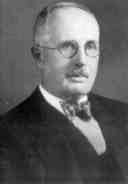 After a pre-amble reminiscing about his early dealings with Frank Winfield Woolworth, Stephenson told Frank of conversations with two of the Directors of the American Parent Company. He had recently returned from attending a Board Meeting in New York. The Company President, Hubert Parson, had waxed lyrical about a recent visit to examine the store that American newspapers had dubbed "the finest Woolworth's in the World" - their own 161 Oxford Street - and the amazing selection of merchandise that it offered for "10¢". It was so rare for Parson, an Accountant, to get so animated that he had whetted the appetite of his boss, Charles Sumner Woolworth. "Sum" had opened the second successful store in Scranton, Pennsylvania in 1880 and was still going strong as Chairman of the Board.
After a pre-amble reminiscing about his early dealings with Frank Winfield Woolworth, Stephenson told Frank of conversations with two of the Directors of the American Parent Company. He had recently returned from attending a Board Meeting in New York. The Company President, Hubert Parson, had waxed lyrical about a recent visit to examine the store that American newspapers had dubbed "the finest Woolworth's in the World" - their own 161 Oxford Street - and the amazing selection of merchandise that it offered for "10¢". It was so rare for Parson, an Accountant, to get so animated that he had whetted the appetite of his boss, Charles Sumner Woolworth. "Sum" had opened the second successful store in Scranton, Pennsylvania in 1880 and was still going strong as Chairman of the Board.
He had been the unanimous choice to replace his late brother back in 1919. He had a strong aversion to overseas travel and had not left the USA for many years. Yet by the end of the meeting he had arranged to join his London MD on the return sea-crossing to see "the wonder store" with his own eyes. He too had been taken aback, declaring "the infant has outgrown its parent, and fulfilled Frank's pipedream of showing "old Harry" (Gordon Selfridge, who he had met when the famous Yankee entrepreneur had been a mere Under Manager at the Marshall Field Department Store in Chicago, Illinois) how American retailing should be done in the "Mother Country".
Adopting a more sombre tone, the MD reflected on the passing of "our mutual friend and Commander-in-Chief, Fred Moore Woolworth". He had been admirer of his energy and enthusiasm, but had been obliged to watch from the touchline as "the old man" had burned himself out, on a gruelling and never-ending circuit of the growing chain of stores. As Frank could testify, Fred had valued the personal touch and reserved the three distinct roles of District Manager, Retail Operations Director and President in the USA personally. The consequence had been tragic - an early demise at fifty-one, looking older than cousin Frank, who had become increasingly indulgent at the dinner table as he reached old age, and yet had still lived past his sixty-seventh birthday. The MD observed that only one in three British Managers and Executives made it to claim their old age pension on their sixtieth birthday, and admitted this was a concern. But whatever his criticisms of his predecessor's leadership style, he had to admit that he had known all of his people, and had been an outstanding judge of character. For example he had noted not only that Frank was a fine salesman, a good leader and an excellent teacher, but also that he kept his own counsel and was totally discrete. Suddenly he looked up and stared into Frank's eyes and asked "can I rely on absolute secrecy in the conversation we are about to have, even from your wife and family?", prompting the assurance that he needed.
Over the next hour he spelt out major changes that he would be making to the organisation in the year to come, all with the aim of making the growing business easier to manage and self-sustaining. To add flesh to the bones he mused about where some of his pieces might land up on the new chessboard. He planned to adopt the three tier model favoured by the parent company, which now operated more than 1,500 stores across North America. They had been divided into 12 Districts of 125 outlets, each headed by a District Manager, In Great Britain initially there would be 2 Districts of roughly 100 stores. The DM would be supported, in descending order, by an Asst. District Manager, an Accountant, an 'EO Representative', a Construction Superintendent, a Traffic Manager, Three 'Merchandise Men', and six to eight Superintendents, whose role would continue unchanged, give-or-take their reporting lines. At least one District Manager would be on the Board of the Company as the de facto Retail Operations Director. Instead of communicating directly with the Buyers, Superintendents and Store Managers would liaise with the Merchandise Men, who would each have responsibility for a group of Departments. In the future the most successful of this group would be promoted to be the "EO Rep", based at Executive Office and representing the District's interests there full-time, drawing on the intelligence provided by the Merchandise Men. The Rep. would be "like the British Ambassador, representing H.M. the King in a foreign land.".
Reaching into the silk-lined pocket of his neatly pressed Saville Row suit, Stephenson pulled out a neatly folded piece of EO paper and tossed it like a glider to Frank. He had seen many such pages. As ever it was coloured blue to prevent copying and ultra-thin to keep postage costs down. But instead of the customary "GL A/S" code at the top, (General Letter All Stores,) or the traditional opening line "Recent store visits indicate ...", he found a typewritten diagram showing the structure that his new-found friend had described. On it Stephenson had scribbled some names. Superintendent Cox, Johnnie Whitell, and the Yankee Property Scout Louis Denempont all featured at the new District Office, while the softly-spoken London Central Super, Herbert Cue, would be elevated directly to EO as the District's representative there. More puzzling was the 'F. Picot' which appeared to have been appended as an afterthought at the bottom of the page.
Asked what he thought he replied, honestly, that they were all good men. "Even the name at the bottom?" asked the boss, but reply there was none. Stephenson would need to bait the hook a little more to get Picot to bite. "Let's talk about Frank Picot"
The Southern District would operate out of the brand new, and as yet unlet, floor of offices atop the Oxford Street store. Ernie (Superintendent Cox) deserved a larger role and would be appointed as Merchandise Man with responsibility for Depts. 1 and 2, 2a/2b and 4 (Sweets, Food, Restaurants and Tea Bars, Toiletries, Jewellery and Fancy Goods). This would be a development step en-route to becoming the District Manager of the mysterious District 3 which would be added later. Cox appeared to have the potential to become MD one day. Herbert Cue would be sent directly to EO, as he was the best all-rounder, and was already tentatively being considered for a Buying Portfolio. This would leave two vacancies for Superintendents, in London North and Central and London South.
The MD had thought long and hard about Frank's potential. Clearly he could do more, and his next logical step was to become a Superintendent. But if he took on Central London and other plans came to fruition he could land up managing his own brother, George, or if he took on South London, he would be Manager to the very people he had worked with and learned from, and might have to "administer the test" for brother Phil. Heaven forbid the boy could fail and he might have to boot him back to the stockroom or out of the door. The boss didn't want to shuffle the pack in moving another Superintendent, and felt that South London was the best option. Some workaround could be found for the 'Picot Minimus' situation. Frank knew London South like the back of his hand - each store, virtually every person, and was generally held in high regard there. It would not be hard to step up. Where might it lead? As an all-rounder it could be anywhere, but in Stephenson's opinion he would be wasted in Operations (as District Manager). Time and again he had demonstrated the rare ability to map out a new range, or re-purpose an old one, like Paints and Polishes, He had negotiated one of the best pay packages in the business with Executives far more challenging than any supplier. These were the ideal skills of a Buyer and a Buying Director, and the most prized in the organisation. To achieve this potential, Frank might have to take to "step backward to move forward", given that his pay in a Superstore exceeded his Superintendent's remuneration. But the most successful Buyer had cleared more than fifteen times his salary in 1924. Director packages were even more generous.
Stephenson was used to getting his own way, and was taken aback when Picot turned his offer down flat. The Store Manager confided that a decade earlier, shortly after the outbreak of the Great War, the British Army had tried to get him to accept a Commission when he was at Woolwich Arsenal. He had replied that he was born to be an enlisted man and proud to be a Sergeant. Even when his eldest brother John had put his civilian work as a Master Shipbuilder on hold to join the Regiment for the duration, and been Commissioned as a Lieutenant, his view had not changed. The same principle applied at Woolworth's. He valued the cut and thrust of Store Management; its daily traumas and kitchen sink dramas, and the reward of seeing the results of his decisions like a product promotion within hours of making them. He had got to know many of the Buyers and Superintendents, and had concluded that "driving a desk", or being a "Woolworth's Midshipman" - only half an Officer but no longer an enlisted man, smiling up and frowning down, forever at risk of losing his career if a couple of his men blotted their copybooks in the same year - was not for him. "Maybe that's wrong, I could be shooting myself in the foot, but there you have it."
After a long silence, Stephenson thanked him for his candour. While he did not agree, he respected the decision and the rationale for making it, which he considered honourable. He assured Frank that he had done himself "no harm at all" in their discussion. Perhaps to break the tension, the boss asked "if you're happy at the Junction, what can I do to help?" opening the door for Frank to suggest rebuilding and extending his store. To his surprise the answer was "yes, long overdue" and by the early evening the two had scoped out how this might be achieved. They had agreed that if what Frank wanted to do next was rebuild the southern pioneer stores one-by-one, acting as evangelist, planner/project manager and site foreman on top of his responsibilities as Store Manager, that had the potential to be a win-win. Stephenson could accelerate the pace of change, which at times was held back by the capacity of the Architects in the Planning Department to complete the budgets, worksheets and authorisation process before taking on oversight of any resulting construction work. Picot might lift the load at Store 34, and if successful at Clapham Junction could hand it over to another Manager and move on to the next branch nearby to repeat the process.
True to his word, on his return to Victory House on Monday, the MD had set the wheels in motion, demanding a series of actions from Executives which would create a veritable web of activity with Picot as the spider in the middle. The next eighteen months would test Frank to the limits of endurance and beyond. Sworn to keep the initiative a close-guarded secret from the store personnel and management, and even Ernie Cox, until everything was approved, and instructed to deal only with those Executives who Stephenson chose to bring inside the circle, he would have his work cut out. He told his telephonist to open up Thursdays in the diary, with two-hour slots, reserved for those who requested a longer time with him. Three days later he had a full schedule of unfamiliar names, assumed to be new Buyers, William Priddle 8am - actually the Company Architect, Archie Barton 10am - a Building Surveyor under assessment to be the South's first Construction Superintendent, and from noon for much of the afternoon a field trip with Louis Denempont, a more familiar name in-store, who had requested Frank's help with a competitor survey.
With remarkable skill, Priddle drew a sketch before Frank's eyes, using alternately a pencil and an India Rubber, until both men were happy with what the new building might look like. This was placed in an envelope and left for Barton, who in turn spent a considerable time looking at the drawing, asking questions and then scribbling numbers frantically into a pad. Once his list was complete he requested a few minutes' hush to tot them up. By the time "the Yankee" - Mr. Denempont - arrived at noon, Frank had the rudiments of a plan. He was able to show what his new emporium might look like, its dimensions internal and external, including the length of its island and wall counters, and even its runs of bins (bays of shelving in the stockroom), and a first estimate of the construction cost and occupancy charges once built.
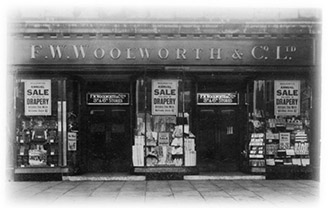 After snapping the existing store front "for the album" with his trusty Kodak - a prized possession brought from America on his last trip home - and a silver-service lunch at Arding and Hobbs, the affable, down-to-earth Louis took him on a whistlestop tour of the neighbourhood. He examined the shops next door very closely, trying to compute their likely sales and profitability, before seeking out every empty shop unit nearby.
After snapping the existing store front "for the album" with his trusty Kodak - a prized possession brought from America on his last trip home - and a silver-service lunch at Arding and Hobbs, the affable, down-to-earth Louis took him on a whistlestop tour of the neighbourhood. He examined the shops next door very closely, trying to compute their likely sales and profitability, before seeking out every empty shop unit nearby.
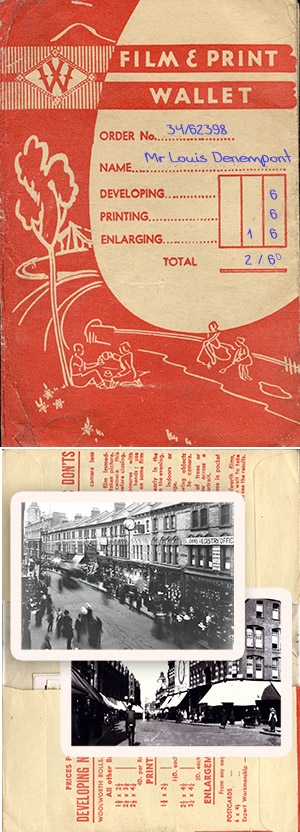
FWW would probably need to pay their neighbours to relocate. In Louis's experience a cash incentive and the promise of bigger, brighter, better premises nearby, fully-fitted courtesy of Woolworth's and either secured at a sweetheart rent, or as a freehold swap, normally did the trick. Skimming the pages of his trusty Bartholomew's Pocket Atlas and Guide to London, he noted the population of the District, Borough and surrounding area, telling his co-conspirator that he would need to increment these with up-to-date growth forecasts obtained from the Town Halls at Wandsworth and Lambeth. As no self-respecting competitor survey could pass it by, he finished the tour with a thorough inspection of the Marks and Spencer Bazaar, on the north side of St John's Road, towards " Arding & Arding & Arding & 'obbs" (a slogan coined to match the rhythm of a train crossing the points into the Station).
To complete his mission, after a pause for tea and pastries at Frank's Café Bar, and a lot more scribbling in his Office, the property guru tore out several sheets from his notebook as input for Frank's plan, and set out what he needed to do next. As Frank showed his guest out, he was left with two questions, had he bitten off more than he could chew, and how did the Yank stay so slender and energetic while packing in so much food?
Picot had built his career on regimented processes that he shaped for merchandising back in Sutton High Street, His rigour had persuaded Stephenson to back him. But the complex paperwork would be a stern test. The brains-trust had done half of the work, but future trade and expenses and ongoing running costs needed to be computed, and everything needed to be transcribed onto Stephenson's complex worksheets.
Over the years the MD had established a veritable production line for development projects, allowing initiatives to be compared and judged on their merits. If the process was followed and Stephenson liked the proposal, it should sail through the Boards in London and New York, and even survive examination in the New York District Court. The extra control had been enacted in the fall-out of a complex third-party real estate fraud perpetrated by the self-styled L.R. Nelson 5¢ & 10¢ Stores.
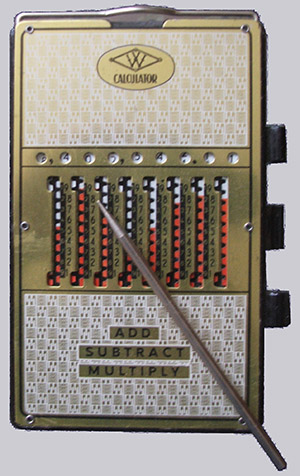 Using the input he had been given, ready reckoners and manuals from William Priddle's Planning Department, and his own in-depth knowledge of the store's finances, after spreading out the costs with interest over the next ten years ("capitalizing the work") he set about calculating the extra costs and benefits for each of the next ten years as a result of the building works. He had to show how much the rent and rates, fuel bills, wrappings and staff wages would be, along with charges for cleaning, running repairs and maintenance, along with the extra sales and profit that the extended branch would generate. He even had to estimate any positive or negative impact that the works might have on neighbouring branches, before recording all the details and his reasoning on Stephenson's paperwork. A project timetable provided the icing on the cake, dividing the work into stages.
Using the input he had been given, ready reckoners and manuals from William Priddle's Planning Department, and his own in-depth knowledge of the store's finances, after spreading out the costs with interest over the next ten years ("capitalizing the work") he set about calculating the extra costs and benefits for each of the next ten years as a result of the building works. He had to show how much the rent and rates, fuel bills, wrappings and staff wages would be, along with charges for cleaning, running repairs and maintenance, along with the extra sales and profit that the extended branch would generate. He even had to estimate any positive or negative impact that the works might have on neighbouring branches, before recording all the details and his reasoning on Stephenson's paperwork. A project timetable provided the icing on the cake, dividing the work into stages.
Frank was the first store manager ever to be trusted with task, which had traditionally been done by the plans under supervision from the District Manager or a Director. Stephenson laid the ground as a test of a possible way of accelerating the pace of change. Normally more than twenty people were involved in compiling a worksheet, several of them full time for a week or more. Frank had to juggle the task with running the store, keeping the tills jangling and the legendary tinkers from Mitcham Fair away from his precious merchandise. Yet somehow he managed to get everything done within a fortnight and checked, double-checked and checked again.
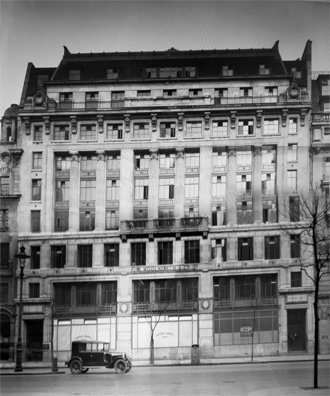 Proving that if he was a poet, he didn't even know it, at 4pm on a fateful Friday afternoon he donned an overcoat with a turned up collar, scarf and hat, and embarked on a Friday 4pm trip to "EO", the Company's headquarters in Kingsway. He crept in through the right hand tradesmen's door and slipped un-noticed up the stairs, turning right into the postroom at the top rather than following the directions to the Reception Desk. No-one looked up. He grunted "parcel for you mate" as he tossed his package into the post room "incoming basket" before turning tail and retreating from whence he came. A waiting game was to follow, which he feared might take months as his handiwork went under the magnifying glass.
Proving that if he was a poet, he didn't even know it, at 4pm on a fateful Friday afternoon he donned an overcoat with a turned up collar, scarf and hat, and embarked on a Friday 4pm trip to "EO", the Company's headquarters in Kingsway. He crept in through the right hand tradesmen's door and slipped un-noticed up the stairs, turning right into the postroom at the top rather than following the directions to the Reception Desk. No-one looked up. He grunted "parcel for you mate" as he tossed his package into the post room "incoming basket" before turning tail and retreating from whence he came. A waiting game was to follow, which he feared might take months as his handiwork went under the magnifying glass.
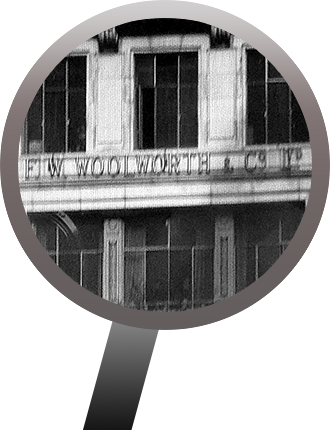
The answer came sooner than he could have hoped, and from an unexpected quarter. Seventeen days after his trip to town, as he shepherded the last customer out of the main door and slipped the key into the lock, he heard a distinctive tap, tap, tap on the glass which could only be made by the half crown (12½p coin) that Supt. Ernie Cox wielded to test the attentiveness of customer service during his formal Inspection Visits. Sure enough there he stood. "Get your Deputy to finish the lock-up tonight. Fetch your coat we're going down the pub. I'll get 'em in. See you in the Falcon in five minutes." Moments later as he hurried past Arding and Hobbs and made his way across St John's Hill to the Wenlock Brewery's Falcon Hotel on the opposite corner by the entrance to the station, his mind was racing. Ernie was many things, but no-one could describe him as either spontaneous or sociable! Whatever could the matter be to prompt an action that was so out of character, he wondered.
He found the boss tucked into an alcove in a quiet corner, with two pairs of pints neatly arranged on the table. His opening gambit was "Someone's been busy,", and followed through with "I've just met with WLS, he knows I'm here. He told me to say 'you can be totally Frank', and you will understand." As is the way when two people know a secret but cannot be sure it is the same one, neither wanted to show all of his cards. "He came to see me too, about a month ago". "Did he show you a blue piece of paper with typing and scribble on it?", "aha", "But your name wasn't crossed out until you were totally Frank?". So Ernie was in the loop. Before long Cox had shared news that he would be on his way up straight after the Annual Inventory, and after offering hearty congratulations Frank asked "But it won't stop you coming to my Grand Re-opening, if I have one?", obtaining two answers for the price of one question. "Yes I will be there, wouldn't miss it, and I'm here to tell you that you will be having one. I saw a large bundle of documents today, with one word rubber-stamped on the top page. That word - the best in Woolworth's .... A P P R O V E D .
Cox went on to provide a detailed update on the state of play. Stephenson had presented Frank's proposal, unchanged, to the Board Operations Committee late the previous afternoon, with just a four word pre-amble "Next, store thirty-four." His fellow Directors had skimmed over the figures, asked no questions and nodded in agreement, Breaking the unusual silence and lack of challenge, Denempont had observed "unusually neat and complete documents". Stephenson had muttered "Indeed" as he wetted the stamp in a pad of red ink, before bringing it down with a flourish on the bundle of documents at the top of his pile. Before meeting with Cox, he had spoken by transatlantic telephone with his friend Byron Miller in New York. Miller, a fellow Founding Director of the British Company, had been recalled to headquarters in 1919 and now headed 'Overseas Operations' - supervising the British, German and Cuban subsidiaries as a development step as Vice President and President-Elect of the giant Corporation. The magnate had confirmed that 'The Store 34 Scheme' was non-controversial - he knew the shortcomings of the building all too well. Work could proceed; approval both in the Board Room and in Court would come, "as sure as night follows day". So all Frank had to do was deliver the huge redevelopment on-time, on-budget and on-target, to the plan he had set himself. Cox would do all he could to get him off to a good start during his final six months as a Superintendent.
With that, both men downed a well deserved pint of Wenlock's Best in one, and moved on to the next. Each had something to celebrate, and much to discuss.
Cox was a thinker and a planner, who always liked to say several steps ahead. On his way back from town he had already compiled a to-do list of things he must address before moving on, and started on another for what he dubbed the "brick by brick (or BBB) " project at Store 34. At the top of his list of worries was a Picot, but not the one he was sharing a quart with. Phil was in danger of becoming the oldest learner in town. He had only survived because the Supt. had acted as his corner man. His Manager at 7 Brixton was Albert Clement Truscott, a hard task-master with a sharp tongue, known for running a tight ship. To his bosses he was a "true gent.". But when it came to learners he was far from genteel. He had given each of his cohort a nickname, drawn from his favourite author, Charles Dickens. There was Oliver, who always wanted more work and more recognition, Artful his opposite in every way who dodged anything too arduous, and there was Pickwick who spread papers everywhere and couldn't do alphabetical order when tidying them up. And then, there was Mr Bumble - so frightfully nice. so thoughtful with everyone .... and - in his opinion - so utterly useless. Truscott had penned a little ditty and revelled in sharing it with "the man-boy", who seemed to find it highly amusing:
- I fumble as I bumble, my stock bin's full of jumble, when challenged I just mumble, 'what's wrong with being humble?'
"Amused? A man-man would have been positively apoplectic!" ranted Truscott, "He simply didn't get it. I was forced to append 'He's heading for a tumble, and still he wouldn't grumble'!!"
The Super's diagnosis was that toughening up was needed, the Doctor to administer it should be Frank - just as he had done with George in 1921 - and the medicine could be administered under the auspices of "BBB". It might be awkward, but BBB was going to involve a lot of donkey work, much of it at night and well-suited to learners and casual labour.
Frank admitted that, since getting married and his year in the frozen North, he had been pre-occupied with making his mark at the Junction. Given the shape of the store's back ceiling, which had occupied his every spare waking minute for months, this was a true case of tunnel vision. But Ernie's plan was sound, he trusted Phil and wasn't awkward about it at all. It would look wrong for 'the runt of the litter' to transfer down to Clapham, but he could help out for extended periods, or follow other learners in moonlighting for overtime pay in a second store. That was settled.
There was no playbook when it came to the BBB project. A phone around had not revealed a single similar project. Bruce Campbell Donaldson, the Scottish Construction Superintendent for the whole British Isles, who seemed to have put down roots in North West England since WLS had come to power, entirely focused on his British Cathedral of Sixpenny Commerce in Church Street, Liverpool (Store 1, mark 2, opened in 1923), before moving straight on to Fishergate in Preston, Lancs (Store 2, mark 2, which followed in 1924). Both had been pet projects for the new MD, dedicated to the memory of Frank and Fred Woolworth respectively. Although one-for-one replacements and enlargements of an existing store, both had involved constructing a new building nearby, and once complete doing a flip across or down the street. According to BCD's ABC of all things Woolworth, extensions had been appended to other stores - like a restaurant above Store 80 in Bromley High Street, or an extension of the sales area in Cardiff (Store 25 in 1914) - but all had involved knocking through to the new area or stairwell between Saturday night and Monday morning, putting dust-sheets or hinged plywood over the hole, and gradually preparing and filling the new space until it was ready for a grand re-opening. No-one had challenged the concept of a re-opening after only closing as usual the previous day. Frank's plan for Clapham Junction was a first for the UK, although the Americans claimed to have done something similar but were very vague on the details. Evidently theirs had been a five steps forward and four steps back kind of project. Cox and the Picots would have to carve out a new way, ideally consisting of five steps forward and no steps back. This would guarantee completion on-time and in-budget.
Frank was pleased to report that the new man, Archie Barton, who appeared to be as keen as mustard to impress, had a bundle of plans pre-prepared and had promised to send them down special delivery as soon as he got word that the proposal was approved. With luck, given the news, a large, brown P & C envelope would arrive on Monday. After agreeing to meet first thing on Tuesday, they sat back to enjoy the second half before making tracks. Each had good news to share with his wife when he got home.
While Frank had been doing the figurework and mastering the MD's fiendish array of project proposal forms, with help from the in-house team of Architects and Planners, young Barton had mastered their new technology and had transformed William Priddle's sketch and a draft of Frank's timetable into a set of annotated drawings. He was able to print copies on their new-fangled machine, and, true to his word, rushed the first copy down to Clapham Junction. Moments after it arrived, Frank had gingerly cut a slit in the flap with his trusty 'W' letter opener, to reveal what was inside. Somehow the new art deco frontage looked even more stunning, and the timetable much more stretching. But he had no doubt that he could do it, and would be proud of the result.
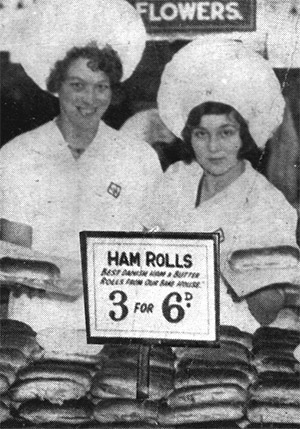
Before 7am the next day, Frank and Ernie perched themselves on stools at the Café Bar. At the far end cook was busily slicing his way through trays of freshly baked bread rolls, straight from the oven, while two of his juniors were buttering away and sprinkling in shredded ham, topped with a teaspoon of pickle. Another finished glory, in a greaseproof bag from a dispenser, seemed to drop into a wicker basket every few seconds. Within the hour most would be in the briefcases or knapsacks of commuters heading to work, leaving the front till crammed with sixpences.
Responding to a call from the cook, with all the waitering skills of a rampaging Indian elephant, the kitchen porter brought the two bosses hot tea, a rack of buttered toast and a huge half-empty industrial bucket of marmalade with a large decanting ladle resting inside. Frank reached over the counter, and plucked two white china plates, knives and 'W' paper serviettes from the understocks, without even needing to look. None of the catering team showed the least interest in what the two suits were discussing so intently. They would know soon enough.
The Superintendent was taken aback at the quality of the paperwork, observing that Frank plus Archie seemed to be a winning combination. It seemed there would be three main pinch-points. The first, straight after Christmas, would be the challenge of emptying the stockroom and, so far as possible, the ancillary accommodation behind the scenes. This would be a chance for Phil to hone his skills. The fast-movers, most fragile and bulkiest items would need to be separated, and lumbered out to new sheds which were to be erected at the back of the building site next door once it had been cleared. Picot Junior could identify and list the lines, check them out and in again, while casuals could effect the transfer using trollies and sack barrows. Watchmen would be required to guard the sheds round the clock, as they would be vulnerable to break-ins and pilferage, with so many contractors on-site doing the groundwork. Phil would soon get used to bossing them around. He would also need to ship the slower items to a space which had been secured at the Granary Co-operative Warehouse - a joint venture by all Woolworth Store Managers which was nominally financed from their commission - at the L,M&S St Pancras Goods Station in King's Road, NW1. Again Phil would need to document the stock movement, ensuring that everything was put away neatly on the shelves provided, and devise a way for the store to draw on the reserves, with a horse and cart ferrying goods back down to Battersea every two or three days.
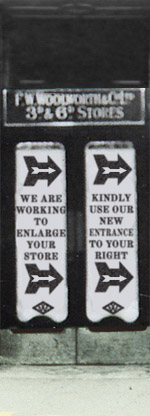
 The second, arguably most demanding challenge would be "the flip", when every counter would need to be emptied into trollies and baskets, dragged into the new extension and sited at the precise spot on the masterplan, before getting a spit and polish and being filled back up again. Each store across Cox's District would provide at least one person to assist, with Croydon, Brixton, Bromley and Walworth Road lending at least three. With Frank's guiding hand, Phil could direct the operation, which could be smoothed by also allowing him to dispense bonuses, anything from half-a-crown to a crisp £1 note for the very best work, (between £5 and £40 at today's prices) pour encourager les autres. The project plan included a hefty £1,000 for cash payments to casual labour over the course of the 17-month project, to be signed for by the Manager and kept separate from the store cash. With careful planning the two Picots could thin the store out, moving the counters of slower-moving goods, nearly all of the understocks (goods held in cupboards underneath the counters, ready to go on sale), and perhaps half the stock on display between the glass dividers before "the flip", which would have to be done between closing an hour or two early on Saturday afternoon, and unlocking the new doors at 8am on Monday. There would be little or no time for sleeping that weekend.
The second, arguably most demanding challenge would be "the flip", when every counter would need to be emptied into trollies and baskets, dragged into the new extension and sited at the precise spot on the masterplan, before getting a spit and polish and being filled back up again. Each store across Cox's District would provide at least one person to assist, with Croydon, Brixton, Bromley and Walworth Road lending at least three. With Frank's guiding hand, Phil could direct the operation, which could be smoothed by also allowing him to dispense bonuses, anything from half-a-crown to a crisp £1 note for the very best work, (between £5 and £40 at today's prices) pour encourager les autres. The project plan included a hefty £1,000 for cash payments to casual labour over the course of the 17-month project, to be signed for by the Manager and kept separate from the store cash. With careful planning the two Picots could thin the store out, moving the counters of slower-moving goods, nearly all of the understocks (goods held in cupboards underneath the counters, ready to go on sale), and perhaps half the stock on display between the glass dividers before "the flip", which would have to be done between closing an hour or two early on Saturday afternoon, and unlocking the new doors at 8am on Monday. There would be little or no time for sleeping that weekend.
The final hurdle would be re-arranging everything once phase two of the building work - replacing the original sales area - was complete, and the two halves of the new premises were joined up. Again most of the work could be done out of hours. With the luxury of more space and new fixtures, duplicates could be made of the prime displays in the stage two part of the building. But still a huge push, again backed by support from across the District would be required in the six days before the Grand Re-opening, which would take place at 2.30pm on Friday afternoon. 23 October, 1926, Between 4pm on Thursday 22 and 11am on the big day, most items would need to be moved and every counter would be relaid and ticketed; this would leave two hours for a store-wide Spring clean, and an hour for a pep talk and a little celebration for everyone who had worked on the project, before they put on their best clean uniforms or suits and stood attentively waiting to greet the MD and the throng of VIPs and local people who would no doubt attend the preview. This great push for completion would require all hands, and would be the acid test of the project. If it was a success, and Frank confirmed that Phil had played his part to the required standard, his brother would be rewarded with a store of his own when the right one came up in 1927. And Frank would soon be despatched to the next superstore, ready to start the whole cycle again from the beginning.
Days later, when work commenced, it followed the pattern that the two men had predicted over toast and marmalade surprisingly closely. There was an exception, consisting of swings and roundabouts. Louis Denempont had excelled in his negotiations over the neighbouring properties. The landlord had proved surprisingly obliging. One neighbour was hoping to retire, and would jump at some cash for a pension, another was looking for any way out as he seemed incapable of making a profit and would love to be released from his tenancy agreement. Only the third had a viable business, and the landlord could accommodate him in another of his shop units which was due to vacate at the end of the month. £500 from Woolworth's, which he would share 'as appropriate', could secure vacant possession of the full frontage within four weeks, at a very competitive fixed rental of £3,900 p.a. until 2034, payable on the same days as the £900 lease on the existing portion, which would remain fixed until 1994. But there was a catch. He could sell them the freehold of the ground that lay behind the new frontage, which included a wide alleyway to the left of the existing Woolworth's store as a bonus, for £4,750. But it would come with a Restrictive Covenant and solemn undertaking not to build on a portion of the land until 1934. This had been agreed to keep it clear for a planned future scheme of sewer reconstruction beneath, essential if the Borough's population was to continue to grow as predicted. Until the work was complete - or the date passed - the new shop would have to be twelve feet shorter at the back. Frank, Archie and the powers-that-be at Executive Office all declared themselves fully satisfied with the terms. Mr. Denempont was to be commended for getting the project off to a flying start with a substantial saving against the budget, while securing easy access to the rear of the property, permission to erect sheds and other temporary structures, and a substantial further development opportunity for the future. It was full steam ahead.
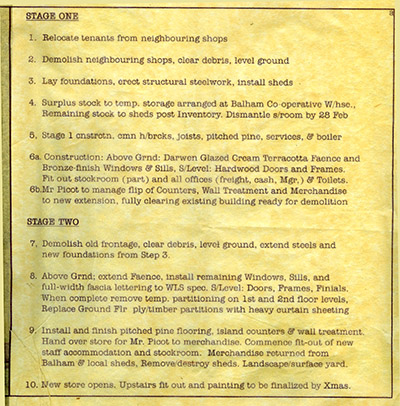
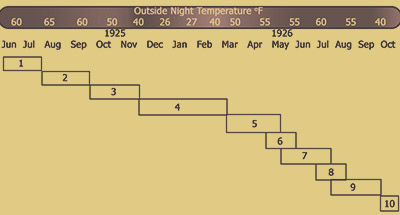
The timetable for major projects was driven by the night-time temperature. If frost was forecast, cement foundations could not be poured and bricks could not be laid. Holidays were forbidden for most employees in the final 'Golden' quarter of the year, but the Construction Team were the exception. They would be expected to work round the clock when the sun was shining as bosses sprinkled overtime to keep projects on-time.
The new store would be built in two halves - first the extension, replacing the neighbouring properties to the right of the existing building. Then the Manager would have to "do a flip" dragging all of the counters, merchandise and paraphernalia from the old store to the new, which would trade temporarily in a bubble straight inside the entrance. The side and back walls, which were yet to be plastered would be screened off with heavy curtains. Customers would have to run the gauntlet of navigating scaffolding and builders' wagons to get inside, before mastering its revised layout. Store personnel were assigned to a never-ending round of cleaning to try to control the dust, but could do nothing about the noise of the old store being knocked down with a crane, ball and chain just on the other side of the curtains. This would endure for several weeks until the final section of the new building was bolted onto the extension.
With one exception all store personnel were banned from crossing the threshold between the temporary store and the building site next door. Site Manager Frank Picot was centre stage. Only he worked on both sides of the curtain. On the left he had to oversee a frenzy of construction activity Q: "Where shall I stick this, guvna (governor)?", A: "I could tell you", before slipping back to face his public on the right hand side, and addressing a never-ending stream of questions from customers and staff alike. Every one seemed to begin with the words "Where is ....?". Some of the answers might raise an eyebrow today.
- Q "Where is the Toilet?" A: "Counter No. 22, madam, see the sign, the whole department has had to move from the entrance to the middle of the shop, just while the work is going on." (To 1920s shoppers 'The Toilet' meant The Toiletries Counter. A girl serving on it was said to be "on the toilet"!).
- Q "Where are your footsocks?" A: "Counter 11, it's down the back at the moment, if you mean in-soles" drawing the common retort "(something that sounded like) and our souls to you too!"
- Q "Has your pet department got any canaries?" A: "I'm afraid they just fly out as soon as they come in!" Q "How about tortoises then?" A: "Oh yes, sir, they're very slow and never run out."
- Q "Is it true that Woolworth's sell horse's heads?" A: "Sure do. Counter No. 30, ask for a sixpenny horse's head handle (the finest that Woolworth's could sell)"
- Q "Do you sell smells?" A: "Yep, Counter 22, just ask for odour toilet (Blue Waltz eau de toilette)!"
- Q "Do you really sell gramophone records for a tanner?" A: "Yes, counter No. 7 in the Fancy Goods, Little Marvels they are."
- Frank's favourite, later often recounted as a party piece, was Q "D'ya sell earplugs in this dump?" A: "Pardon?" (strangely they seemed to sell out each day during the quarter hour allowed for staff purchases before the doors opened! Frank and his Under Managers could honestly say they had heard no complaints all morning.)
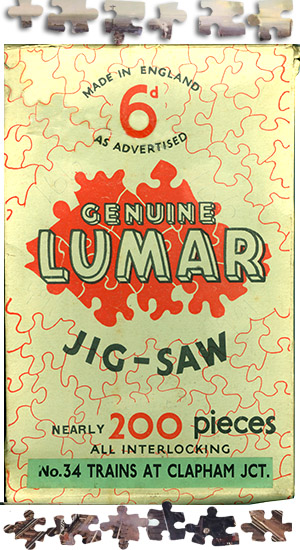
Gradually the pieces of the puzzle came together.
Unlike the store's popular sixpenny Lumar Jigsaws, the Picot version at least had a picture on the lid. Even before the walls were revealed and the finishing touches were added, the new sales area was magnificent. It was bright, spacious and (on the rare occasions when the dust was given time to settle) airy too. Customers were impressed by its sleek, uncluttered layout and by the 'new' counters, unaware that they were the self-same ones from next door re-invigorated with a coat of Woolco's wonderful Bakelite Varnish, with glass dividers and clips shining thanks to the bright, new lamps above.
Frank's greatest satisfaction was how quickly brother Phil had found his feet. Without constant sniping from more senior Learners to undermine his authority, deemed banter, but with sinister tones of bullying that would have shocked their Manager, Albert Truscott, that his nickname and rhyme might be to blame. Junior had taken command. Frank's coaching had helped. He had shared a top-tip that he had picked up when a Sergeant in the Army Ordnance Corps:
- "Never shout when you're boiling with rage; bite your tongue and avoid making a fool of yourself. Bide your time and pick your moment for a bit of play-acting. Plan a tantrum, make it hurt, throw things about. Shout. But make clear what you expect. Then walk away. When you return, everyone will be keen to please."
It a took a while, but Phil proved that the message had been received and understood. One morning the store was a-buzz with tales of daring-do, which the night watchmen had shared. Huddles of girls on the stairs and in the bag room were giggling in hushed tones, as they acted out a scene from the power-play drama that had unfolded overnight after they had gone home. 'P2' had faced the awkward squad of Learners - "the glorified stock boys who think they're management" - sent down from Brixton and Croydon. They had singularly failed to do any of the tasks he had assigned. Instead they had larked around, making mayhem in the stockroom. He had marched in and grabbed their attention by plucking a crisp 'Bradbury' (£1 bank note, worth almost as much as a £50 note or $100 bill today) out of his wallet, and cigarette lighter from a side pocket. Very deliberately he had proceeded to set the note alight in the top-right corner and had watched as it burned down to his fingers at the bottom-left corner, catching the embers in his other hand. After stamping out the stub on the wooden floor he had uttered four words and walked out, rendering his wayward chain-gang utterly speechless. Those four words "there goes your bonus". (For advanced learners £1 was a week's wages, new starters would have to stretch that sum out for a fortnight.)
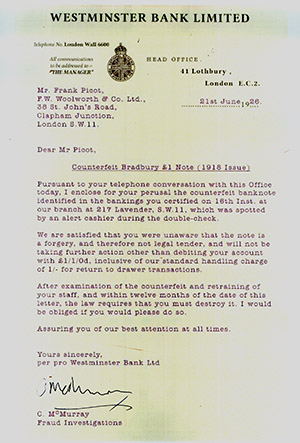 By midnight all of their tasks had been completed, and by 4am the stockroom had been transformed. They had boxed every one of the 'to keep' items and wheeled stack after stack of boxes out to the sheds. They had found their path ingeniously illuminated by a tidy row of oil lamps, which had been lit by the same tinderbox and the same man who had managed to take their breath away. P2 duly dispersed a pile of half-crowns (coins each worth one-eighth of £1) from a cloth bag, and would never face their flack again.
By midnight all of their tasks had been completed, and by 4am the stockroom had been transformed. They had boxed every one of the 'to keep' items and wheeled stack after stack of boxes out to the sheds. They had found their path ingeniously illuminated by a tidy row of oil lamps, which had been lit by the same tinderbox and the same man who had managed to take their breath away. P2 duly dispersed a pile of half-crowns (coins each worth one-eighth of £1) from a cloth bag, and would never face their flack again.
Frank could have added one more line to the escapade. Now he knew why little-bro had asked if he could have the 'snide oncer' (counterfeit pound note) that had been returned with an angry letter by the Westminster Bank! Waste not, want not. Clearly the Picot gene pool was a force to be reckoned with. Phil was on a roll.
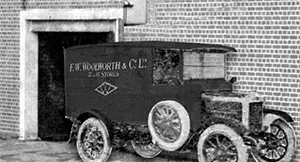 With help from Supt. Cox he had devised a clever way of shifting the slow sellers to and from the Co-operative Warehouse. He had blagged a Morris One-ton Wagon from the Traffic Department at Executive Office.
With help from Supt. Cox he had devised a clever way of shifting the slow sellers to and from the Co-operative Warehouse. He had blagged a Morris One-ton Wagon from the Traffic Department at Executive Office.
The vehicle was on an extended evaluation loan, arranged by F. Kenning & Co., the leading main dealer for Morris Group. They had offered the facility to sweeten a contract for other vehicles, on the condition that Woolworth's could be mentioned in marketing materials. They boasted that it had the largest load capacity in its class, and much lower running costs than a horse and cart!
Phil would take the wheel for the short trips back and forth, and had persuaded his Store Manager, Mr, Truscott, to pick up the tab. He had leapt at his long-serving Learner's offer to include a stop-over at 7 Brixton in his itinerary, easing the knotty problem that had arisen since most of the store's stockroom had been transformed into a galleried upper salesfloor. In the eyes of his boss he had morphed from useless to useful, and would never be called Mr Bumble again.
Fearing that his brother would not approve, Phil kept news of the new vehicle to himself until it was handed over. He drove it down to Clapham Junction and backed in through the gate in Severus Road, parking up at the new loading dock which had just been completed. En-route from town he had stopped off at a garage to give the maroon coachwork a wipe down and had buffed it to a bright shine with a tin of 'W' sixpenny polish. Stood in the winter sunshine it looked magnificent. Finally it was time to face the music, and introduce Frank to his new acquisition. "Sorry to interrupt, em er there's something you should see out the back." Frank would later recall that this was the second time that Phil had rendered someone speechless at Store 34. He loved it and found it hard to believe that his brother had not only made it happen, but done so without spending a halfpenny from the budget. No wonder old 'bert Truscott was impressed - quite right too, he should be.
With two Picots at the helm, each seemingly on his 'A Game', the project appeared to be running on gas - but was it coal or mustard ? The fit-out and preparations for re-opening went without a hitch. Frank was so pre-occupied with making sure that everything was 'just-so', and so pleased with the look and feel of the place as each part was completed, that he barely noticed that his "old trouble" was back and getting worse.
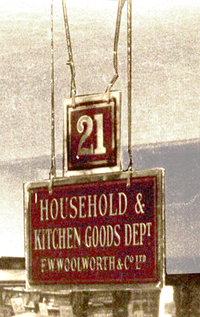
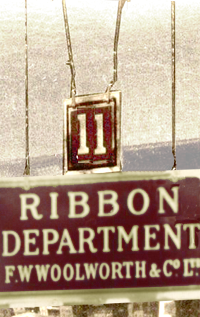 He was coughing in the mornings, and occasionally had to cover when physical exertion left him winded and struggling for breath. It soon passed. He had long forgotten the words of the M.O. who had signed his honourable discharge papers from the R.A.O.C. And he had never stopped to wonder why the regiment had awarded him a full pension at twenty-six years of age, which they sent to his Bank each month.
He was coughing in the mornings, and occasionally had to cover when physical exertion left him winded and struggling for breath. It soon passed. He had long forgotten the words of the M.O. who had signed his honourable discharge papers from the R.A.O.C. And he had never stopped to wonder why the regiment had awarded him a full pension at twenty-six years of age, which they sent to his Bank each month.
In 1919, faced with an epidemic of cases, the quacks knew that those repeatedly exposed to mustard gas in the trenches would have to face a lifelong battle in civvy street too, and should avoid dusty environments at all costs.
Yet Frank, oblivious to the risks, had painstakingly carved a niche for himself that would see him move from one building site to the next. As site foreman he would inhale dust, industrial solvents and all manner of chemical nasties. In parallel, as General Manager of a Superstore undergoing a major redevelopment, he would face a different though equally potent array of toxins. These included many years' accumulation of dust and dirt behind wall shelves and cladding, and solvents used to burn through the thick coats of noxious Feldspar floor oil that stuck skirting boards and rails at the base of the mahogany counters tightly to the pitched-pine floor below. He would also contend with the debris as holes were drilled into the asbestos or tin ceiling panels to install hooks strong enough to hang large, heavy sandblasted glass signs on thick brass chains, and the lead that was released when painted surfaces were sanded down ready to be recoated. In the mirror Frank saw a man in his prime - young, virile, as strong as an ox, and fit as a proverbial butcher's dog. He made sure that others saw this too.
Despite everything that was happening, Frank had not neglected his Sixpenny Specials, drawing on the friendships he had established among the Buyers. Two of chums, each with a carefully cultivated reputation for rolling their sleeves up and helping out and being every Store Managers friend did most of their magic at Clapham Junction. Charlie McCarthy, the Irishman behind a million lead crystal glasses, who had charmed Clarice Cliff into 'knocking-up' some teasets in extraordinary shapes and colours for threepence a part to add bizazz to his Household and Kitchen Displays, and E. Clifford Prescott, the American too shy to read the steamier x-rated pages of his job-lots of sixpenny romance novels to his wife, hitched a ride down in the Rolls-Royce of their boss, Buying Director John B. Snow, "the man whose razzmatazz had launched a hundred shops. [And that's a lot of Z's in one paragraph!]
The trio spent three happy days at the coal face, setting up displays to complement their ranges and the special buys that they had sourced for "the man who spoke Frankly". Snow knew that his presence would bring paparazzi flocking to the Junction, and free publicity for the first day's trading on Saturday. Ever since his stud farm, developed as a hobby at his bachelor pad in Hoddesdon, had turned out its first 100-1 winner at the Races, the third estate had followed him everywhere. The red-tops loved smearing their covers and gossip columns with candid snaps of him leaving some fancy London nightspot with his latest love interest. They penned headlines like Is this Woolworth's man the most eligible Yank in England? and Woolies wag's new nag shares caviar nosebag.
Playing to the gallery he sauntered off for a nonchalant stroll around the block to bait the hook, reeling his stalkers in by having the rear gates thrown open to reveal his Rolls-Royce with Phil's 3D & 6D Chariot as a backdrop. Their lenses caught his chauffeur in the act, struggling to carry tottering stacks of shoe-boxes labelled in over-sized, photogenic lettering 'FREE GIFTS FOR WOOLWORTH'S CUSTOMERS AT CLAPHAM JUNCTION' in through the loading bay. For once the scoop was true. Every box had been crammed with trinkets. On his factory visits Snow had got his favourite suppliers to dig deep from something extra special to relaunch FWW 34. One Jewellery supplier had been particularly generous, transforming his 24 carat gold trimmings and some real diamond off-cuts into gifts that would make a select few lucky people very happy indeed that they had visited Woolworth's on Saturday morning.
Both Snow and young Phil Picot had further tricks up their sleeves. These would require some midnight oil as Thursday made way for the big day itself. Their endeavours were to be a surprise for Frank. Snow did share the news that - in keeping with his new policy of not chasing around the country to conduct every opening now that there were so many - Bill Stephenson would not be doing the deed. He would, however, be attending earlier in the day to inspect, and had promised a "rather good substitute". Frank assumed that Snow himself had been enlisted, but acted dumb. Phil volunteered to cover the night shift so that big-bro could slip home for some R & R, a proper dinner, a bath and some well-deserved shut-eye before his première. Junior would expect him, suited and booted, not a moment before 8am. His overnighter would enable several people to access to the building in the early hours to complete finishing touches. He would pass the witching hours dressing the main display window in the centre of the new shopfront, and had something rather special planned. Frank was too tired to resist.
The Buying Director tumbled out of his limousine at 4am. He had slept soundly as his driver had sped gently along country lanes from his Hertfordshire retreat in Hoddesdon, onto the North Circular Road, through the City, before joining the A3 at its source outside his home-from-home on many a sunny summer's afternoon, Kenningon Oval. There would be no leather on willow today. He had only awoken as the Rolls-Royce had commenced 'docking procedures' as it manoeuvred close to the Loading Bay where Phil Picot was waiting to whisk him inside. A pot of coffee later the pair had made their way out-front to inspect Phil's creation, while keeping an eye out for a special delivery. There had been no option but to receive the American showman's special consignment through the front doors in the dead of night when neither buses nor trams were running. Somehow he had rustled up a grand piano as a gift, which would help Frank to promote his signature products - Sixpenny Pops, top titles of sheet music at half or sometimes a quarter of the normal cover price. Every spare inch of a canary yellow Bishop's Move pantechnicon with its iconic red chess piece motif, was crammed with crates of Sheet Music all around the instrument, which had been tied firmly into place with ropes. In total there were seven gross (1008) of each of two special titles. After the opening week Phil had agreed to take the surplus up to the Co-operative Warehouse in his Chariot, where its Manager, the American old-timer Fred Seaman, would have them distributed across the London Stores.
As the stockroom lads hauled the crates inside on sackbarrows, they showed the Bishop's 'clergy' where the piano was to go. They would have to take care as they passed through the double-doors and could then wheel it along the main aisle to the centre of the salesfloor, Snow hung back with a special request. Did Picot Jr. have the stamina to replace the street-side display on the other side of that entrance? Phil seemed reticent, not because of any lack of energy, but because it was "one of Frank's." He was won over by an assurance that the Buying Supremo would take care of big brother, who would be as happy as "a pig in proverbial", especially given the gift of a grand piano, and over 2,000 sheets of music free-of-charge, with the never-bettered 'G' of 100%.!
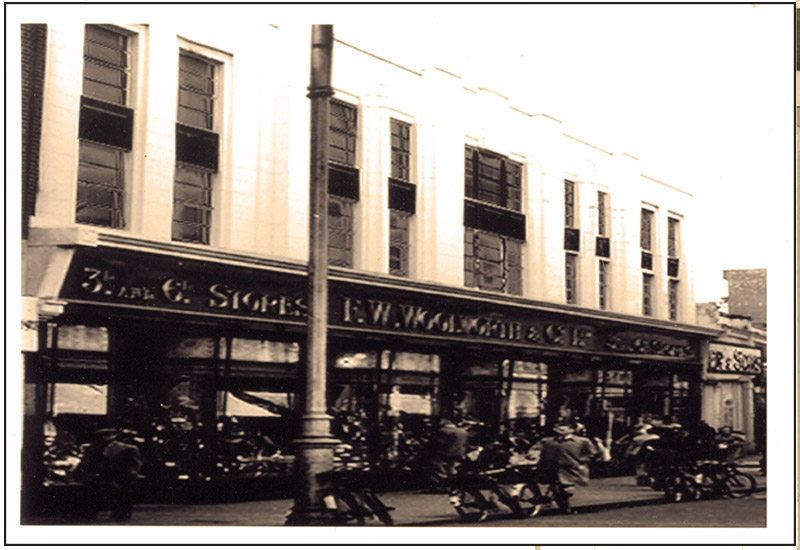
By the time Frank arrived - at seven a.m. rather than eight - the stage was set, the curtains ready. He would be in the spotlight today, and wondered whether it would be cheers or cabbages from his public. Forcing a path through the snaking queue of commuters at the tram stop directly outside, he had been halted in his tracks by the sight that he beheld. Somehow, by some divine combination of God's grace and 'W' elbow grease, his little hole-in-the-wall store had morphed into an edifice grander than Buckingham Palace, resplendent with its shiny, cream Darwen Glazed Bricks and art deco pilasters and with window displays to die for, promoting products that he didn't know he sold. He must still be sound asleep, because he could swear that he could hear the dulcet tones of one of his favourite songs from bygone days at the Royal Arsenal wafting from doors, and squinting in the sunlight could just make out the aethereal sight of a celebrated Director of the Company tinkling away at the ivories of a magnificent, brightly-polished baby Grand Piano. The spell was broken by a yell of "are you getting on mate?". Instinctively he had replied "I'm only thirty-three" before he heard a bell ring-out and with a start looked up to glimpse the doors rattling shut as the giant red Feltham clattered off into St John's Hill, resuming its trip to town.
Stepping inside, and dancing between the yard-wide brooms and cotton-headed mops that were gathering sawdust and debris, before buffing the pitched pine to restore its glow, he caught the last notes of the Good Bye-ee smash hit song that still made his toes tap so long after he had danced amidst the TNT with a Woolwich Canary in 1917, before the pianist finished with a flourish and stood to take a bow. Frank joined a ripple of applause as the artiste boomed out "Frankee - top o'the mornin', welcome to your show. Today is gonna be great. Like the Joanna? It's yours, my treat!" Irish, Yankee and Cockney idioms, all in one sentence - it could only be one man - JBS. "John - I don't know what to say - thank-you, t'be sure, ta fanks guvna - gee, wow, did another pony come in or something?" "Nope, but I'm backing a winner today, and that's a fact!" The showman beckoned him to the new 'Lunch Counter', his latest innovation from the US. "You have to try the cake, and nibbles too. Fortify yourself - I have news."
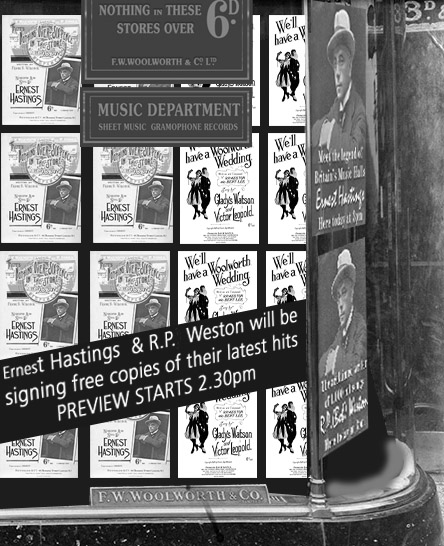
The showman laid out the programme for the day. It would be a re-launch with a twist. Everyone was being demoted for twenty-four hours. Bill Stephenson would be Store Manager from 10am, Snow would spend the afternoon 'Clerking' on Fancy Goods, showcasing sixpenny pops and - a world first for half-a-shilling, new electrically-recorded, seven inch gramophone discs called "The Victory", to Lawrence Wright, the publisher of Melody Maker and the alter-ego of hit composer Horatio Nicholls. Snow had persuaded big names to record for him. He was particularly proud to have two numbers from Al Jolson (under the pseudonym of Jack Smithson). Frank would be a learner once again, and Phil the Kitchen Porter, providing the backdrop for 'a V.I.P.', tasked with cutting the ribbon. For the first time since 1921, a Woolies would be opened by Mister Woolworth! Not Miller or Parson, the Founder's successors, nor CSW, just home from Oxford Street and a Motor Trip across Europe. Hearing that it was 'friend Frank's store', the VIP had asked if he "might be permitted" to do the opening and say a few words. Norman Bailey Woolworth was the only son of the man who had brought the Picots, JBS, Charlie McCarthy, 'EC' Prescott, and a hundred more into the Three-and-Six.
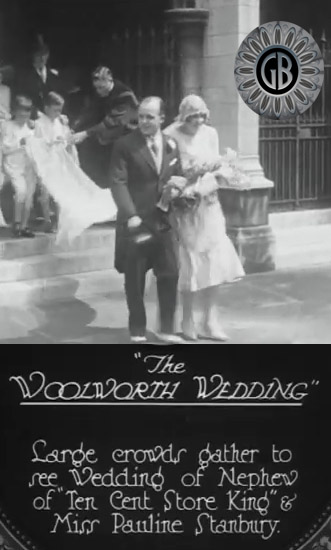 While not a big name in the UK, the tycoon had really made waves Stateside. He had set up "The Norman Company" at College back home. By 1922 at age twenty-one he was a millionaire, and had multiplied that ten times over after his Father, through some premonition, had avoided a fortune in death duties by gifting all his 'W' shares to mark his heir's coming of age. In the five years that had followed, shrewd investments and entrepreneurial skill had grown that ten times more. He had shown no interest in his pop's golden goose, only attending one meeting of the London Board, to take its tribute to Fred, and to fulfil his promise to articulate his father's "most earnest request" that Bill Stephenson should succeed him. At his mother's insistence he had taken her home to the USA straight after the Funeral.
While not a big name in the UK, the tycoon had really made waves Stateside. He had set up "The Norman Company" at College back home. By 1922 at age twenty-one he was a millionaire, and had multiplied that ten times over after his Father, through some premonition, had avoided a fortune in death duties by gifting all his 'W' shares to mark his heir's coming of age. In the five years that had followed, shrewd investments and entrepreneurial skill had grown that ten times more. He had shown no interest in his pop's golden goose, only attending one meeting of the London Board, to take its tribute to Fred, and to fulfil his promise to articulate his father's "most earnest request" that Bill Stephenson should succeed him. At his mother's insistence he had taken her home to the USA straight after the Funeral.
Love had brought him back, as he sought parental consent to marry the British socialite Pauline Stanbury. Hearing about 'Store 34', he had decided to stick around. Pop had told him many tall tales of Picot's scrapes and successes, and he had warmed to Frank seeing clearly why pop had chosen him as the 'ordinary soldier' at his Funeral.
The gregarious Snow knew Norman well. As a regular dinner guest at the Woolworths' Hampstead Home he had witnessed an awkward ten-year old blossom into a well-spoken and charming young man. They had become friends and had corresponded regularly ever since to exchange notes on trading conditions on either side of the pond.
MD Stephenson was happy to step aside for Mr Woolworth - his largest shareholder - knowing that it would generate headlines around the world, boosting both the opening and the share price. He was confident that Picot's Emporium would cut the mustard and meet with approval from 'NBW', but decided it would be prudent as the captain to be on-site from 10am just in case any "minor course correction" was needed.
Inspired by his friend's upcoming nuptuals, the Buying Supremo had arranged very special guests for the preview. He would be sending the car to Willesden to collect a big-name star from the Music Hall, with nationwide sell-out tours to his name on both sides of the Atlantic, returning to the store via Twickenham to re-unite celebrity no.1 with the man who had written much of his best comic material. His lyricist had also penned many of the UK's best-loved songs. The former, Ernest Hastings, had recently contacted him out-of-the-blue very politely requesting his blessing for some new material in his next tour which mocked F. W. Woolworth's Wonderful Emporium with 'nothing over sixpence in the store'. Snow hadn't simply said 'yes', he had persuaded the publisher to produce a sixpenny edition with an opening order of seven gross, and the promise of repeats if the song proved a hit.
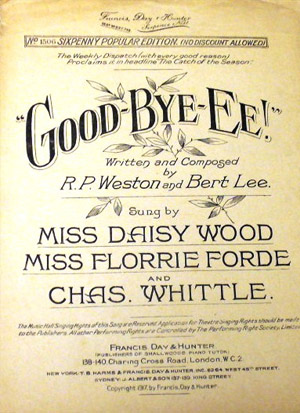 R.P. Weston was a household name. He wrote monologues for Hastings as a hobby, while composing a string of popular hits, each more successful than the last. He had penned I'm 'enery the Eighth I am, I am ("he got married to the girl next door, she'd been married seven times before"), and reputedly had sold half a million sheets. Partnering with Bert Lee, he had followed this up with Goodbye-eee in 1915, which had broken the two million mark by the end of the long-conflict. Virtually every adult alive at the time could still sing one whole verse from memory. Today, over a century later, the evocative words from a bygone age are still fondly remembered by the older generation:
R.P. Weston was a household name. He wrote monologues for Hastings as a hobby, while composing a string of popular hits, each more successful than the last. He had penned I'm 'enery the Eighth I am, I am ("he got married to the girl next door, she'd been married seven times before"), and reputedly had sold half a million sheets. Partnering with Bert Lee, he had followed this up with Goodbye-eee in 1915, which had broken the two million mark by the end of the long-conflict. Virtually every adult alive at the time could still sing one whole verse from memory. Today, over a century later, the evocative words from a bygone age are still fondly remembered by the older generation:
Goodbye-ee! Goodbye-ee
Wipe a tear, baby dear, from your eye-ee,
Though it's hard to part, I know
I'll be tickled to death to go
Don't cry-ee! Don't sigh-ee!
There's a silver lining in the sky-ee
Bon soir old thing! Cheerio, chin-chin!
Nahpoo! Toodleoo! Goodbye-ee!
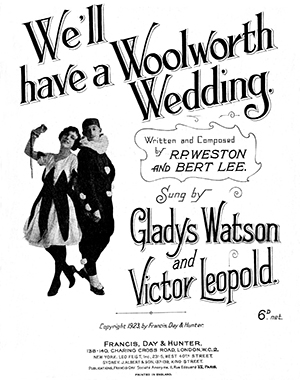 In 1923, after countless hits, Weston and Lee had collaborated on another, We'll have a Woolworth Wedding, and had persuaded their publishers, Francis, Day and Hunter, to produce a Sixpenny Edition, so that their 'super-fan', one John Ben Snow of this Parish, could include it in his selection of Sixpenny Pops in the very stores that the lyrics sent up. The 150 Threepenny and Sixpenny Bazaars had sold more than ⅓ million copies, contributing a handsome profit of over £2,750 to the bottom line. Snow knew that its words and sentiments would appeal to Norman Bailey Woolworth - I'll buy a trousseau for my bride, as long as it has you inside, I don't care if it comes from Paris or from Woolworth's Bazaar, and that when the national press and his friends at Gaumont British News carried his carefully crafted headline:
In 1923, after countless hits, Weston and Lee had collaborated on another, We'll have a Woolworth Wedding, and had persuaded their publishers, Francis, Day and Hunter, to produce a Sixpenny Edition, so that their 'super-fan', one John Ben Snow of this Parish, could include it in his selection of Sixpenny Pops in the very stores that the lyrics sent up. The 150 Threepenny and Sixpenny Bazaars had sold more than ⅓ million copies, contributing a handsome profit of over £2,750 to the bottom line. Snow knew that its words and sentiments would appeal to Norman Bailey Woolworth - I'll buy a trousseau for my bride, as long as it has you inside, I don't care if it comes from Paris or from Woolworth's Bazaar, and that when the national press and his friends at Gaumont British News carried his carefully crafted headline:
N.B. WOOLWORTH OF THE FAMOUS BAZAARS
TO WED SOCIALITE MISS PAULINE STANBURY
IN THE SOCIETY WEDDING OF THE YEAR
Woolworth's would be able to sell 1,000 in a day, before heading back for more. He was proud that both men had agreed to "sing for their supper". They would perform their favourite hits in-store, accompanied on the Baby Grand to the assembled throng, and sign all 1,000 copies, before climbing into the Rolls-Royce for a convivial evening with "Mr. Snow and Guest" at the famous Garrick Club. Everyone attending the Preview would be offered free copies of both songs - store name and address stamped, of course - as mementoes. The balance would go on sale when trading began in earnest on Saturday Morning.
As the morning ticked on, old friends began to appear. At 08.55 a posse breezed in from the new Southern District Office, (born February 1, 1926, at 311 Oxford Street, W1, weight - excessive, presumably a month early, as the date fell just under eight months after MD Stephenson had shared that he was expecting with Frank). First in was Louis Denempont, now Assistant District Manager, bounding up and shaking Frank by the hand. He wasn't going to miss this. Like all he had been demoted for the day, and was there as Mr. Fixtures and Real Estate. Next came Ernie Cox, who had initiated the Project with Frank and had been on the 'phone virtually every day to catch up with one Picot or the other. He was now a very grand Merchandiser, he could make products appear or disappear across 100 stores with a stroke of his pen, but today he'd come as a Superintendent. Finally Johnnie Whitell who had quite literally been 'elevated' to District Office by simply going up an extra floor in the lift of Store 161 below. The fourth in the gang had been waylaid on the loading bay, but was expected imminently.
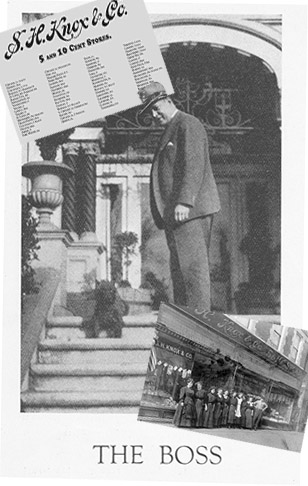 Frank Daniel Sprague was the latest American to put his name forward to cross the pond in search of his fortune. He had carried his unimaginative nickname - 'the boss' - with him. Stephenson had hoped that parachuting an experienced District Manager from Cleveland, Ohio into the same role in London, England would get the new way of working off to a smooth start. He brought an excellent pedigree. Like just about every Senior Executive he had started as a 'stockman', but, unusually, hired by Seymour Horace Knox for his outlet in St Louis, Missouri. Knox was Frank Woolworth's contemporary and a first-cousin. After working together on joint ventures, 'FW' had set him up in his own 5¢ & 10¢ chain. One store had grown to a hundred and eleven operating in a friendly rivalry with Woolworth's. Seymour had pioneered huge city centre 5¢ & 10¢s and had won his cousin round to the idea. A $65m bounty had persuaded the friendly rivals to sell out in 1912, forming the giant F.W. Woolworth Corporation.
Frank Daniel Sprague was the latest American to put his name forward to cross the pond in search of his fortune. He had carried his unimaginative nickname - 'the boss' - with him. Stephenson had hoped that parachuting an experienced District Manager from Cleveland, Ohio into the same role in London, England would get the new way of working off to a smooth start. He brought an excellent pedigree. Like just about every Senior Executive he had started as a 'stockman', but, unusually, hired by Seymour Horace Knox for his outlet in St Louis, Missouri. Knox was Frank Woolworth's contemporary and a first-cousin. After working together on joint ventures, 'FW' had set him up in his own 5¢ & 10¢ chain. One store had grown to a hundred and eleven operating in a friendly rivalry with Woolworth's. Seymour had pioneered huge city centre 5¢ & 10¢s and had won his cousin round to the idea. A $65m bounty had persuaded the friendly rivals to sell out in 1912, forming the giant F.W. Woolworth Corporation.
Sprague's long service had given him the rare combination of salesmanship, confidence and swagger, along with lots of Yankee Charm. He greeted Frank and Phil like old friends - "Mr Picot and Mr Picot, really great to meet ya. Y'have a fine store here. We have brothers in the USA too - look at old Frank, and young Sum, well old now, brothers both, so alike and yet so different. One a serial risk-taker, all big ideas, up in the air and so imaginative, the other more grounded, liking the personal touch and giving things time to bed in and settle, rather than changing just for the helluvit. Are you gonna take us on a meet and greet, and find us something to do?".
At Frank's suggestion, Phil was assigned as tour guide, freeing his brother to make last minute preparations for the arrival of his Managing Director, the all-powerful William Stephenson.
As the new DM began on his "Who are you and what do you do?" tour, a first for British Woolworth, and one that would quickly catch on and still happen regularly more than sixty years later, his Store Manager felt more than a little sorry for Phil, who had worked all night and yet would have to match the new man's seemingly boundless energy and enthusiasm as his contingent met around fifty different little huddles of shop assistants, catering staff, floor walkers and under-managers. Striking up any kind of conversation would be tough. Staff feared "big-wigs" who traditionally had to be treated with kid gloves and lots of yes, sir, no sir. But Frank needn't have worried. His namesake seemed oblivious to the stuffy protocols of the British Company, where Executives called all the girls 'Miss' - "over here Miss" - and only gave the courtesy of a surname if the colleague had half a lifetime's 'W' service. They expected to be called 'Sir', or their title and full surname, and never used first names in front of 'the troops'.
The girls must have sniggered behind the hands on the occasions when Phil joined Frank on his morning inspection. "Could you see to that Mr Picot?", "Certainly Mr Picot", "Why, I thank you Mr Picot" rather than a simple "Oy Phil, sort it!", "OK". There was no such reserve for 'the boss'. FDS marched up to a group of ladies, hand outstretched booming "Hi ladies, I'm Frank, the new District Manager. Nice to meet ya," kissing each one gently on the hand and staring into her eyes, before continuing in his softer Ohio drawl, "now then, who are you, and what do you do?" After a giggle, their reserve vanished and they gave a straight answer: "Hello Frank, nice to meet you too. I'm Grace, I've been with FWW for six years. I'm on the Toilet in the mornings and Dirt in the afternoons - that's what we call Compost and Fertilizer in the H-h-h 'orti er culture Department." "I see you're doing a fine job, looks dandy, keep it up.", and then back to the beginning again with the next person. The Brits, Ernie and Johnnie, found themselves completely ignored, while Louis quickly went native, following his boss's lead, and thus - with two Yankee DMs on a BOGOF (buy one get one free) offer, the time to get round was halved!
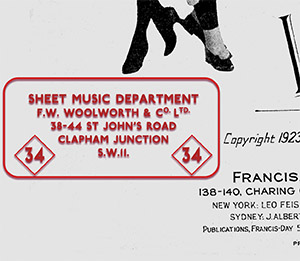 A complete round-trip of the store took a little over an hour. When Frank caught up with them, while walking the store with Managing Director, William Lawrence Stephenson, he was mortified to see that his brother had set the District Manager, Assistant DM, Merchandiser and one of the Superintendents to work. They were merrily store stamping a huge mountain of 2,000 music sheets, ready for the opening later in the day. The bosses were having a whale of a time, having improvised their very own sub post-office on one of the benches at the Lunch Counter. They were inking, stamping and stacking at quite a rate, while laughing at the funny lyrics of the songs, and at the mess it made when a mini-earthquake caused a whole pile of music sheets to tumble all over the pitched pine floor. Throughout the whole time that Woolworth's traded in the High Street, Executives always got demoted for the twenty-four hours of an opening day, and, for once, mucked in with everyone else!
A complete round-trip of the store took a little over an hour. When Frank caught up with them, while walking the store with Managing Director, William Lawrence Stephenson, he was mortified to see that his brother had set the District Manager, Assistant DM, Merchandiser and one of the Superintendents to work. They were merrily store stamping a huge mountain of 2,000 music sheets, ready for the opening later in the day. The bosses were having a whale of a time, having improvised their very own sub post-office on one of the benches at the Lunch Counter. They were inking, stamping and stacking at quite a rate, while laughing at the funny lyrics of the songs, and at the mess it made when a mini-earthquake caused a whole pile of music sheets to tumble all over the pitched pine floor. Throughout the whole time that Woolworth's traded in the High Street, Executives always got demoted for the twenty-four hours of an opening day, and, for once, mucked in with everyone else!
Stephenson seemed pleased when he arrived. For once he had enjoyed breakfast with his family and had the luxury of time to read the paper before strolling down to Purley Station to make the twenty-minute trip to Clapham Junction on a half-empty post-rush Southern Electric service. Three minutes after disembarking he was on the doorstep of his new-look outlet, and he liked what he saw. Ever-attentive the Manager was just inside the main door ready to welcome him. The MD made a thorough examination - frontage clean, glass well polished, windows dressed and ticketed, door furniture gleaming, all lights on at full brightness, counters filled and tidy, fire buckets in place, staff in correct uniforms and Store Manager present and attentive. Ten out of ten.
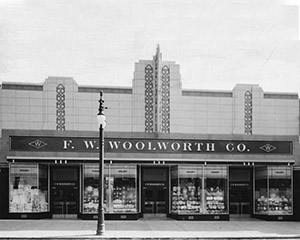 As for the new building, it surpassed expectations. William Priddle had gone the extra mile, and had incorporated all the ideas that he had shared from his recent trip to a new-build in Central Avenue Albany, the State Capital of New York, only better. The US version might have been the first-born of a pair of the twins, but its slightly younger sibling had sharper lines, better finials and fitted better into the streetscape, he confided. "Young Barton certainly looks promising, wouldn't you say? Seen him much?" Frank agreed with the first but not the second. "He did great drawings, and quickly prepared a very detailed plan to get me started, which has proved invaluable. Since then he's called me once a week to confirm that all is well - which it has been - but I haven't actually seen him."
As for the new building, it surpassed expectations. William Priddle had gone the extra mile, and had incorporated all the ideas that he had shared from his recent trip to a new-build in Central Avenue Albany, the State Capital of New York, only better. The US version might have been the first-born of a pair of the twins, but its slightly younger sibling had sharper lines, better finials and fitted better into the streetscape, he confided. "Young Barton certainly looks promising, wouldn't you say? Seen him much?" Frank agreed with the first but not the second. "He did great drawings, and quickly prepared a very detailed plan to get me started, which has proved invaluable. Since then he's called me once a week to confirm that all is well - which it has been - but I haven't actually seen him."
As he continued, inadvertently Frank's reply became more controversial: "Apparently Portsmouth is proving a much tougher nut to crack, and has required constant attention." With a sigh the Yorkshireman muttered words to the effect that the less said about "Store 35", the happier he would be. Little did Frank know that within a year he would have much more insight into why the Hampshire flagship on the South Coast hit a nerve with his Commander-in-Chief.
"So you've been Store Manager, Site Manager and Construction Superintendent then?" Getting an affirmative answer, he added, "well it's a credit to you, I would never have known. First time, too. Before I heap on too much praise how about budget, how are you against the worksheet costs?" Proudly Frank, who had taken care to have his finger on the pulse ready for the encounter boasted "Just over twenty percent 'X'.". He was shocked to see the MD's face begin to rouge, as his mood turned. He snapped: "It's easy to deliver construction works if you don't mind over-spending by a fifth. My God, £25,000 overspent and utterly shameless.". Frank laughed - hardly the ideal response - but quickly fired back "No, no, twenty percent UNDER forecast, I have £26,210 to give back!" Again his interrogator did not respond as expected. "YOU IDIOT! You could give a man a heart-attack. Surely you know that X means 'adverse to budget' - under for sales, over for costs, it's not plus or minus. Don't we teach that on day one? Well, sorry to explode, least said, soonest mended - at least we got that one out privately rather than when NB asks, as he will. He really would Nota Bene - and then he'd dine out on his 'X-rated story' for months. More about our Norman later. Another question - did you dress the windows?". It was Frank's turn for a surprising answer "Yes and No. Yes I did, but then my brother Phil did them again, only better, egged on by JBS.".
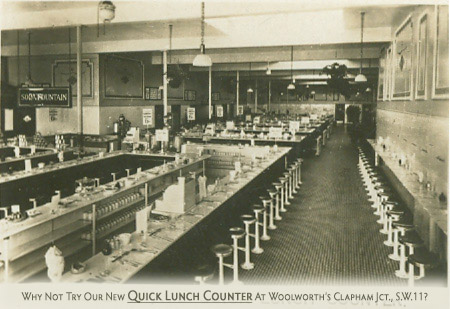
The answer was well-timed as the American-inspired lunch counter, complete with stools and benches was just coming into view, with its line of would-be postmasters from Southern District Office. "Good Morning, Mr Sprague, Mr Denempont", ""Good morning Bill, how are ya?" replied his DM, before seeing his ADM's discomfort and adding "Mr. Stephenson". Seeing the MD approach, Cox and Whitell had slipped into the kitchen, out of harm's way. "Store front beats Albany, don't you think?", "Sure does, surprising as it was built quicker and much cheaper too. Now the lunch counter, that's a different matter. A prototype at best, they seem to've sent designs from Lancaster, Penn 1912 rather than Albany, New York 1926.".

The MD did not rise to the bait, focused on the task in hand. Instead he asked if he could borrow two Picots, and took them out into the street to review the curtain fittings window. Turning to Phil, after confirming that he had dressed it himself, he described the display as "Very ... different, very effective", and asked how much it had cost. Phil's answer met with approval - fixtures and fittings nothing but elbow grease, all rescued from the builders' rejects, merchandise borrowed but kept saleable for later, and signs all supplier funded - so no cost. The MD asked Phil to call Mr. Valentine and arrange for the display to be photographed and imprinted onto a run of 288 of his postcards captioned Innovative and effective Dept. 25 display at 34 Clapham Jct. The finished product should be sent to be post-room at EO, with copies to be sent to all Store Managers, as well as the Buyers, EO Reps and Merchandise Men and the Directors. The surplus should be sent in the next batch of papers to the Woolworth Building in New York, marked FTAO Byron DeWitt Miller with a WLS compliments slip. But before the Learner's head got too large, there was a sting in the tail. The MD added "I like it so much, I have decided to overlook the van, and your underhand tactics in hoodwinking Mr. Teare, our Traffic Manager."
Visibly shocked, Phil asked what his crime was. The MD had two complaints. Firstly, stores were not allowed to order vehicles without his permission. He had confiscated any that broke the rule and sent them to Teare. More serious was that Teare felt hoodwinked, believing he was speaking to the organ grinder, not the monkey. He had complied with a special instruction from the MD to "offer every assistance to Frank Picot". Unusually courageous, Phil hit back. He had said only that his name was Picot and he was working on, not managing, the rebuilding of Store 34. He had even met Mr Teare to choose a vehicle from a long-line at the Warehouse. Stephenson, never a man to give in, had the perfect retort - "When a priest gives you absolution, with no Hail Marys, never try to revisit the sin, just say 'thank-you' and move on. But I hear you've done good work with your one-tonner, a good choice, so the store can keep it for as long as a driver can be found. From what I hear it soon won't be you, after some great work recently." Phil couldn't decide whether he had been damned with faint praise, or praised with faint damnation, but "being humble, decided he mustn't grumble!"
Stephenson hadn't finished. "Before we go back inside and join the others, there is another matter - our VIP guest. I have no idea what he will say. But our bankers will be there, by the number of poets I have seen lurking most of EO too, quite apart from the gutter press and our customers. They must not detect friction. We three have to take it on the chin. Whether he likes or hates the store, blames us for poor old Fred's early exit or considers us close friends, we must listen, smile and applaud politely. One day in the not too distant future I may need NB's deep pockets. It is crucial that he leaves happy - is that understood?" The brothers nodded, and all three men headed up to the canteen for 'staff cake' (the slightly wonky ones), nibbles and a pep talk.
Frank didn't share the MD's reservations about the special guest. He had last met Norman at his Father's funeral. At his Mother's insistence, he thought perhaps driven by grief, none of Fred's many other friends or colleagues from Woolworth's UK had been invited. Instead it had been filled with bankers, society friends from Hampstead and a contingent of family members from the USA, many of whom worked for the five-and-ten. Being shy, rather than mingling, Norman had waited to be approached. Most stepped up to pay their respects but the encounters were formal, starchy and brief, leaving the son and heir standing alone for much of the time. Frank had gone to the rescue, and the two had talked for a long while about Fred, how much he was loved across the organisation that he had shaped, and, speaking from personal experience and a great sense of gratitude, Frank told him of the selfless way in which the magnate had taken time to support and nurture the people he had recruited. A fortnight or so later, a handwritten letter from Connecticut had landed his doormat, thanking him most sincerely for making a dreadful day bearable and sharing such kind recollections about his Papa. NB had confided that, once home in the USA, his Mother had realised that she had misunderstood the Will. In saying make sure you invite Frank Picot to the funeral, her Fred had not meant don't invite anyone else from the 3-and-6, but don't just invite the top brass, remember I have friends as well as colleagues. That was water under the bridge, but on the day Frank had filled the shoes of a hundred men, "May God bless you for speaking sincerely from the heart, rather than following a script".
Sure enough, when 'Mr Woolworth' arrived, he was charming, shaking Frank's hand vigorously, patting him on the back and declaring that the new building was magnificent. As Stephenson had predicted, and with him watching on, he quizzed the 'Ordinary Soldier' on all aspects of the new Clapham Junction as he walked round examining the displays and greeting the hordes of Assistants who had hurried down to the floor and taken their positions behind the counters when he had asked if he might walk round. When it came to the opening, he too spoke with passion from the heart.
Good afternoon everyone, thank-you for coming. I will keep this short. A dozen years ago, almost to the day, I stood right there [he pointed to the far left entrance] as my Daddy cut the ribbon and welcomed the good people of Battersea to his thirty-fourth British store. I had just turned thirteen and the ceremony was my first. I am very honoured to follow in his footsteps, and to see for myself how his beloved 'Woolies' has grown and prospered. He would be proud.
In a few moments there will be live music, as much cake as you can eat and as much tea as you can drink, and the chance to take a look round the beautiful new store before the hordes descend tomorrow and trading gets underway again. But I hope you will indulge me while I recount a couple of tales from bygone days.
My Great Uncle, whose name you see above the door, Frank Winfield Woolworth, opened his first store in America in 1879, and it soon caught on. When my pop turned eighteen, FW persuaded my grandparents to let him to join his 5¢ & 10¢. To begin, FW's brother, Charles Sumner Woolworth, taught him about keeping shop in Scranton, Pennsylvania before sending him to New York. He shared the eight by twelve [2.5m x 4m] Office where FW bought all the goods, working as his Assistant. In 1901 I was born, and Papa was given the helm of the store in 6th Avenue, and the Company's warehouse next door, which took his vast orders of British and European Goods up from the docks, and distributed them to the hundred or so outlets that had sprung up in the US and Canada. It was hard work but Daddy was happy, and making good money. But in 1909 FW told him 'the past is prologue', the show was yet to come. He had been hand-picked to take Woolworth's to 'the Mother Country' - England - as MD of its first venture overseas. My whole family was packed on a boat and sent to Liverpool, where the new 'Three-and-Six' made its maiden voyage. A year and five more shops later, it came to London, with a seventh opening along the road in Brixton, and we moved to Hampstead to be close to it and the Capital. By the time Europe went to War he had built his chain to forty-four shops, and today that number is two hundred and forty. As I say, my Daddy would be proud.
Now, if you look behind me at the ladies in their crisp red uniforms with gold Ws on their lapels, and the fellas in collars and W ties, I'd like to introduce the merry band who have put this show on the road. They're proud too, and rightly so. Through all the building works, right up to yesterday, as well as preparing this fine new Woolies, they've kept right on serving you, showing just how much a sixpence can buy, both goods and service with a smile. As you walk around, say 'hello, well done, walk tall' because tomorrow they'll be rushed off their feet!
I'd like to finish by thanking one Extraordinary Soldier, the General in command of this great army, your Manager Frank Picot. This new store is his baby, and it's in the pink. My daddy told me once that his contribution to Woolworth's was more than he knew in the early days. After expanding steadily, it really took off after the Great War. Poppa said it grew strong in Great Britain by managing its merchandise and supply lines better than any rival. Today it is a well-oiled machine with a form for everything, streamlined ways of working and simple rules. To shape them, all my Father had to do was write down what a young Learner, trained by the British Army, was doing down at Sutton High Street - "keep everything ship-shape and Bristol fashion, maintain continuous counts, double-check your displays, report best sellers and slow movers and - above all - place orders every day, the very day they're needed". Two hundred and forty profitable stores prove that formula works. That's why he gave your Manager his first store at Streatham within a year of joining. His guiding hand kept him moving onwards and upward for the rest of his life, and he never regretted it. Today Woolworth's is a family affair for the Picots - another one, George, is at the helm in Exeter, and doing well, and a third, Phillip, works at Brixton, but is here today. Frank blazed the trail. I am sure that my Father is watching over us, happy that I have had the chance to thank you publicly. By rights you should be cutting the ribbon. But that falls to me. Enough talk
It gives me very great pleasure to invite you all to come join us in your brand new store, and to declare the Aladdin's Cave that is Woolworth's Wonderful Emporium in Clapham Junction (snip, snip) OPEN!
The Managing Director William Stephenson, the Field Marshall in his guest's analogy, nodded, smiled and led the applause. Clearly relieved, NB had not said anything that he didn't know already. The surprise had been how much his VIP knew about British Woolworth past and present. Clearly he had followed its progress at home and in his father's letters, and had kept up since his passing, perhaps in his regular dialogue with John Snow. He particularly liked the tribute to the staff - a very good touch. But the newspapers would only pick up two things from the speech, that his guest, the nephew of the Five-and-Ten King, had followed in his Father's footsteps, and had praised the chain's progress since his passing. That would do nicely. A transcript of the speech should be typed and distributed as a General Letter to All Stores, with a special imprinted version on fancy paper sent with a thank you note to Connecticut. That would be good diplomacy, and might be useful in the future.
Much revelry followed. The new-look store received many plaudits and had to send out for extra cake to fulfil numerous requests for doggy-bags. Stephenson, normally puritanical at heart, was taken with the singers, amused that NB had invited Bob Weston to his upcoming wedding reception, to hear a "big band and famous vocalist give the song the million dollar treatment it deserves." The young man really had grown into a diplomat - what a clever way of saying I love your song, but you can't sing for toffee! As the artistes clambered into Snow's Rolls-Royce en-route to the Garrick and the last stragglers wended their way, Frank and his team tidied the store at lightning speed to allow themselves a respite before the frenzy of the first day's trading in the morning. All were agreed that the new Clapham Junction was off to a good start, and was on track to beat its stretching sales target, both for the opening and the run-up to Christmas.
The songs that were performed on the opening day
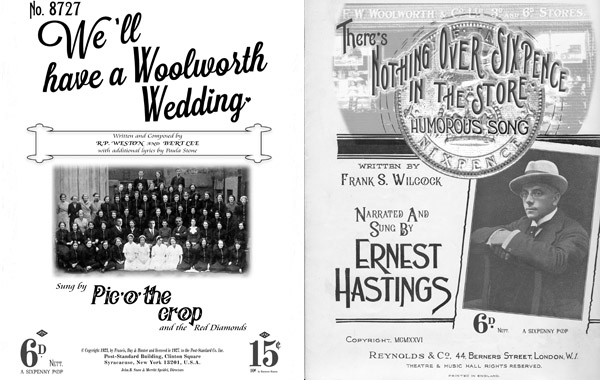
There's Nothing Over Sixpence in the Store
For your delectation and delight, from the Music Hall Stage to the Museum Web-Page
The one, the only, the irrepressible, the inimitable, the entirely indefatigable
Mr Ernest Hastings, singing for his supper with Frank S. Willcock's splendid compostion.
We Will Have a Woolworth Wedding
On the opening day Bob ("R.P.") Weston reminded the crowd that he was a composer not a singer, and invited members of the store staff to join him for the performance. Enjoying the result, Norman Bailey Woolworth persuaded the Picot brothers to do "a little something" for his Woolworth Wedding. Our film recreates that performance, drawing on the original Gaumont British and Pathé Newsreels, imagining how things might have been if the BBC's infant 2 L O Radio Service and the two newsreel gazetteers had co-operated rather than competing on the day.
The Woolworths Museum proudly presents a full HD 1080P extended newsreel of the extraordinary performance Pic'o'the Crop and the Red Diamonds at St. Margaret's, Westminster on Sunday, 7 August 1927 at the "Society Wedding of the Year"
"Gee! What a Wedding."
For accessibility a buttons in the player enable closed caption subtitles (for enabled browsers). Clicking the square button on the bottom right corner of the player will play the film in full screen mode. Press [Esc] to return to normal size and this page.
Frank was given less than three months to enjoy the fruits of his endeavours. On Boxing Day, the Annual Inventory or stock count revealed that sales and profits had beaten all records, thanks partly to the new layout and particularly increased business at the American-style fast lunch counter, and because of tight control of stock losses during the refurbishment work. Traditionally Managers paced the carpet in early January, expecting a telegram from District Office, which planned a complex series of interdependent Manager moves requiring up to three weeks of face-to-face meetings with the individuals affected. Frank was surprised to get the call before December was out, and taken aback by what the DM, Frank Sprague, had to say. He offered hearty congratulations for a fine year-end result, but had no offer to make, just a message to pass on. He was to make his way down to Victory House for a tête à tête with the MD. Sprague added to the mystery by suggesting a stiff drink en-route, followed by a couple of peppermints, and half-hinting that Stephenson was firm in his resolve in the path he had chosen. Less than twenty minutes after reaching the top floor at Oxford Street, Frank found himself on his way again.
On his arrival at Executive Office, after signing in with the commissionaire, as he sat down to read the paper, the MD breezed in with a smile and whisked him into the executive lift for a ride up to his inner sanctum. The Yorkshireman was blunt. Clapham Junction had been a big success, inspiring a "a big ask". Indeed the request was so large that he had dreamt up three sweeteners to make the pill easier to swallow. Two were financial. He handed his guest a bonus cheque for much more money than he was expecting. He explained that he had waived the normal rule that bonuses should be halved if a store had been refurbished, and had added half of the savings that Frank had achieved on the rebuilding costs in appreciation of his role as Construction Superintendent alongside being the Store Manager. He would also maintain Frank's 12% commission rate. The third incentive, which would be a secret between them, had been carefully crafted. As two Picots had contributed to success at Store 34, he would also be rewarding young Philip, with a store of his own. Taking a leaf out of Fred Woolworth's playbook in sending Frank to South Shields, Phil would oversee the final stages of building works for a new store at Strood across the bridge from Rochester, Kent, before taking the helm. Like his brother before him, this would give him the chance to shape the layout and pick the team. He had no doubt that 'Junior' would match or exceed the standard achieved the pair had achieved earlier in the year.
The incentives were conditional on Frank taking on a particularly challenging store, which the two had discussed before. Stephenson quipped "just add one to your store number", and seeing a glimmer of recognition, he added "my biggest headache, 35 Portsmouth". It had opened in August 1914. The South Coast sea-port was the home of the Royal Navy, who called the shopping area 'Landport'. The frenzy of dock work during and immediately after the Great War had made it a great success, prompting a series of tweaks and extensions throughout the Twenties.
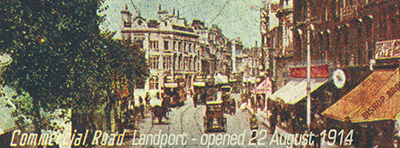 The most recent changes had failed. The early phase had cost far more than planned, prompting major economies to complete the work. Since re-opening sales had been lower than before the investment. Frank's mission would be to turn the situation around, with immediate low-cost remedies, and a considered plan for any re-work with a statement of costs and benefits.
The most recent changes had failed. The early phase had cost far more than planned, prompting major economies to complete the work. Since re-opening sales had been lower than before the investment. Frank's mission would be to turn the situation around, with immediate low-cost remedies, and a considered plan for any re-work with a statement of costs and benefits.
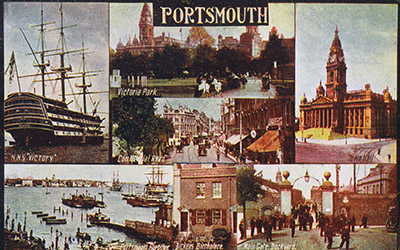 There would also be extra duties as a flagship store. He would be asked to assist with the opening of a second, suburban store in the Fratton area, and with helping new stores on the Isle of Wight to become established. It would be very different from working in London.
There would also be extra duties as a flagship store. He would be asked to assist with the opening of a second, suburban store in the Fratton area, and with helping new stores on the Isle of Wight to become established. It would be very different from working in London.
The MD offered no suggestions about how to fix the store's problems, instead offering advice about the practicalities of the move. Stephenson feared that, despite a fast train service from town, Picot would find himself abandoned by his Friday poets, but should maintain the dialogue by telephone. He would also have to break-in a new Superintendent.
Stephenson was candid. He feared Frank was about to face the consequences of his decision to decline promotion. He would find the new man younger, less experienced and dare he say, less capable than Frank - definitely less imaginative. At the annual review the Super. had offered no suggestions on how to fix Store 35's collapse in profit, despite it being his largest store. That was why the MD considered it crucial that Frank begin at once - he was sending in the big guns, and had told the Super. to "watch and learn". Frank would have to juggle Store Management with moving home. Perhaps Lucy could find new schools for the children, and take a first look at some properties, to lighten the load and fill the gap left by leaving friends and family in London?
Stephenson recommended retaining and renting out their London property in anticipation of a future return. Maybe they could treat a seaside purchase as a "holiday home"? Frank tried to play hard-done-by, but secretly relished the challenge, and was pleasantly surprised by the rewards. He had guessed what the move would be, based on Friday gossip, and Lucy had offered her blessing, were the offer to be made.
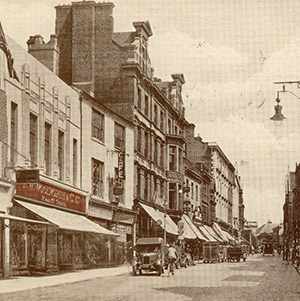 Twenty-four hours later he had joined a fast train from London Victoria to Portsmouth and Southsea at Clapham Junction. Stephenson's secretary had arranged a first-class ticket, a cab the short distance along Commercial Road and a fortnight in a five star hotel in Southsea to smooth the transition, while Frank had headed straight back to Store 34. Two people would be making frantic moves the following day. His replacement Oscar Holst was instructed to take the first train to London for a handover. In a reversal of roles, Oscar, who had handed over 78 Streatham to Frank in 1919, was being promoted from Gold Street, Northampton to fill his shoes. He had served in Rye Lane, Peckham (Store 15) until 1923, when he and his family had been despatched to the bootmaking town right at the heart of England. He had lobbied hard for a return to London. Now it was Frank's turn to go 'on safari'. The safe combination was changed, the rule book and keys were handed over and the stock book (with details of the recent inventory) was signed off, and Frank had introduced the new man to the team and said his good-byes.
Twenty-four hours later he had joined a fast train from London Victoria to Portsmouth and Southsea at Clapham Junction. Stephenson's secretary had arranged a first-class ticket, a cab the short distance along Commercial Road and a fortnight in a five star hotel in Southsea to smooth the transition, while Frank had headed straight back to Store 34. Two people would be making frantic moves the following day. His replacement Oscar Holst was instructed to take the first train to London for a handover. In a reversal of roles, Oscar, who had handed over 78 Streatham to Frank in 1919, was being promoted from Gold Street, Northampton to fill his shoes. He had served in Rye Lane, Peckham (Store 15) until 1923, when he and his family had been despatched to the bootmaking town right at the heart of England. He had lobbied hard for a return to London. Now it was Frank's turn to go 'on safari'. The safe combination was changed, the rule book and keys were handed over and the stock book (with details of the recent inventory) was signed off, and Frank had introduced the new man to the team and said his good-byes.
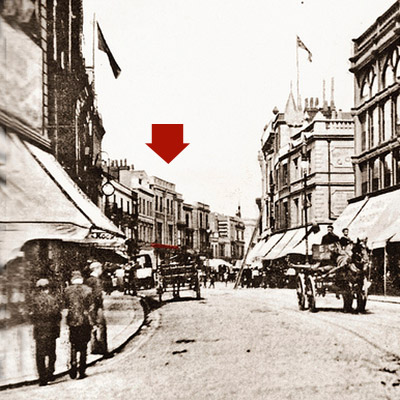 The Portsmouth handover was more painful. Stephenson had glossed over the fact that he had got the previous manager out of the way by making him Superintendent. He would be taking the handover from Walter Hilton. Stephenson had criticised Walter for the poor result, but had been forced to admit that the changes had been forced onto him by his previous boss, had been overseen by a Construction Superintendent and had effectively been undermined by Government cutbacks in the Dockyard.
The Portsmouth handover was more painful. Stephenson had glossed over the fact that he had got the previous manager out of the way by making him Superintendent. He would be taking the handover from Walter Hilton. Stephenson had criticised Walter for the poor result, but had been forced to admit that the changes had been forced onto him by his previous boss, had been overseen by a Construction Superintendent and had effectively been undermined by Government cutbacks in the Dockyard.
Both men knew that Frank had been sent to stop the rot, with freedom to do whatever was necessary. The ground had been laid by declaring a huge shrinkage, leaving the new man with a clean stock, while the new Superintendent had been left in no doubt that, despite having an office and a secretary in the store, Picot would be his own boss, updating Sprague and Stephenson on his progress. Hinton promised he would be no trouble and would "watch and learn", as instructed.
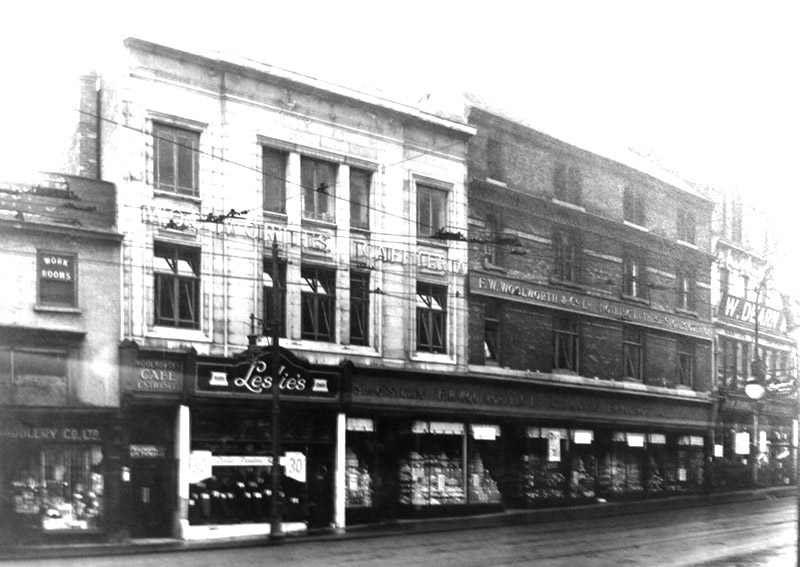
After making a thorough examination of the store, Frank had some sympathy for his new boss. Many of the problems were structural in nature. At first glance the decision to open a customer restaurant on the first floor, with its own entrance directly from the street, appeared to have merit. The previous Superintendent had assumed that this would allow the restaurant to open into the evening and on Sundays when the main store was closed, maximising profitable food sales without driving up general labour costs or shrinkage. But his calculations assumed that extended merchandise displays would plug the sales gap that would result from removing the quick lunch counter from the ground floor, which had proved incorrect.
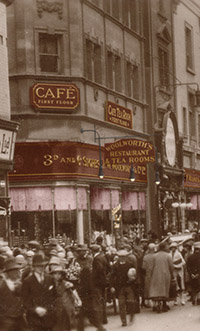
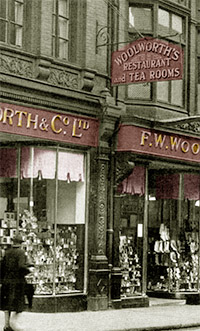
But the biggest problem was plain to see - there was a Leslie's shop bang in the middle of Woolworth's frontage, separating its main store from its restaurant. The tenant would not move however much they offered, leaving a choice - cancel the project and lose the money spent already, or workaround the problem.
The furore had forced the architects to make sacrifices to stay within budget. They could no longer match the look at Castle Street, Bristol (left) and Grafron Steet, Dublin (right), where the upstairs cafés were clearly signposted and fully integrated. They could not even fix the roofline, render the whole frontage to give the stone cinema front or 'faence' look, let alone conjoin the first floors of the two buildings.
But now the dye was cast. Perhaps the Project Team should have called the Leslie's proprietor's bluff and halted the project, on the basis that facing the music would be better for their careers than delivering such a dog's breakfast. For better or worse Pompey had the ugliest Woolies in the land with a lost restaurant running on empty, and a main shop taking less money than in previous years. Frank's mission was to turn things round quickly, spending as little as possible until it was back in the black.
New projecting signs at first floor level could perhaps distract the eye, but fixing the design flaws would be costly and impossible to justify until Leslie's lease or resolve ran out. But there were plenty of other, cheaper options that could turn a quick profit. The store's stockroom was generally well managed, but was carrying far too much stock given the decline in sales. Frank resolved to review every item and only carry reserves for the items with the highest potential. This would reduce shrinkage and release funds to chase after huge quantities of some special buys that should draw the crowds. But the biggest potential could result from a fundamental rethink about who the main shoppers were.
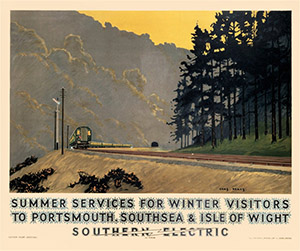 Back in 1913 Portsmouth had been deemed an industrial area. The store had been set up to serve dockers and workers from the naval dockyards, and their suppliers. Its secondary market was thought to be sailors' families from across the island. The decision had proved sound during the Great War, but had not been revisited in peacetime. Fast trains with cheap-day returns and weekend excursion tickets, and good links for an increasing number of motor car owners via the main A3 and A27 trunk roads, made Portsmouth a popular destination for day-trips and weekend breaks from London and across the Home Counties. People were drawn to Charles Dickens' birthplace along Commercial Road, the Isle of Wight ferry, and the big ships of the Royal Navy, or a simple trip to the seaside.
Back in 1913 Portsmouth had been deemed an industrial area. The store had been set up to serve dockers and workers from the naval dockyards, and their suppliers. Its secondary market was thought to be sailors' families from across the island. The decision had proved sound during the Great War, but had not been revisited in peacetime. Fast trains with cheap-day returns and weekend excursion tickets, and good links for an increasing number of motor car owners via the main A3 and A27 trunk roads, made Portsmouth a popular destination for day-trips and weekend breaks from London and across the Home Counties. People were drawn to Charles Dickens' birthplace along Commercial Road, the Isle of Wight ferry, and the big ships of the Royal Navy, or a simple trip to the seaside.
Frank argued that the store should offer the firm's seaside ranges, spanning everything from ice-cream and clotted cream fudge, to summer toys like buckets and spades and windmills, as well as sunglasses and hats, and local view cards, and should promote its restaurant to tourists. His old friends Johnnie Whitell and Ernie Cox, now Merchandise Men at District Office agreed, and quickly made the ranges available. Frank ordered example menus from Duttons of Liverpool (the Company printer), and Mr. Valentine agreed to produce a batch of postcard-style photo cards cheaply. These were distributed through local Bed and Breakfasts and selected Southern Electric Railway stations.
Frank argued that the store should offer the firm's seaside ranges, spanning everything from ice-cream and clotted cream fudge, to summer toys like buckets and spades and windmills, as well as sunglasses and hats, and local view cards, and should promote its restaurant to tourists. His old friends Johnnie Whitell and Ernie Cox, now Merchandise Men at District Office agreed, and quickly made the ranges available. Frank ordered example menus from Duttons of Liverpool (the Company printer), and Mr. Valentine agreed to produce a batch of postcard-style photo cards cheaply. These were distributed through local Bed and Breakfasts and selected Southern Electric Railway stations.
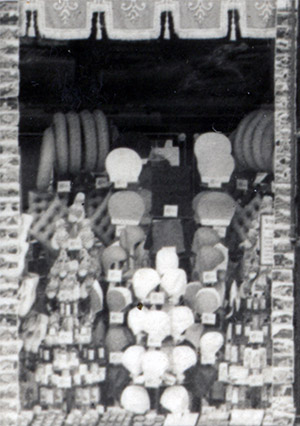
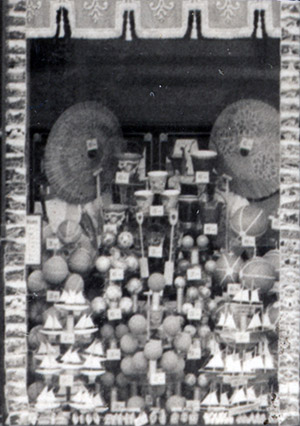 As Spring turned to Summer, the store had been reborn. Its colourful central windows featured buckets and spades, kites and cricket bats for a fun day out. Inside the counters were brimming with bargains, thanks to a leaner, smarter stockroom operation.
As Spring turned to Summer, the store had been reborn. Its colourful central windows featured buckets and spades, kites and cricket bats for a fun day out. Inside the counters were brimming with bargains, thanks to a leaner, smarter stockroom operation.
The turnaround had begun in the restaurant too. It had built a strong breakfast trade and also drew large crowds every weekend, proving a smash with daytrippers and weekenders staying in one of Pompey's hundreds of budget Bed and Breakfasts.
But a solution for weekday lunchtimes and evenings in the Restaurant was proving more challenging. The marketing blitz generated quite a few bookings, but not enough people simply 'dropped in', fearing the trip along the road would take too long in a short lunch-break. Frank had been forced to find a Plan B to build the sales volumes he was seeking. He cobbled up a simple Tea Bar on the main sales floor, cramming it with rolls, sandwiches, ice cream and soft drinks (below, left).
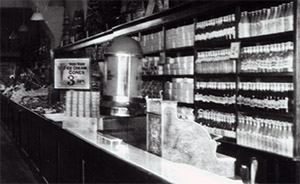
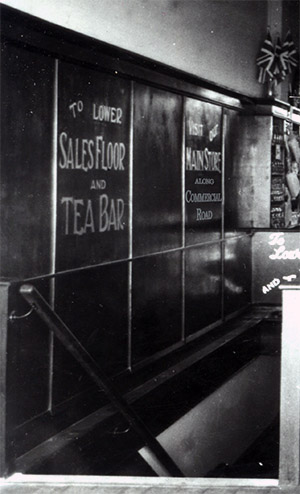 A cheeky hand-painted sign on the landing by the restaurant, invited shoppers to "Visit our Main Store along Commercial Road" (right), just in case they missed the Woolies next-door-but-one.
A cheeky hand-painted sign on the landing by the restaurant, invited shoppers to "Visit our Main Store along Commercial Road" (right), just in case they missed the Woolies next-door-but-one.
Superintendent Hilton had to avert his eyes as he approached his office, to avoid being reminded of the folly of siting his restaurant so far off-pitch. His only consolation was that Frank's remedial measures seemed to be working.
He had to admit that several other innovations drawn from the new man's successes at Clapham Junction were also proving popular. Sailors' wives among the staff had helped spread the word to the island's service families that their new, enhanced ranges of paints, polishes, floor coverings and curtains could transform drab service quarters into a home from home for just a few bob (5 to 50p).
By 19 August, the anniversary of the re-opening from refurbishment the store had achieved sales of £104,986/17/- (equivalent to £8.4m or $15.1m at today's prices) against a target of £100k, exceeding the forecast by 5%. By any measure, this was an extraordinary turnaround given the first four months' trading. Frank might not have been able to fix the building structure, but had applied entrepreneurial flair to the store's operations, along with sharper stock management disciplines. His total expenditure to the grease the wheels had been just under £500 for a signage, leaflets and a carpenter to adapt some fixtures and make running repairs. He had also been the driving force behind the opening of a second, suburban store in the Fratton District. Branch 289 in London Road, North End had opened to acclaim on 26 November 1927, generating bumper Christmas sales. Frank was mighty relieved that its turnover appeared to be incremental, with no discernible impact on his own branch.
The year-end stock-count showed a higher overall margin in the second half, driven by the merchandise mix and a year-on-year reduction in shrinkage. With expenses tightly controlled, net as well as gross profit were well above the target, and even the uppermost figure that he had agreed with the MD to calculate his bonus. The remuneration would top the previous year’s record even though it had been boosted by a share of the construction savings that he had achieved at Clapham Junction.
As the skills of his Deputies and Learners grew and the trading pattern settled down, Frank had time to move on to the other half of his brief. He needed to develop the business case to sort out the structural problems. Exploratory talks with the Leslie's owner proved fruitless. He would not budge until his lease expired in mid-1933, telling Frank he should blame himself because whatever he was doing next door was proving great for business! In the circumstances Frank advised Stephenson that it would be best to hold off on the main works, sorting out the frontage and roofline in late 1933, finishing at Easter 1934. In the meantime a simple, cheap scheme could transform the interior, boosting profits without breaking the bank.
Building on the success of the improvised tea bar, Frank had added displays of Dept. 3, Food Specialities. The tinned fruit, along with cans of ham, fish and crabmeat had proved a hit with tourists planning a picnic on the seafront, or as they queued to board a ferry to the Isle of Wight. The success proved that the store could sustain a full-scale modern tea bar on the Ground Floor without impacting sales in the Restaurant above. He planned to call in a favour from the parent company team which had helped him at Clapham Junction, having kept in touch ever since, He wanted to adopt their latest design of quick service tea bar from Atlantic City, New Jersey into the main salesfloor at Portsmouth, Hampshire. They seemed happy to help.
Frank proposed condensing the merchandise layout at Portsmouth without losing any products, by respacing and in some cases re-orienting the counters, to make room for a new style tea-bar which could use the capped services that had been left behind the wall fixtures when the ground floor tea-bar had been removed during the 1926 modernisation of the store. He estimated that the Tea Bar could generate up to £750 per week in peak season, and £200 from October to February, a total of £24.7k very profitable turnover. He also argued that a ground floor tea bar could justify extended trading hours from 8am to 8pm on Monday, Tuesday and Thursday, and until 10pm on Thursdays and Fridays. The Company could also request permission to trade the whole store for up to eight Sundays during the peak summer season. These moves would be likely to add at least £10k of incremental merchandise sales. Overall he estimated that a £7,500 investment in the fixtures, installation and labour for the counter moves could deliver £35K incremental sales and a net increase in profit after deducting incremental labour costs of £12.5k.
The plan found favour with Supt. Hilton and D.M. Sprague. Stephenson approved in principle and agreed that it would be progressed in due course, but ruled that it should be put on hold until annual depreciation charges had reduced the store's excessive outlay from its fixtures account. For the time being he asked Frank to concentrate on driving forward the Company's expansion on the Isle of Wight.
Within days of arriving at Portsmouth he had released his Deputy and two of his Learners to assist with pre-opening work at the first store across Spithead at Ryde. Building work had completed shortly before Christmas, and by New Year nearly all of the counters had been installed. The Portsmouth posse was set to work laying out the glass partitions on the top of the mahogany islands, and ghosting out the displays with one of each item which was to be displayed in that slot, and a scribbled note of the price. This made it easier for the new recruits, who had yet to become familiar with the products, to fill the displays by playing 'snap' and add a printed price ticket. Meanwhile, back at base, Frank hurriedly milked his network of poets to rustle up a good range of opening day offers to make the launch go with a bang. He also fulfilled a list of items that were out of stock at the suppliers from his reserves, to fill most of the gaps at Ryde. By 18 February, when Frank was invited over to cast an eye over the store with Hilton, and make any last minute corrections before the preview the following day, it looked splendid. His team had done well; the store set a new, modern standard for the Island. It was clear that it would be a hit.
Building on the success, Hilton invited Frank to develop the proposal for a second store across the Island in Newport and take it through the approval process, and to map out which other towns could sustain a Threepenny and Sixpenny Store. He set about the task with his customary zeal. By the time the work was complete it was clear that the outlet in Ryde was an overwhelming success, guaranteeing approval for the follow up. In descending order of potential, he identified Cowes, Shanklin and Sandown as possible locations for future stores. The branch in Newport opened fifty-one weeks after Ryde. In due course the others followed in the sequence he had set, in 1934, 1936 and 1960, respectively. Following the pattern established at Ryde, his Deputy and Learners helped out during the fit-out at Newport, while Frank was given specially responsibility for the stores on the Isle of Wight, relieving pressure from the Superintendent, and asked to spend a day a week on the Island offering the benefit of his expertise and helping the Company to exploit the full potential of the popular holiday destination.
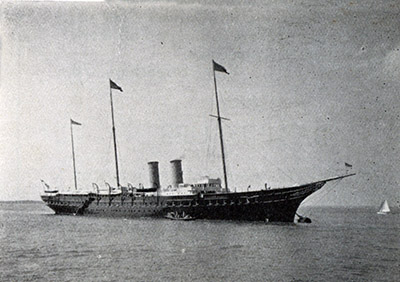
The District Manager Frank Sprague travelled down from his lair in Oxford Street to conduct the opening. He was delighted with the store and praised all those involved in preparing it.
The following day, back on the mainland, the two men took a tour of the Portsmouth superstore. The turnaround had been remarkable. It had morphed from a headache to a goldmine. Having examined the store, Sprague fully endorsed Picot's oversight role for local stores that had been instituted by Hilton. Frank would have to wait until the Summer for the MD's take on the new stores and his progress at Store 35.
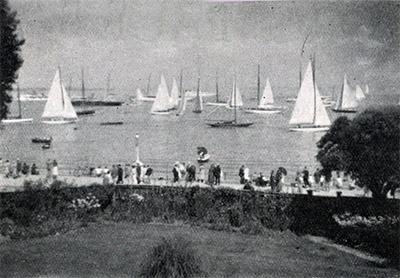 William Stephenson generally didn't like to show off the trappings of his increasing wealth, but made an exception when it came to sailing. He had recently bought the family a small racing yacht and had hired a professional captain. He had named it Malahne, using the last letters from the first names of his three daughters Velma, Sheila and Daphne. It was to be the first of three increasingly luxurious craft that he would race during the Thirties, all named after the girls.
William Stephenson generally didn't like to show off the trappings of his increasing wealth, but made an exception when it came to sailing. He had recently bought the family a small racing yacht and had hired a professional captain. He had named it Malahne, using the last letters from the first names of his three daughters Velma, Sheila and Daphne. It was to be the first of three increasingly luxurious craft that he would race during the Thirties, all named after the girls.
Stephenson took his new acquisition down to Cowes for the Regatta, booking into a luxury hotel for the week. He took the opportunity to slip into his two stores on the Isle of Wight, and liked what he saw.
That evening he telephoned Frank from his hotel and invited him for drinks and a chat on his next trip over. The two agreed to meet on the seafront in Cowes and go on from there. To Frank's surprise rather than stepping into a Bar, Restaurant or the boss's hotel, they headed to the quayside, and clambered aboard his yacht for drinkies in the Stateroom, where they could chat informally and in complete secrecy. Stephenson opened the conversation by praising the new stores on the Island, reporting that both Managers had been keen to share the credit with Frank and his Deputies. He had been equally impressed on the mainland, both by reports from Fratton, and the speed of the turnaround achieved in Commercial Road.
Normally this would the time to ask "the question", and he wondered if there was any point in broaching it again. Frank confirmed that, despite agreeing to the oversight role, he remained firm in his resolve to remain in Store Management rather than climb the greasy pole to Superintendent and into District Office. He was candid in admitting that this was partly because he continued to be among the best paid Store Managers in the Company, thanks to the steady rise in profits. He argued that young Superintendents needed 'old sea dogs', not ambitious for their jobs and keen to support their transition, to break them into the role. He treated them as "just a different type of learner". He also confirmed that the family was settled in Pompey. He was enjoying the bracing sea air, which had been good for his health. So he was in no great hurry to return to London. He was happy to wait for the right vacancy. In the meantime he had a number of new ideas to boost sales, though he admitted he was at a loss to understand the supremo's resistance to his Tea Bar proposal.
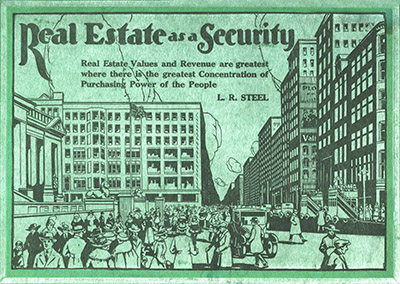 Stephenson had waited for the opportunity to discuss the quandary face-to-face. He made clear that what he was about to share had to remain absolutely confidential. The L.R. Steel scandal in the USA had heated up. The New York District Court had ruled that no state-registered business could buy any freehold property overseas without obtaining its approval in advance. L.R. Steel's pyramid 5¢ & 10¢ store scheme had defrauded its investors out of $60m. Stephenson had found the Court was too slow, and that complying with its rules would undermine his expansion programme. It had forced a rift between him and the other Directors of the Parent Company. A solution had to be found urgently.
Stephenson had waited for the opportunity to discuss the quandary face-to-face. He made clear that what he was about to share had to remain absolutely confidential. The L.R. Steel scandal in the USA had heated up. The New York District Court had ruled that no state-registered business could buy any freehold property overseas without obtaining its approval in advance. L.R. Steel's pyramid 5¢ & 10¢ store scheme had defrauded its investors out of $60m. Stephenson had found the Court was too slow, and that complying with its rules would undermine his expansion programme. It had forced a rift between him and the other Directors of the Parent Company. A solution had to be found urgently.
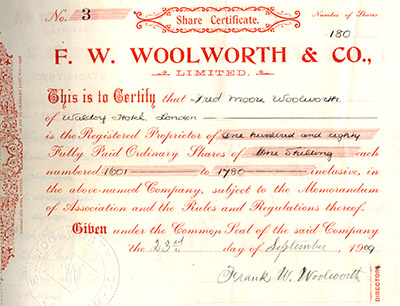
Aided by John Snow and Charlie Hubbard, he had been plotting for some time with his former fellow UK Director Byron Miller, now the VP in New York. In principle he was prepared to recommend a reduction in the parent's stake in British Woolworth from 66 to 52%. The surplus shares would be sold to the highest bidder on the London Stock Exchange.
The newly-listed F.W. Woolworth & Co. Ltd. 3D & 6D Stores would be London-registered and would operate under British law rather than being regulated in the State of New York. It would be classed as an unconsolidated subsidiary of the giant American F.W. Woolworth Co.
The planned flotation was why Stephenson had been keen to keep Norman Bailey Woolworth on-side. His deep pockets would provide a backstop to ensure the share issue was not undersubscribed. It also explained why Stephenson had been "saving up" his favourite development schemes. During the launch he wanted to have initiatives that would showcase the future potential of a British Woolworth. Picot's proposal would be particularly useful as it showed a way of sweating an existing asset.
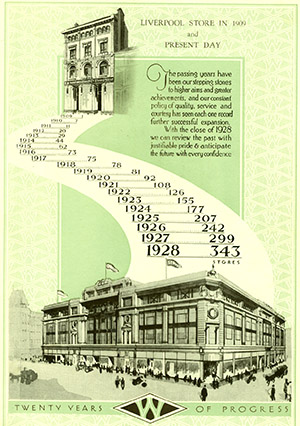 Miller and Stephenson would have to wait patiently for the right time to obtain approval from the New York Board. It would be most likely to succeed in a year of slower than average growth, given the reservations of Miller's boss, President Hubert T. Parson, whose golden rule was to preserve everything just as Frank Woolworth had left it. Stephenson hoped to obtain approval in Autumn 1929, for a listing at the start of the New Decade. That sign-off would be the cue to launch 'Project Pompey' on a no-expense-spared basis. He hoped it would chart the way forward for every catering unit in the business as a simple repeatable formula for driving a profit from food.
Miller and Stephenson would have to wait patiently for the right time to obtain approval from the New York Board. It would be most likely to succeed in a year of slower than average growth, given the reservations of Miller's boss, President Hubert T. Parson, whose golden rule was to preserve everything just as Frank Woolworth had left it. Stephenson hoped to obtain approval in Autumn 1929, for a listing at the start of the New Decade. That sign-off would be the cue to launch 'Project Pompey' on a no-expense-spared basis. He hoped it would chart the way forward for every catering unit in the business as a simple repeatable formula for driving a profit from food.
Frank accepted the logic and strongly favoured the London-listing. Uncharacteristically unguarded Stephenson observed that his broker was certain the shares would be oversubscribed, citing the steep, steady profits curve achieved over almost two decades and its market-leadership as elements that would attract Institutional Investors, like a rash of new pension funds which had launched recently.
While Frank would have to bide his time before launching Project Pompey, he should maintain the dialogue with the Food Services team in the USA so that he could hit the ground running in due course.
Stephenson was particularly complimentary about another sales idea mooted by his guest. Frank's latest brainwave had the potential to generate sales in a total of ten branches dotted along the south coast. Perhaps buoyed by his time afloat and the MD's friendly demeanour, Frank set to work with enthusiasm. In 1927 the Royal Navy had launched Navy Week after the early August bank holiday. They issued an open invitation for people to visit their Dockyard in Portsmouth, Plymouth or Chatham for a guided tour of their finest vessels, past, present and future. In Portsmouth this included the 'holy of holies' Horatio Nelson's H. M. S. Victory, which had just been restored, a working Battleship and the latest state-of-the-art vessel, which was about to start sea trials. The admission price was one shilling (5p at the time, equivalent to about £4 or $7 today) for adults, or sixpence (half of those amounts) for minors and Airmen in uniform. Visitors had to rely on snaps in the Guide Book as no cameras were allowed. But most people found that the uniformed sailor who took them on board ship, described what they were seeing and answered questions more than made up for the stringent security measures. Frank had been surprised at the sheer number of people who bought tickets in the first year, and just how far some of them had travelled. A straw-poll revealed that lots of families had chosen to make a week of it, shopping, sunbathing and taking in other sites as part of their holidays. Thus he believed the event had big potential for the Company, particularly at its seaside stores in the vicinity of the Dockyards. Company support for the initiative would show that Woolworth's was deeply embedded in its local communities.
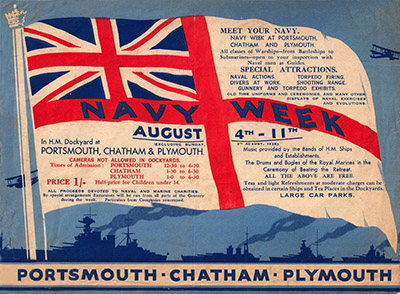 Frank persuaded the Managers of Store 55 Plymouth and Store 69 Devonport in the south-west, and his neighbours at Southsea (No. 50), North End, Fratton (No. 289) and the Isle of Wight (244 Ryde and 303 Newport), and Stores 17 Chatham, 177 Maidstone and 256 Strood along the River Medway in the South East to team up.
Frank persuaded the Managers of Store 55 Plymouth and Store 69 Devonport in the south-west, and his neighbours at Southsea (No. 50), North End, Fratton (No. 289) and the Isle of Wight (244 Ryde and 303 Newport), and Stores 17 Chatham, 177 Maidstone and 256 Strood along the River Medway in the South East to team up.
They advertised in the Event Programme, and all stocked goods chosen for them by the Merchandise Men including picture cards, books, toys and mementoes, as well as bunting and flags and a special Café Menu. Cards were sent to Guest Houses, Hotels and Stations, showing Woolworth's one-stop offer of tickets, programmes, souvenirs and refreshments.
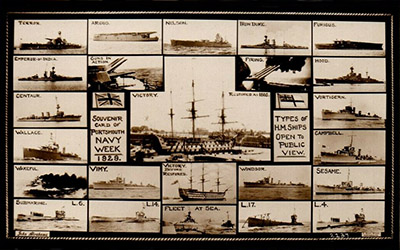
The Marketing Offensive proved highly effective. Visitors snapped up the postcards, flags and bunting, while toy sales rocketed across the whole range, not just the special buys. The restaurants and tea bars were packed, and sales of sunglasses, cream and hats broke all records. The halo effect from the event carried on for several weeks after the gates of the dockyards had closed, stretching into September in both Plymouth and Portsmouth.
Morale was boosted too. The stores had many sailors' wives on the workforce, who proudly wore badges, scarves and more loaned by their husbands to support the event.
The success put the event on the stores' calendars for the next nine years. The Navy weeks raised a lot of money of charity, and allowed tens of thousands of people to get up close and personal with the latest fighting ships. Navy Week ended abruptly when the country began to re-arm in earnest, responding to events in Germany. Suddenly the dockyards were working around the clock, with their endeavours veiled in secrecy, and kept far away from the prying eyes of enemy spies.
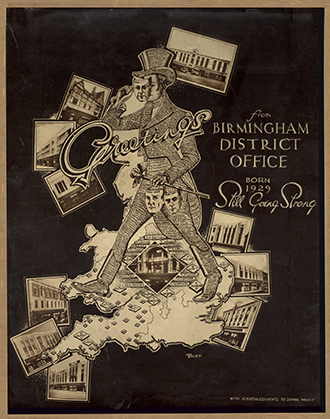 Behind the scenes big changes were afoot, showing what Frank had sacrificed by declining promotion for a second time. In 1929 a new District Office opened in Birmingham - an industrial city 120 miles north-west of London and 80 miles south-east of Manchester in the English Midlands. It would control the stores to the south and west of the city, including the industrial heartland, Wales and the West Country. The new DM was his friend and former Superintendent Ernie Cox, who had hand-picked Johnnie Whitell and Superintendent Hilton for his top-team.
Behind the scenes big changes were afoot, showing what Frank had sacrificed by declining promotion for a second time. In 1929 a new District Office opened in Birmingham - an industrial city 120 miles north-west of London and 80 miles south-east of Manchester in the English Midlands. It would control the stores to the south and west of the city, including the industrial heartland, Wales and the West Country. The new DM was his friend and former Superintendent Ernie Cox, who had hand-picked Johnnie Whitell and Superintendent Hilton for his top-team.
Meanwhile a bumper year stateside in 1928 forced Stephenson and Miller to postpone the London listing. But after ending 1928 cash-rich, F.W. Woolworth Co. hit rock bottom as one of the biggest losers in the Wall Street Crash of 1929. Many investors including the Company President faced ruin. Hubert Parson had over-extended, securing loans against his shares for a grandiose scheme to acquire and refurbish Shadow Lawn, formerly the 'Summer Whitehouse' Every major investor lauded Miller and Stephenson as heroes after they saved them all. The shares raised far more than anticipated, funding a special dividend which in real terms was the highest payout of the Company's 118 years trading in the Main Streets of North America.
Stephenson held true to his promise, rushing through approval for Project Pompey as soon as the share sale was tabled in New York, so that work on design could commence before Christmas 1929, and counter moves to make space could commence straight after the Annual Inventory when stock was at its lightest. installation of the new, deluxe Quick Service Lunch Counter commenced in February and was complete just in time for Easter. Three members from the parent's Catering and Construction Divisions travelled from the Woolworth Building to assist with the installation, and stayed well into the Summer to gauge public reaction to the design. Later this would help to shape future refinements back home. Many would argue that the layout shaped with Frank Picot was Woolworth's finest ever catering offer. It was years ahead of its time, delivering sales almost four times higher than forecast, as a result of faster throughput, and remaining busy all year round. The state-of-the-art layout gave it appeal to businessmen as well as traditional shoppers The original photograph of the facility, (shown below,) had pride of place on the wall outside the Board Room at Woolworth House in London through into the 21st Century. It had been hand-picked as an example of the Company at its most innovative and successful.
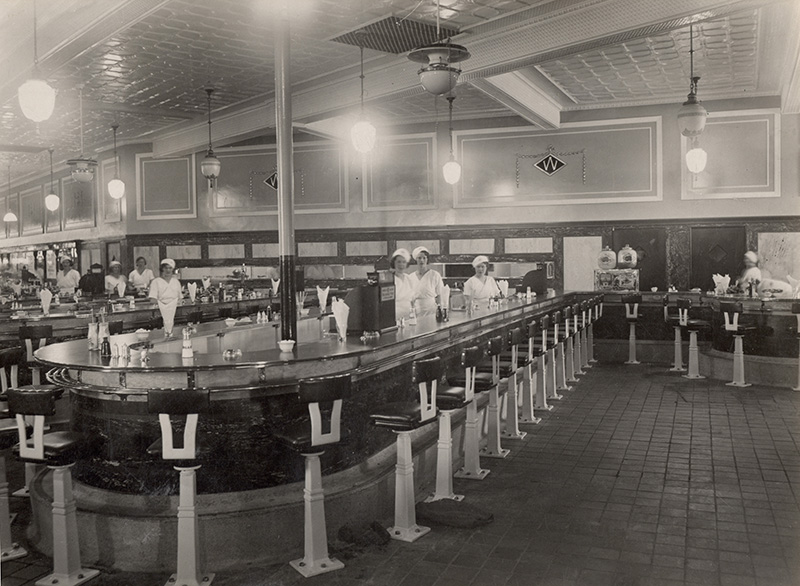
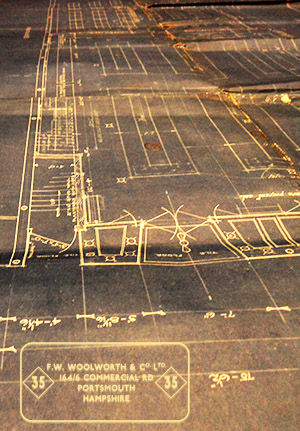 As Frank had predicted sales in the upstairs restaurant remained buoyant, and despite a reduction in counter space for merchandise on the Ground Floor, new adjacencies on the salesfloor drove a substantial increase in sales. At the time it was unusual for a store to be relaid unless it was being extended. The mahogany fixtures were tough and resilient, and could be adapted as required. Despite being swept daily and oiled ever week, occasionally the pitched pine floors wore out from the sheer volume of customer footsteps. Typically they were renewed a floorboard at a time to avoid disrupting sales.
As Frank had predicted sales in the upstairs restaurant remained buoyant, and despite a reduction in counter space for merchandise on the Ground Floor, new adjacencies on the salesfloor drove a substantial increase in sales. At the time it was unusual for a store to be relaid unless it was being extended. The mahogany fixtures were tough and resilient, and could be adapted as required. Despite being swept daily and oiled ever week, occasionally the pitched pine floors wore out from the sheer volume of customer footsteps. Typically they were renewed a floorboard at a time to avoid disrupting sales.
Frank broke the mould at Portsmouth by re-arranging the positions of the counters, turning some of them to right angles in order to improve sitelines and make distinct areas in the huge salesfloor for the different ranges. The long delay between conceiving the idea and bringing it to fruition had given him plenty of time to assess the space requirements of the range at different seasons of the year, and plan the layout in meticulous detail rather like a three dimensional jigsaw. This not only maximized sales, but also contained the labour cost for the seasonal moves.
The end result of the work was as competitors faced challenges locally in the slump that followed the Wall Street crash, Woolworth's motored ahead.
The achievement was particularly remarkable given Government economies in the early 1930s, reaping a peace dividend and - despite the positive message conveyed during Navy Week - less of the fleet being replaced or renewed each year. This reduced the level of work in the dockyards, with knock-on consequences to the suppliers in the Navy's Supply Chain, many of which were based locally. The popularity of the new Lunch Counter, and the decision to target the tourist trade with seasonal 'Seaside and Summer' ranges as well as the indigenous market, had changed its demographic sufficiently to make it less vulnerable to a downturn in heavy industry.
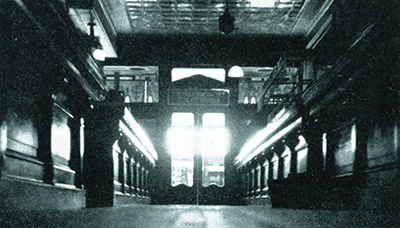 For the first time in his career Frank wasn't moved on straight after implementing his grand plan. He had a year to enjoy the fruits of his labours, as Stephenson was unanimously elected Chairman by British Shareholders. Freed from the shackles of the US District Court, it was full steam ahead.
For the first time in his career Frank wasn't moved on straight after implementing his grand plan. He had a year to enjoy the fruits of his labours, as Stephenson was unanimously elected Chairman by British Shareholders. Freed from the shackles of the US District Court, it was full steam ahead.
Frank had pinpointed two new opportunities to boost sales and profit in 1931. He would chase after products made of the new wonder material, Bakelite, an early plastic. And he would feature Eclipse, a new, exclusive record label, offering top titles on longer eight-inch electrically recorded discs.
He had learnt about Bakelite by keeping his ear close to the ground. He had encouraged the three-man installation team who travelled from New York to oversee the Quick Lunch Counter installation to bring news of the latest innovations from North America with them. As they supervised work late into the night, there had been plenty of time to chat. His guests waxed lyrical about the imaginative uses their Buyer had found for the new man-made bakelite, which some were calling the eighth wonder of the world. While molten it could be shaped and moulded, before setting rock hard. It was virtually unbreakable and was even ovenproof, as well as being completely hygienic to wear as jewellery.
The Americans had experimented with different colours and patterns, shapes and a myriad of different products for the shelves of the 5¢ & 10¢. Frank's guests were able to show him what they meant in a hot-off-the-press copy of a new company leaflet called Bakelite is Beautiful, which showed examples of the Buyer's favourites from stylish brooches and necklaces from their Fancy Goods ('Jewelry') Department to Saucepans, Kitchen Tools and Oven-to-Tableware in as well as electrical fittings and even a pocket camera. The black and white brochure showed their favourite lines, but had to describe the colours and patterns for readers. Frank had the brochure photographed and sent copies to both the Oxford Street and Kingsway Offices, requesting British equivalents of the best lines to try out in Portsmouth. His friends didn't disappoint coming up with some great ideas of their own. Frank ordered substantial quantities, and paid Duttons the Printers to adapt the American brochure to incorporate the new British product designs before producing twenty-four reams of brochures for distribution in-store and another case to go to the Buyers and Directors at Executive Office in each of the District Offices as a teaser.
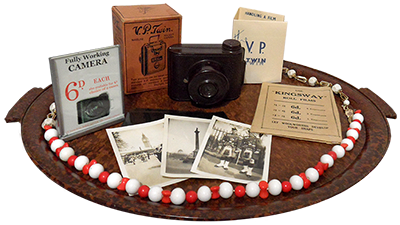
Window displays promoted the remarkable new Jewellery lines made from Bakelite. Each looked exactly like a five shilling item, yet sold for just sixpence - one tenth of that price. Sales were off the clock, and as an early adopter there was plenty of stock to replenish. Similarly serving trays, and new oven-to-tableware proved to be top sellers. The dishes were non-stick with a dark-brown finish, and could resist the highest temperature, staying cool to handle and easy to clean, unlike existing enamelled and anodised designs.

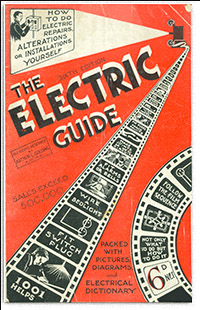 Spectacular results were achieved with a new range of electrical fittings, including bell-pushes, light switches, plugs and lampholders, Frank was able to maximise sales by sourcing a step-by-step guide, bought for 2D and sold for 6D, explaining how to install each item safely.But the runaway best-seller was a sixpenny camera, the VP Twin. Although basic, without focusing or exposure controls or support for flash, the Eliot Company had excelled. The B.O.L.Co. ground lense could snap a sharp image outdoors on standard 127 film. The cameras became a mainstay of the Woolworth's offer in the Thirties. By World War II inflation had forced the chain to resort to selling them in three sixpenny pieces - the back and film reel, main body and case. In spotting them first, and targeting tourists, Frank was able to corner the market and sell more than 15,000 cameras by the year end, contributing £375 sales and £100 profit, and quadrupling his developing, printing and enlargements business too.
Spectacular results were achieved with a new range of electrical fittings, including bell-pushes, light switches, plugs and lampholders, Frank was able to maximise sales by sourcing a step-by-step guide, bought for 2D and sold for 6D, explaining how to install each item safely.But the runaway best-seller was a sixpenny camera, the VP Twin. Although basic, without focusing or exposure controls or support for flash, the Eliot Company had excelled. The B.O.L.Co. ground lense could snap a sharp image outdoors on standard 127 film. The cameras became a mainstay of the Woolworth's offer in the Thirties. By World War II inflation had forced the chain to resort to selling them in three sixpenny pieces - the back and film reel, main body and case. In spotting them first, and targeting tourists, Frank was able to corner the market and sell more than 15,000 cameras by the year end, contributing £375 sales and £100 profit, and quadrupling his developing, printing and enlargements business too.
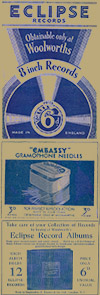
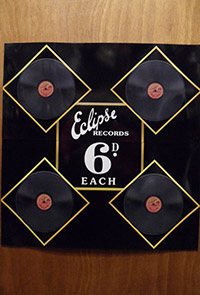 He also took the rebranding of the Company's 78rpm gramophone records from The Victory to Eclipse as a prompt to rejuvenate his music displays in the Fancy Goods Department. The sound quality had been upgraded and the length increased thanks both to Shellac, a bakelite derivative, and the electric recording techniques already proven on The Victory.
He also took the rebranding of the Company's 78rpm gramophone records from The Victory to Eclipse as a prompt to rejuvenate his music displays in the Fancy Goods Department. The sound quality had been upgraded and the length increased thanks both to Shellac, a bakelite derivative, and the electric recording techniques already proven on The Victory.
The sixpenny price was half the rate charged for similar titles from the same supplier on the Rex label at M&S, which were a shilling, or Crystallate's official releases on their Broadcast discs, which were a shilling and threepence (two and a half times as much.) The best titles featured the top stars of the day singing songs from the Movies, popular hits drawn from the BBC's 2LO radio service, Nursery Rhymes and Popular standards.
Frank had a new secret weapon. He had hired a skilled carpenter as the store's first official handyman. To prove his worth, the new man was asked to cast a spell over the music displays. With assistance from a pair of burly learners, at the close of business on Saturday night several fixtures were removed from the salesfloor, hauled on giant Collis Pallet Trucks to the large goods lift in the corner of the salesfloor and up to the stockroom, and a temporary home in the bulk goods receiving area next to the bench. With Frank's permission the handyman had suggested swapping his rota day so that he could do the work on a Sunday when the store was closed, and the noise and mess wouldn't disturb anybody.
Thirty-six hours later the learners returned from their weekend break, expecting to haul the same fixtures back to the floor, perhaps repainted or revarnished, or tweaked around the edges. To their surprise there was not a single piece that looked anything like the items they had taken up in the lift. They had delivered some bays of mahogany cupboard, a worn counter-top and some old racks. They had morphed into a listening booth, where a customer could sample a record in private (with its lid down) or share their discovery with friends (with its lid up). There was also a bespoke counter-top display rack for eight-inch (20cm) records standing on end in spring-forward compartments that always looked full and tidy, and a special wall display panel with slots for featured discs, the sheet music of the same song and a dispenser of the latest fortnightly Eclipse catalogue. By 9am each piece had been hauled into place, polished and filled up in time for morning inspection. Everyone agreed the record department looked magnificent.
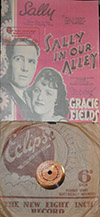 In an era when half of homes had a piano rather than a gramophone, he ensured that there was both a sheet and a record for each hit, displaying one behind the other.
In an era when half of homes had a piano rather than a gramophone, he ensured that there was both a sheet and a record for each hit, displaying one behind the other.
Finally he arranged a tie-up with local cinemas. He would promote their films in-store. In exchange both the local Associated British Cinema (ABC) and the two Gaumont-British movie theatres would announce that the songs were available for sixpence at Woolworth's, and invited people to collect a brochure in the foyer. He enjoyed particular success with the first Gracie Fields film, Sally In our Alley, selling more than a thousand sheets of the title composed by Harry Leon and Leo Towers and tweaked by Will E. Haines, and a staggering 1,500 discs sung by Pat O'Dell, all for sixpence. By Christmas, Frank's Fancy Goods Department had trebled its turnover.
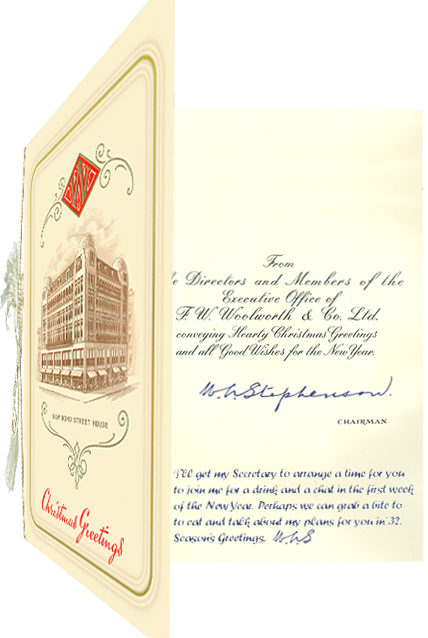
As the crisp nights drew in, Store 35 was all set for Christmas with full counters and packed aisles from dawn until well after dusk. Frank was made up to get a fancy Christmas Card from the Chairman, Bill Stephenson. It featured an etching of the swanky new Executive Office, a must-have for a London-listed Company, it stood at Nos. 1 to 5 New Bond Street, Mayfair W1, opposite the Burlington Arcade.
Traditionally Store Managers and executives got simple pre-printed greetings, rather than a handwritten card from the special selection. The top-man had scribbled a note saying his Secretary would schedule a one-to-one for a drink and a meal out, to discuss a new role for Picot in '32.
Armed with that insight he devoted his energies to sweating the asset one last time at Portsmouth to maximise his bonus. He organised a series of evening socials for sailors and their families. They would have the lunch counter to themselves, dressed for Christmas and crammed with free nibbles, free Christmas Cake, mince pies and mulled wine for all. The handyman could deliver their purchases in a small lorry at a date to please, and the Office Cashier was on hand with 'Form Five Customer Orders' so they could buy now and pay cash-on-delivery after the bumper payday in Christmas Week, if they wished.
He took the opportunity of these special nights to bring out ends-of-ranges from the stockroom, offering two for the price of one as stocking fillers for all the family. This would help him to leave a totally clean, current stock for his successor. Lesser men normally did the opposite.
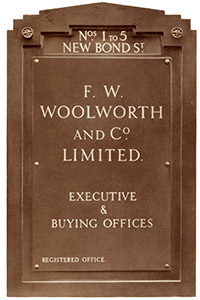 Frank found the new 'EO' was even more impressive in real life. Woolworth occupied to four upper floors; it also had a lobby on the corner of the ground floor level, set between a Fancy Jewellers to the left and a branch of Westminster Bank to the right. It was like stepping forward in time. The lobby had been equipped with stylish art deco furnishings. There was reception desk at one end, where a uniformed commissionaire guarded the grand doors of the express lifts. Comfy chairs were grouped around small tables; beyond them were booths along both side walls. Each had a velvet curtain for privacy, and sported a walnut sign indicating VACANT or ENGAGED.
Frank found the new 'EO' was even more impressive in real life. Woolworth occupied to four upper floors; it also had a lobby on the corner of the ground floor level, set between a Fancy Jewellers to the left and a branch of Westminster Bank to the right. It was like stepping forward in time. The lobby had been equipped with stylish art deco furnishings. There was reception desk at one end, where a uniformed commissionaire guarded the grand doors of the express lifts. Comfy chairs were grouped around small tables; beyond them were booths along both side walls. Each had a velvet curtain for privacy, and sported a walnut sign indicating VACANT or ENGAGED.
Stephenson was also different somehow. In a fancy suit, he seemed more suave and refined, , as he greeted Frank in a softer, authoritative but warm tone with the Yorkshire accent virtually gone.. He guided his guest into the elevator, for a tour. Then there would be a 'pre-prandial snifter' in the Board Room, which would give three old friends a chance to say hello. After 'drinkies' a car would whisk them down to a Bistro in Leicester Square, where they had some serious eating and talking to do.
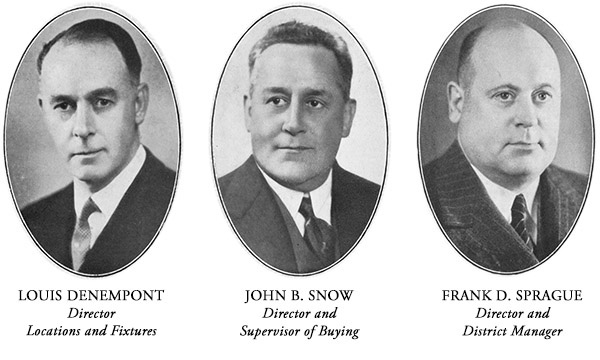 The three guests had engineered the meeting. Each had played a part in the rebuilding of Clapham Junction, and was now on the Board.
The three guests had engineered the meeting. Each had played a part in the rebuilding of Clapham Junction, and was now on the Board.
They congratulated Frank on another spectacular turnaround, this time at Portsmouth, once a 'curate's egg' and now a 'little gold mine'.
They were all looking forward to working for him in 'the new role', whatever that might be, and were there for him any time he needed their help. He should simply ask.
Frank would be seeing all three men regularly during the 1930s, occasionally at New Bond Street, but more frequently at his store. As the Chairman whisked him back into the lift for the short trip to the bistro, Frank still had no clue where that would be.
 Once they were comfortably seated in the quiet alcove which had quickly become a home-from-home for the Woolworth Supremo, where business could be discussed and shaped informally, with no danger of being overheard and with attentive but discrete service, Stephenson began. With a chuckle he described Frank's time at Portsmouth as "a Victory, an H.M.S. or He Made Sackloads Victory!"
Once they were comfortably seated in the quiet alcove which had quickly become a home-from-home for the Woolworth Supremo, where business could be discussed and shaped informally, with no danger of being overheard and with attentive but discrete service, Stephenson began. With a chuckle he described Frank's time at Portsmouth as "a Victory, an H.M.S. or He Made Sackloads Victory!"
After careful thought he had decided that the next store should be much more of a challenge. If he agreed, Frank would be sent to the branch which most people from London and the South considered to be the holy and holies. According to Company folklore its opening had marked the point when Woolworth UK had morphed from an experimental vanity project, out of the way in northern England, into the Five-and-Ten's first full-fledged overseas subsidiary. Frank and Fred Woolworth had taken a fresh-faced Louis Denempont, hot foot from the docks after the long voyage from the USA to his new home, to teach him how to 'scout' a good property. John Snow had overseen the opening, bringing the suburb to a stop at 2pm on Friday 10 December, 1910 with no less than three marching bands criss-crossing the major arterial road in step, and "more fireworks than Westminster on Guy Fawkes' Day".
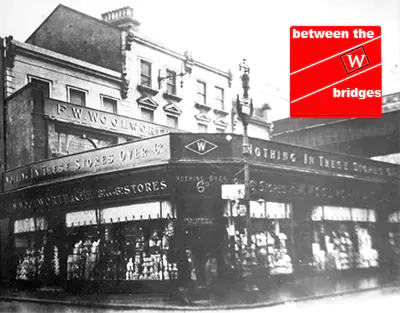
Frank already knew the store like the back of his hand. It had been the nearest neighbour to two of his earlier branches, and his brother Phil had trained there and ferried stock around in a van blagged from Executive Office. Brixton was one of Woolworth's top performers, but somehow had missed out on the modernisation and restyling afforded to most of the other prime outlets since 1920. At its helm was Frank's friend, Stanley Victor Swash, another military man who had won a prestigious Military Cross with bar (twice) for bravery during the Great War. Swash had brought Store 7 under control, running a tight ship, employing many of the disciplines first invented by Frank a decade earlier.
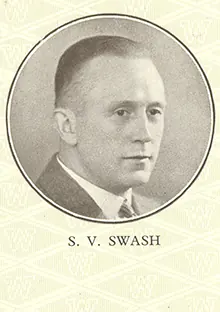
Swash was a typical larger store manager of the time. Away from the store he was a relaxed, jovial family man who enjoyed camping and larking about with his kids, but at work he was strict and aloof. Chit-chat was kept to a minimum, even with his Deputies. He demanded complete obedience from his counter and stockroom staff, rarely speaking to them unless something was wrong, and was ruthless with anyone who did not meet his exacting standards. They rarely saw how kind he was behind the scenes, when he stepped in to support anyone who worked hard but fell upon hard times through illness or bereavement, paying doctor's bills, making cash grants or painstakingly arranging transfers to another branch to be closer to a relative who needed care. This type of benign dictatorship was Woolworth's way for its superstores. Swash was destined for the very top. Within a dozen years he would be MD, and by 1950 he would be Chairman of the Board, presenting the Company's results to investors.
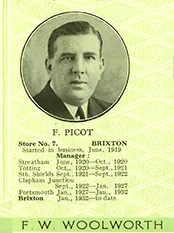
Frank Picot was cut from a very different cloth. He had a meteoric rise up the chain, joining as Swash had begun a brave two year fight to walk again after a falling under fire in the last days of the World War. Woolworth spotted Frank's potential within days of appointing him Manager of a tiny store. Brixton was his third 'class one' flagship. His formula was to get to know every employee personally, exploring their skills and aspirations. He enjoyed jovial banter with his regiment of counter and stockroom assistants, and actively encouraged input from his officers and NCOs, floor walking supervisors and deputy managers, believing this would help them to develop and grow. His way of working meant that when an obstacle stood in his store's way, all of its people would step up to go the extra mile. He would then reciprocate, buying chocolate as a break-time treat, or giving everyone a week's free meals and drinks in the staff canteen.
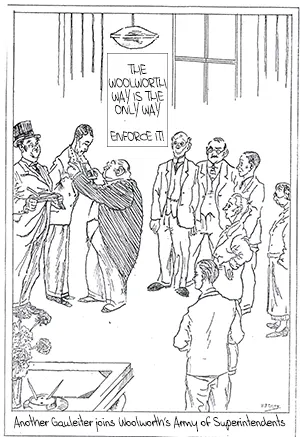 Throughout the 1920s most of his bosses had turned a blind eye to these deviations from the Woolworth's way. They and Frank had joined and trained together. So they had seen at close-quarters that, despite his laid-back style, he still maintained strict discipline and the staff did not abuse his trust. Friends excused his unusual style to fellow Generals by sharing Frank's track record, regenerating some of the highest profile stores. Frank did not help himself. He repeatedly declined promotion, allowing younger, more ambitious and less pragmatic men to leapfrog him, and before long was reporting to one of them. These Gauleiters were much less tolerant of 'fraternization', believing it inexorably led to a scandal when lines were crossed. Frank had to fall back on the protective umbrella of the patronage of Chairman Stephenson, District Manager Sprague and the other Directors.
Throughout the 1920s most of his bosses had turned a blind eye to these deviations from the Woolworth's way. They and Frank had joined and trained together. So they had seen at close-quarters that, despite his laid-back style, he still maintained strict discipline and the staff did not abuse his trust. Friends excused his unusual style to fellow Generals by sharing Frank's track record, regenerating some of the highest profile stores. Frank did not help himself. He repeatedly declined promotion, allowing younger, more ambitious and less pragmatic men to leapfrog him, and before long was reporting to one of them. These Gauleiters were much less tolerant of 'fraternization', believing it inexorably led to a scandal when lines were crossed. Frank had to fall back on the protective umbrella of the patronage of Chairman Stephenson, District Manager Sprague and the other Directors.
Those bosses had laid down two challenges for Frank's new appointment. Without delay he must add sparkle and flair to the merchandise, display and customer service improvements that Swash had made to address severe overcrowding and empty counters at weekends. The second goal, which would inevitably take longer, was to sort that problem once-and-for-all, by relocating to large, modern premises. Despite several requests the Property Department had not been able to find an appropriate building or redevlopment site anywhere nearby, so he would have to think out-of-the-box.
He would need to start from scratch, and take control of the whole cycle from scouting and securing a location, defining the design, budget and business case and obtaining approval, clearing the site, project managing construction and transferring business without losing a day's trading. A decade on from his success at nearby Clapham Junction, Picot remained the only Executive ever to take on such a broad role. It would entail remaining at the helm for the whole project, whether it took a year or a decade. He would also have to keep everyone at the Executive and District Offices on-side, without word leaking to the store's neighbours, competitors, or landlord ahead of time.
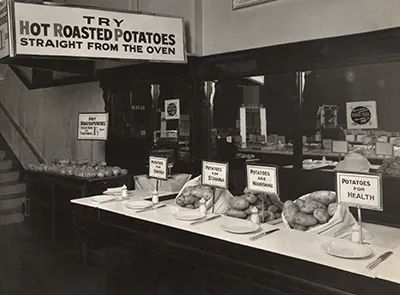 Picot was able to repeat his most successful product promotions from Portsmouth, with bakelite novelties and gramophone records as his hardy perennials. He also applied tricks he had learnt on the South Coast to draw shoppers away from a pinch-point by the main entrance towards the back counters and upper floor. The knack would be to get more people to use the side doors in Atlantic Road. They opened onto a lobby leading to stairs up to the upper salesfloor which had been added in 1926. There was just enough space to squeeze in something new. He added a display of steaming hot baked potatoes, sold straight from the oven for just 1½D - a penny halfpenny - which was under 1p at the time, equivalent to around 25p or 50¢ today. They were a surprise hit !
Picot was able to repeat his most successful product promotions from Portsmouth, with bakelite novelties and gramophone records as his hardy perennials. He also applied tricks he had learnt on the South Coast to draw shoppers away from a pinch-point by the main entrance towards the back counters and upper floor. The knack would be to get more people to use the side doors in Atlantic Road. They opened onto a lobby leading to stairs up to the upper salesfloor which had been added in 1926. There was just enough space to squeeze in something new. He added a display of steaming hot baked potatoes, sold straight from the oven for just 1½D - a penny halfpenny - which was under 1p at the time, equivalent to around 25p or 50¢ today. They were a surprise hit !
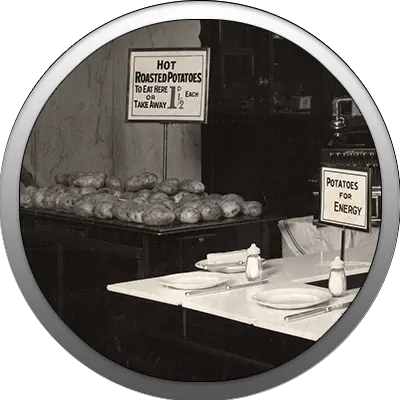
Hundreds of commuters a day began to use the side door, on the walk down from Southern Electric's Train Station on the London to Brighton Line. It seems they, and many traders from the small shops along the road, were drawn to the appetising sweet smell of the potatoes, and the promise of a bargain. On entering, many headed straight up to the first floor 'gallery', which had become the home of the best-selling ranges that people needed every day. After making their selections around the counters, they retraced their steps, grabbing a jacket potato to take home with them, and went on their way.
A simple ruse had taken pressure away from the front entrance, removing the crush that had been such a problem at the weekend. What was more, with direct access to the remaining stockroom, it was much easier to replenish the counters on the upper floor. The potato display made next to no profit itself, yet a huge contribution to the store's overall bottom line. Brixton was back on an even keel.

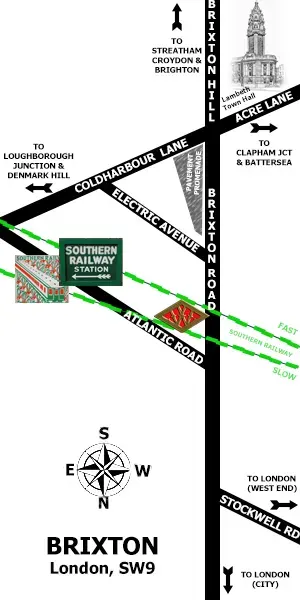 As daily trading settled into a familiar pattern which his Deputies and Floor-Walkers could manage day-to-day, Frank turned to his second objective. He dedicated two days a week. One was spent in the Property Department at Executive Office in New Bond Street, Mayfair; the other around the town, in the Library, local Planning Department or with other shopkeepers and business owners. Woolworth's Architect Brian Donaldson had determined that 'new Brixton' should be more than three times the size of the old one. He had targeted the search for a site along the opposite side of Brixton Road, which was home to a number of large shops, and on the smaller businesses north of the railway as the road headed to the City and West End. But not one property's lease was expiring, nor was for sale or even appeared to be in trouble. As a last resort he paid a professional land agent to make discrete enquiries, trying to tempt a freeholder to sell to an anonymous client. They had no takers. Donaldson had to admit that he had drawn a blank.
As daily trading settled into a familiar pattern which his Deputies and Floor-Walkers could manage day-to-day, Frank turned to his second objective. He dedicated two days a week. One was spent in the Property Department at Executive Office in New Bond Street, Mayfair; the other around the town, in the Library, local Planning Department or with other shopkeepers and business owners. Woolworth's Architect Brian Donaldson had determined that 'new Brixton' should be more than three times the size of the old one. He had targeted the search for a site along the opposite side of Brixton Road, which was home to a number of large shops, and on the smaller businesses north of the railway as the road headed to the City and West End. But not one property's lease was expiring, nor was for sale or even appeared to be in trouble. As a last resort he paid a professional land agent to make discrete enquiries, trying to tempt a freeholder to sell to an anonymous client. They had no takers. Donaldson had to admit that he had drawn a blank.
A trawl of the file revealed Frank and Fred Woolworth's original rationale for selecting Brixton for the first London store and their choice of building. They had deemed Atlantic Road the main entrance, thanks to the footfall from the station. Brixton Road was not deemed a shopping street at all at the time, with the main shops on the roads that led of it at either end. To the south Coldharbour Lane was home to small specialist outlets, between the Town Hall and Loughborough Junction, while Atlantic Road had the busier shops and street market. Frank and Fred planned to draw traffic in through the Atlantic Road entrance and encourage shoppers to exit after shopping into Brixton Road as a shortcut to the tram stops there.
By 1932 things had changed.
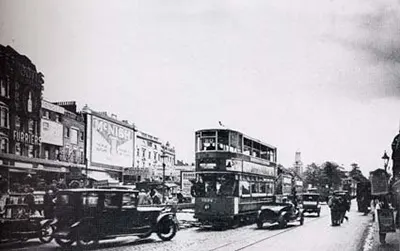 There could be little doubt that Brixton Road had become the main shopping street, with trade strongest on the opposite side. But the section between Electric Avenue and Coldharbour Lane appeared to be frozen in time, retaining its Edwardian grandeur, with shops set right back from the roadside, and a wide forecourt for ladies to 'take the air in the afternoon' standing between them and the main pavement and tram stops. Traders included a Furrier, a Hairdresser, a Tool Cutter, and a Chemist, all in small, dark premises. A branch of Barclays Bank and the Prince of Wales Public House stood on the corner of Coldharbour Lane.
There could be little doubt that Brixton Road had become the main shopping street, with trade strongest on the opposite side. But the section between Electric Avenue and Coldharbour Lane appeared to be frozen in time, retaining its Edwardian grandeur, with shops set right back from the roadside, and a wide forecourt for ladies to 'take the air in the afternoon' standing between them and the main pavement and tram stops. Traders included a Furrier, a Hairdresser, a Tool Cutter, and a Chemist, all in small, dark premises. A branch of Barclays Bank and the Prince of Wales Public House stood on the corner of Coldharbour Lane.
Frank thought that, once redeveloped, it could be the perfect spot with plenty of room to re-house those existing tenants who wanted to stay and be part of a new scheme. Brokering that deal would be a real feather in his cap!
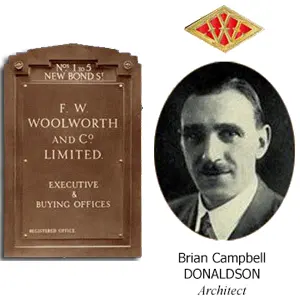
On his next trip to town, Frank shared his idea with Donaldson, who had mixed views. On the one hand he was confident that he could do it, having overseen other schemes that had involved building a whole parade of shops, developed jointly with a third-party investor. But those had been in areas with low land prices and an area of vacant or derelict land. He feared that the process of engaging multiple freeholders would be slow, challenging, and expensive. They would need local authority backing to avoid one nay-sayer undermining the whole scheme.
Despite his initial reticence, Donaldson offered to float the idea with the Chairman at his next one-to-one. With Stephenson's blessing he could give a few days to do measurements and come up with an artist's impression of what a new streetscape might be like to explore with the planners at the Town Hall.
Stephenson proved unexpectedly receptive to the Brixton proposal, surprising Donaldson by enthusing about Picot bringing a fresh perspective. Perhaps buoyed by a year's trading as a London-listed Company and the generosity of investors in raising and passing a resolution from the floor offering "a sincere vote of thanks to the Chairman", he was keen for the new Woolworth's to be 'our best yet'. He mused about the possibility of a parade with a large Woolworth's superstore at its centre, with the buildings either side having the same roof and window lines to give an aesthetically pleasing look. North, Robin and Wilsdon had evangelised the concept and he had been impressed by their first effort at Station Road, Harrow (Store 406) and Sainsbury's property team, operating as 'Cheyne Investments' had similar design ideas for their new premises. Perhaps FWW should be doing the same kind of thing, contributing to the communities that brought it prosperity. He asked Donaldson to engage Frank Sprague, the DM and Director, and take Picot to sound out the planners at Lambeth Town Hall.
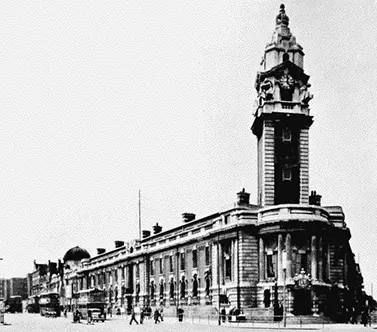 Armed with surveys and some initial concept drawings, the Woolworth's possé scheduled a meeting with the Head of Planning at the Metropolitan Borough of Lambeth. His desk at the Town Hall had a view out over the very spot that they wanted to discuss. It is said that although the meeting did not go as planned, it was still rated as a great success by the Board. Details are sketchy but it seems that the planners had been thinking along similar lines but were further advanced. For some time they had felt that the tapering building line and huge forecourt looked outdated, and the ramshackle buildings let the area down, clashing with the elegant, modern twentieth century department stores opposite. The idea had been positively received by the owners of the two dominant buildings, Barclays Bank and the Wenlock Brewery if it benefited them.
Armed with surveys and some initial concept drawings, the Woolworth's possé scheduled a meeting with the Head of Planning at the Metropolitan Borough of Lambeth. His desk at the Town Hall had a view out over the very spot that they wanted to discuss. It is said that although the meeting did not go as planned, it was still rated as a great success by the Board. Details are sketchy but it seems that the planners had been thinking along similar lines but were further advanced. For some time they had felt that the tapering building line and huge forecourt looked outdated, and the ramshackle buildings let the area down, clashing with the elegant, modern twentieth century department stores opposite. The idea had been positively received by the owners of the two dominant buildings, Barclays Bank and the Wenlock Brewery if it benefited them.
They got each to spell out any pre-conditions. Both would have to gain space from the change in building line, allowing them to increase the proportion of the building open to the public. Barclays Banks would insist on specifying the design. It had a "house style" (corporate identity) and had established an internal team to apply it sympathetically to each new branch. The Board insisted on a consistent look in every town. The Brewery also expected design control. It had gathered a lot of learning recently from across its many tenanted houses to formulate a vision for the future. Its Directors were keen to put this to the test in a prime location like Brixton. Joseph Hill, a fellow of the Royal Institute of British Architects, had been engaged to transform the theory into a practical set of drawings, plans and costings.
Fortunately enquiries had shown that the smaller shopkeepers were much more flexible. Each proved quite happy to move to another property, particularly if it was less old-fashioned, and in a busier spot with a similar rent. Subsequent exchanges had pinpointed properties and terms for each of them in Coldharbour Lane. A potential new tenant had also stepped forward. Planners had been approached by agents for a big-name retail brand, Dolcis Shoes, seeking a modern, bright medium-sized showroom in the high footfall section of Brixton Road. A new-build sounded ideal. The client had no strong preferences about the building design above the fascia level. The planners admitted they hadn't considered approaching Woolworth's, as the Company already had a large store and had added an upper salesfloor quite recently. But, yes, there would be ample space for a huge superstore, with room for a stylish covered market hall to its left hand side and perhaps two smaller shop units on either side. These could be sub-let to tenants until required for future expansion. Approval would be conditional on agreeing terms to buy the land and a modern, elegant and eye-catching scheme. They made clear that they would only accept a fitting centrepiece that would show "the very best of Brixton". Woolworth Builders had a high reputation for speed, efficiency and compliance with local ways of working. For simplicity it would be best for the Company to undertake the whole of phase one, including all of the neighbouring buildings, using sub-contractors as required.
Overall it seemed that the Woolworth team was knocking on an open door, though after hearing that local planners disliked the 'homogenized' look of the latest parades of lots of identical shops, they chose to keep their concept drawings under wraps. Donaldson later noted that in a long career this was the only occasion when drawings that had taken many hours of meticulous work never saw the light of day, but still considered the outcome to be a "win/win". It seemed that if the price and design were right they would be invited to redevelop the first half of the street from the immediate south of Timothy Whites and Taylors at the corner of Electric Avenue. Stephenson would get his "best yet" superstore and more besides.
The complex interdependencies of the project along with its sheer scale meant it would have to be organised very differently from the works that Frank had overseen at Clapham Junction and Portsmouth. The complex worksheets required for financial approval, setting out the construction and running costs for the new store and the sales and profit that it would generate, would be a team effort. Picot and District Manager Sprague drew on the skills of three experts from the Metropolitan Office, the Accountant, Real Estate Manager and Construction Superintendent, Messrs. Cooper, Lambourne and Sherrington, along with Donaldson and members of his planning team from Executive Office. Fortunately their endeavours found favour with Chairman Stephenson, who was willing to sacrifice his vision of a parade for a pragmatic solution bringing in two other large companies as well as the local authority. His sponsorship guaranteed a smooth ride with the Board, which signed off the Metropolitan District's largest ever investment in a single freehold property without hesitation.
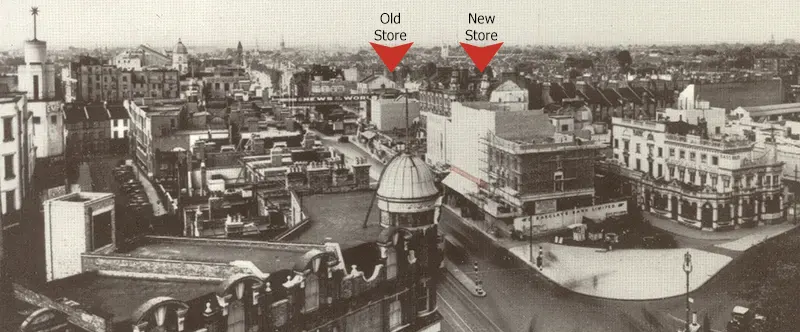
It took almost two years before demolition began on the buildings adjacent to Timothy Whites and Taylors on the corner of Electric Avenue, marking the start of phase one of the giant scheme which would erect the Brixton Road and Electric Avenue frontages of the huge new Woolworth store. The long delay had resulted from the other parties to the scheme's much longer approval processes and the painstaking consultation undertaken by the Town Hall to minimise the impact on other businesses and traffic on the busy arterial road.
By 1935 Woolworth had much more regimented ways of managing construction projects than Picot had experienced before. His role would be very different third time around. As the man on the spot, in the early stages he would track progress against an agreed set of service measures at weekly site meetings, with each of three dedicated managers hired by the sub-contractors to oversee the groundworks and construction of the exterior shell of the building. Later he would work closely with the Woolworth Construction Team as they fitted out the interior, laid the floor and installed the fixtures. The goal would be to manage the smooth transfer of not only the merchandise from the old store to the new, but also those fittings that were to be salvaged or re-used. Everything had to be planned and executed with military precision. In parallel Picot would have to hire and train enough people to staff the much larger store to ensure a smooth transition. This would keep him fully occupied.
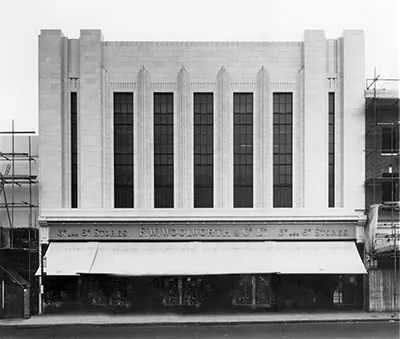 To the casual observer, Brixton's huge new Woolworth Building was built at incredible speed. Some local people nicknamed it The Beanstalk, as it seemed to grow further towards the sky every day. Construction of the superstructure was the fastest ever, as was the internal fit out. But the site preparation and foundation laying had taken three years. The Town Hall accepted "nothing but the best".
To the casual observer, Brixton's huge new Woolworth Building was built at incredible speed. Some local people nicknamed it The Beanstalk, as it seemed to grow further towards the sky every day. Construction of the superstructure was the fastest ever, as was the internal fit out. But the site preparation and foundation laying had taken three years. The Town Hall accepted "nothing but the best".
Donaldson didn't disappoint, adopting the very latest art deco design ideas with perfect symmetry. It was dominated by seven full-height casement windows, finished in brightly polished bronze, separated by eight pilasters. The hand-fired Shaw's Glazed Bricks gave a cream finish that glinted in the sunlight. The planners insisted that the third-party neighbours matched or exceeded the standard set by Donaldson.
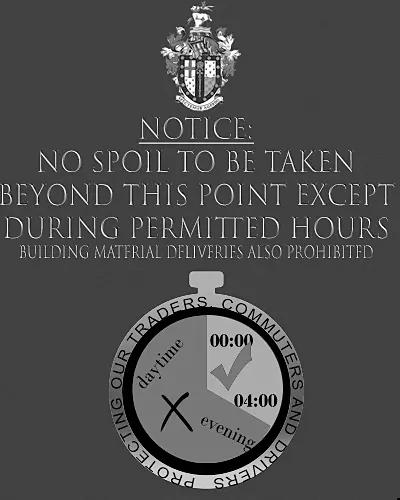 The Metropolitan District of Lambeth showed the same attention to detail when it came to controlling the building works themselves. It insisted that tall hoardings must be installed around the site, gloss painted and optionally lettered. This would avoid soil and dust spilling over into the existing shops or compromising the pavements. This meant that the demolition and groundworks, foundation-laying and the construction of the ground floors and basements took place unseen. The state-of-the-art buildings only became visible once they reached a height of ten metres.
The Metropolitan District of Lambeth showed the same attention to detail when it came to controlling the building works themselves. It insisted that tall hoardings must be installed around the site, gloss painted and optionally lettered. This would avoid soil and dust spilling over into the existing shops or compromising the pavements. This meant that the demolition and groundworks, foundation-laying and the construction of the ground floors and basements took place unseen. The state-of-the-art buildings only became visible once they reached a height of ten metres.
The town planners also pushed through local byelaws prohibiting the removal of spoil from the site and the receipt of large consignments of building materials during the daytime and evening, insisting that these should be confined to a four hour window from midnight until 4am. This would avoid disrupting the trade of the town's many shops and market stalls, and keep the neighbourhood fully accessible for the thousands of commuters who changed from train to tram or bus each day via a short walk through Atlantic Road or Electric Avenue to the stops along the main road. Above all it kept the never-ending stream of lorries, vans and private cars flowing along its carriageways from dawn until late at night, carrying London's lifeblood of goods and workers into town from the south as one of the UK's busiest major roads.
Frank could hardly complain at the controls that the Town Hall had placed on the project. It was the highly visible location, passed by hundreds of shareholders every day motoring in to the City from their homes dotted along the Sussex Coast around Brighton and the town's superb public transport, that had led Stephenson to propose relocating to larger, better premises. The Council's measures would also make his job easier. protecting trade as the works went on, and helping him to achieve double digit sales growth in the old premises, thanks to the promotions laid on by his network of contacts at New Bond Street. It would also smooth the way as he configured the new building and consolidated the stock from the external stockroom in Loughborough Junction, the smaller storage space on the upper floor of the old store, and the counter displays into the palatial new premises. The narrow time window defined by the Town Hall had forced the builders to level every inch of the access path, widen the loading dock and install an extra wide lift, so that loading and unloading would be as quick as possible.
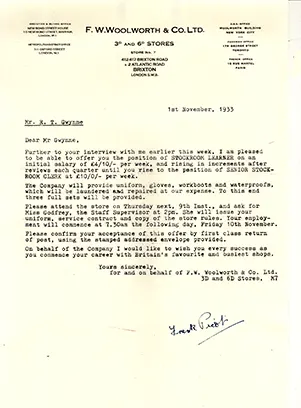 The protracted delay between getting the work approved and it actually commencing helped too, as Frank hired and trained new people whenever he could afford to increase his head-count. Experience over a long career had taught him that good Deputy Managers and Floor Walkers needed a year or two to learn the ropes and develop the confidence to be really effective, and stockroom learners typically took two to three years to work their way up the rungs of the ladder to fully-fledged stockmen. A larger management team would be needed at the new premises, where more than twice as many people would be on the payroll. In Frank's experience home-grown talent was always more loyal and trustworthy than employees poached from a neighbouring store.
The protracted delay between getting the work approved and it actually commencing helped too, as Frank hired and trained new people whenever he could afford to increase his head-count. Experience over a long career had taught him that good Deputy Managers and Floor Walkers needed a year or two to learn the ropes and develop the confidence to be really effective, and stockroom learners typically took two to three years to work their way up the rungs of the ladder to fully-fledged stockmen. A larger management team would be needed at the new premises, where more than twice as many people would be on the payroll. In Frank's experience home-grown talent was always more loyal and trustworthy than employees poached from a neighbouring store.
He also had a rethink about the best way to move from the old to the new store. Previously the final week had seen intense activity as armies of people wheeled trolleys at night, building to a mad dash after the old doors closed on Thursday afternoon before the grand opening on Friday. This time he would set up the two stores side-by-side, clearing behind the scenes at the old store but leaving its counter stock to be moved gradually after the new store had opened.
The new approach would be much cheaper. Shifts could be planned for the night work required to transfer the stock from behind the scenes without paying premium overtime. It would also minimise the shrinkage that had previously arisen from fragile items being scooped loose into baskets getting chipped and broken. Better still everyone serving in the new store on its opening day would be smiling and fresh-faced rather than yawning and in danger of falling asleep at their posts before the day was out. Once the new store was trading, as the counter stock sold down in the frenzy of the first days, the same night shift crew would be able to replenish the displays from the balance in the old store, a little at a time until it all cleared over a two or three week period.
 In the weeks leading up to the opening this had made it easy for his night crews to speed stock trollies unseen from the store front, under the bridge and round the corner outside Timothy Whites and Taylors and along Electric Avenue straight onto the loading dock of the huge new store. Six weeks before the planned opening, his daytime team began to move all of the reserve stocks from the overflow stockroom at Loughborough Junction (which had opened in 1926 to make way for the upper salesfloor) by van to the palatial stockroom on the first floor of the new building. They then emptied the ancillary accommodation and small stockroom above the old store, leaving just the essentials needed to keep the cash counted and staff fed.
In the weeks leading up to the opening this had made it easy for his night crews to speed stock trollies unseen from the store front, under the bridge and round the corner outside Timothy Whites and Taylors and along Electric Avenue straight onto the loading dock of the huge new store. Six weeks before the planned opening, his daytime team began to move all of the reserve stocks from the overflow stockroom at Loughborough Junction (which had opened in 1926 to make way for the upper salesfloor) by van to the palatial stockroom on the first floor of the new building. They then emptied the ancillary accommodation and small stockroom above the old store, leaving just the essentials needed to keep the cash counted and staff fed.
Frank and two of his deputies spent most of the month before opening working in the new premises, along with most of the new staff they had recruited. In the morning the newbies went upstairs for training delivered by the Floor Walkers he had engaged during 1934, while the boss's cohort set to work on the salesfloor.
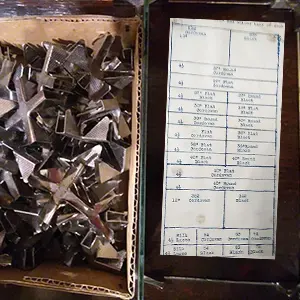 With the military precision that Frank was famed for, they systematically worked their way around the new counters, tracking progress against his hand-drawn plan. Displays were configured using handy guidance prepared by the Buyer, based on the relative rate of sale of each line in the range. They cut the glass dividers to make compartments of the right size and slotted them on to the top of the mahogany counter along with a single sample of the item. They recorded how many more it would take to fill up in the stock book, known as a binder. By lunchtime a stockroom clerk would have collated all of the stock into trolleys and put them in the aisle next to the display, which would be filled after the morning training session had completed. As the new recruits filled up, the floor walkers clipped descriptive price tickets onto each slot, helping to ensure that shoppers would know and be charged the correct price for the item.
With the military precision that Frank was famed for, they systematically worked their way around the new counters, tracking progress against his hand-drawn plan. Displays were configured using handy guidance prepared by the Buyer, based on the relative rate of sale of each line in the range. They cut the glass dividers to make compartments of the right size and slotted them on to the top of the mahogany counter along with a single sample of the item. They recorded how many more it would take to fill up in the stock book, known as a binder. By lunchtime a stockroom clerk would have collated all of the stock into trolleys and put them in the aisle next to the display, which would be filled after the morning training session had completed. As the new recruits filled up, the floor walkers clipped descriptive price tickets onto each slot, helping to ensure that shoppers would know and be charged the correct price for the item.
The new store looked magnificent on opening day. The festivities were Frank's best yet, with help from John Snow and his chums from Metropolitan District Office. One of Frank's favourite tricks during his time at Brixton was to work with the leading cinema operators and film-makers, Gaumont British to promote the movie playing at their Palace in Streatham. He regularly arranged tie-ups with the local paper, with tickets being given away to competition winners, while featuring the sixpenny sheet music, and Eclipse or Crown Gramophone Records featuring numbers from the show, and fan postcards of the stars. Sales on a film tie-up could sometimes top £250 in a single week, generating more than £75 profit. For the Grand Reopening Gaumont had gone the extra mile, persuading their leading star Cicely Courtneidge to cut the ribbon to open the store and then to mingle with the star-struck customers, signing autographs and chatting away about the film star life.
Chairman Stephenson loved the new look store, commending Frank for bringing it in under budget, and for halving the pre-opening labour costs compared with other similar projects. Frank was surprised at how star-struck his boss was, hanging on Ms Courtneidge's every word and declaring himself a fan.
When he left, Stephenson said he would be back in just under the year for 'part two'. A replacement for the Prince of Wales Pub would be built during 1937, opening into Coldharbour Lane. Its design included an Annex for Woolworth's, adding a large customer restaurant in a new wing to the right of the existing salesfloor with its own entrance. The new facility would offer cooked meals and snacks from 7am until 11pm each day.
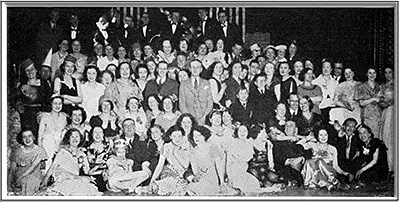 All were agreed that the grand opening was Frank's best yet and that his new staff had excelled. As a thank-you he planned a huge party at a fancy London hotel, arranging coaches to whisk employees and their partners to the venue, along with the Executives from the Offices who had gone the extra mile, and of course the Superintendent. By all accounts the staff had a whale of a time, with many shop girls insisting on a dance with the boss. Frank took a photo of the gathering for the new staff magazine, which appeared in The New Bond in December 1936.
All were agreed that the grand opening was Frank's best yet and that his new staff had excelled. As a thank-you he planned a huge party at a fancy London hotel, arranging coaches to whisk employees and their partners to the venue, along with the Executives from the Offices who had gone the extra mile, and of course the Superintendent. By all accounts the staff had a whale of a time, with many shop girls insisting on a dance with the boss. Frank took a photo of the gathering for the new staff magazine, which appeared in The New Bond in December 1936.
The Year End inventory stock count, taken on Boxing Day, confirmed that 1936 had been a bumper year. Sales at Brixton had reached all-time high, standing over a third higher than the previous year after just 119 days in the new building, with the profit contribution rising even faster thanks to a 1% rise in the gross margin achieved on the goods sold and a reduction of the annual shrinkage (stock loss) of slightly over £2,000. For Picot this would mean another bumper bonus as recompense for a stretching year, and the prospect of doing it all again in 1937.
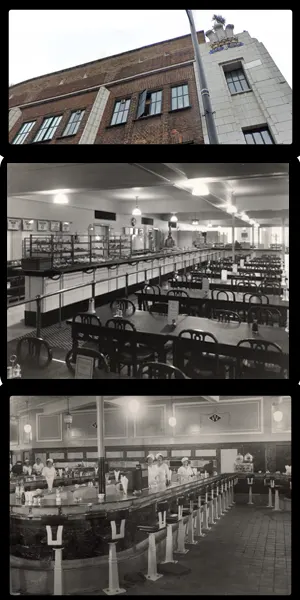 Work was already well progressed on Barclays Bank's new chambers to the right of Woolworth's. The builders spent the cold winter months fitting out its upper floors, which the owners planned to sublet as offices, before setting to work on the new pub. The huge building would dominate the corner of Coldharbour Lane. Its design drew elements from the Woolworth art deco look, including the pilasters and Shaw's Glazed Bricks, with the shiny yellow glow finished with a fleur de lys motif just below the roof-line.
Work was already well progressed on Barclays Bank's new chambers to the right of Woolworth's. The builders spent the cold winter months fitting out its upper floors, which the owners planned to sublet as offices, before setting to work on the new pub. The huge building would dominate the corner of Coldharbour Lane. Its design drew elements from the Woolworth art deco look, including the pilasters and Shaw's Glazed Bricks, with the shiny yellow glow finished with a fleur de lys motif just below the roof-line.
About three quarters of the footprint was given over to public bars and ancillary accommodation, while the final quarter would form the Woolworth Annex. The published plan indicated that the bulk of this section would be a traditional-style Woolworth's Customer Restaurant, with a large servery and food preparation and storage areas. Picot had expressed reservations about this section of the layout, but had chosen to lose the battle before winning the war later.
At the beginning of 1937 Frank had resumed the fight, submitting a request to swap the planned restaurant for a Quick Lunch Counter, on the basis that Brixton was a commuter suburb where fast service was essential, and citing his results from Portsmouth. He promised to achieve twice the targeted restaurant sales, and as much again on merchandise from the extra 400 feet (120 metres) of counters in the new layout, all for a lower initial outlay. He had expected this to be a "no-brainer" that would be signed off before reaching the Board's Investment Committee. But it fell on deaf ears. He hadn't heard big changes were afoot at Executive Office.
It was a year since he had caught up with the Chairman William Stephenson at his grand opening. Since then it seemed the boss had turned his thoughts to retirement in a year or two's time, concluding it was time to train up some new blood ready to take the helm. From January 1 he would split the roles of Chairman and MD, continuing to woo investors, bankers and the parent company, while handing over day-to-day operations to a new Managing Director and his Deputy. He had selected none other than Louis Denempont as MD and Ernie Cox as his Deputy, promising them a free rein, without interference. Initially this sounded like good news that the roles had been handed to two old friends, but to his surprise, when Frank contacted them both men seemed pre-occupied and aloof. It transpired that Stephenson had advised them to step out of day-to-day decision making in their new roles, delegating authority wherever possible. For a probationary period he would be keeping a close eye on them to help them make the transition. In circumstances they could only advise Frank to follow official channels, approaching the Merchandiser at District Office or the District Manager. They were sure that Frank's case would be as persuasive as ever and would soon win through following "the right route".
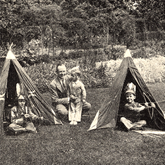
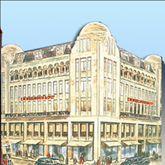 It didn't take Frank long to find that the same wind of change was working its way through Metropolitan District Office above the Oxford St. W1 store. The Chairman, W.L. Stephenson, had asked Frank Sprague to put Stanley Swash in day-to-day charge as a development step. It would allow Sprague to take on more Directorial duties at New Bond Street. Sprague also strengthened the team by appointing two new Merchandisers who were still settling in.
It didn't take Frank long to find that the same wind of change was working its way through Metropolitan District Office above the Oxford St. W1 store. The Chairman, W.L. Stephenson, had asked Frank Sprague to put Stanley Swash in day-to-day charge as a development step. It would allow Sprague to take on more Directorial duties at New Bond Street. Sprague also strengthened the team by appointing two new Merchandisers who were still settling in.
Despite their friendship over the years, Frank found Swash was no pushover. Although sceptical he did reluctantly agree to back the Quick Lunch Counter, if Picot could persuade Buying Director John Snow to list new merchandise to fill the extra shelf-space. It had been an uphill battle, in which he had been obliged to call in a number of favours that could only be used once. He might not get his own way in any future showdown.
Finally, as Spring turned to Summer, with the groundwork of permissions finally laid, Picot began to shape and plan the moves needed to bring the extension into use and put the store onto the full layout that he had originally shaped over five years earlier. New ranges were ordered, and the sequence of counters and layout of some of the displays was replanned on paper so that the work could begin as soon as the builders had finished linking the annex. In parallel he began work preparing for his new restaurant, hiring and training chefs, kitchen porters and catering assistants.
The dust had barely settled by the time the building was handed over, heralding eight weeks of intense activity from the beginning of September. Counter displays had to be relaid one by one, with Frank or one of his deputies preparing the skeleton for others to fill up, taking care to keep everything on sale in the existing store. The final displays were perfected at the beginning of November, with Christmas Cards, Ornaments and Novelties and a remarkable selection of toys taking the place of the autumn bulbs and shrubs as they sold out, just in time for everything to get a spit and polish before an opening ceremony on November 18th.
The store looked magnificent by opening day, with the salesfloor brimming with wonders for Christmas stretching as far as the eye could see, alongside a complete selection of the staple ranges for which Woolworth's had become famous. Frank was particularly proud of the Quick Service Lunch Counter, which fitted perfectly into the Annex leading up to the entrance in Coldharbour Lane, and was brightly illuminated to make it visible from all around the salesfloor. A number of refinements had been made since the first trial at Portsmouth, giving a sharper, ultra-modern look that seemed to shout "go on sit down, treat yourself, you deserve it!"
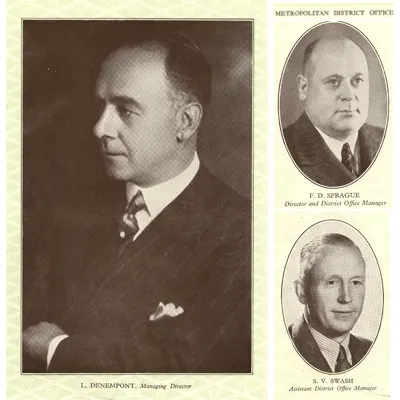
The opening celebrations were scaled back on advice from District Office. Frank Sprague and his newly-appointed Deputy, Stanley Swash, had explored the possibility of simply opening the annex without marking the occasion, as it was only a year since the new building had opened and trading was so buoyant. Instead they recommended something simple to thank the builders and the staff who had gone the extra mile during phase two of the works, with just a few treats for loyal customers. Louis Denempont rather than William Stephenson would cut the ribbon, now that he had taken the helm as MD. The new man had arranged three store ceremonies locally over just eight days. On Friday 12 November he would open a brand new store two miles the south of Brixton at West Norwood (Store 707), followed by Frank's annex on Thursday 18 and finishing three miles in the other direction at Clapham Junction on Friday 19. After many years the restrictive covenant had expired, allowing redevelopment of the side alley and far left of the frontage.
It seemed strange to have no sixpenny pops or stars from the silver screen, though loyal shoppers seemed to appreciate the freebies laid on by a handful of key suppliers, and took full advantage of the teaser hot drinks, cakes, pastries and main meal tasters from the Quick Lunch Menu. Denempont greeted Frank as an old friend, reminiscing about the day that he and Sprague had spent at Picot's new look Clapham Junction back in the mists of time. The MD declared that Brixton was another great triumph, and passed on hearty congratulations from the Chairman, for completing his mission. Sprague would be in touch after Christmas to discuss a new challenge now that the Brixton project was complete. In the meantime he advised Picot to "make hay while the sun shines" to maximise profit and boost his bonus at the year end.
Despite some misgivings at being moved so soon after completing the long project, rather than reaping the reward of his efforts, Picot thought it best to keep his own counsel and opted not to rock the boat.
Just eight short weeks later, almost before the ink used to complete the Inventory Stock Book was complete, Picot received 'the call' summoning him to meet with District Manager Sprague. The only concession to his long, loyal service was that the two men would meet up in the early evening and take dinner together, rather than having a short face-to-face meeting in the office.
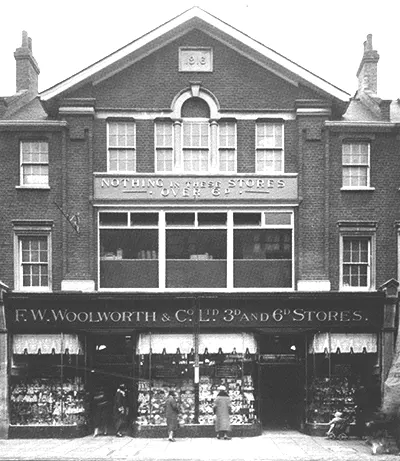 Sprague was clearly uncomfortable as the two sat down to eat. In his pre-amble he reiterated how pleased he was with Picot's work at Brixton, and how impressed the Chairman was at the dogged determination he had shown to bring the scheme to a conclusion despite the third-party delays and the Council's intransigence. Store 7 was a "a store to be proud of" according to Stephenson, and for many a manager it would be the crowning glory of a long career.
Sprague was clearly uncomfortable as the two sat down to eat. In his pre-amble he reiterated how pleased he was with Picot's work at Brixton, and how impressed the Chairman was at the dogged determination he had shown to bring the scheme to a conclusion despite the third-party delays and the Council's intransigence. Store 7 was a "a store to be proud of" according to Stephenson, and for many a manager it would be the crowning glory of a long career.
But - albeit for good reasons - it had taken much longer than either man had expected at the outset. Six years in one place was a long time for one of FWW's most talented managers, on a premium bonus, particularly when an urgent, fresh challenge was overdue for attention. Denempont had endorsed the Chairman's view that Store 74 in the fashionable Ealing Broadway, Middlesex to the West of London needed the Picot treatment. While at first glance it might seem like a step back, the potential was almost without limit. To mitigate any risk, Frank would receive his customary special commission rate, bolstered by an exceptionally low sales and profit target, and a cast iron guarantee that whatever happened his earnings would be maintained for his first two years in post.
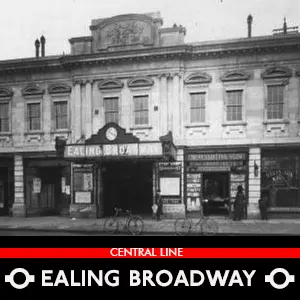 Despite his shell-shock, Frank was keen to find out more. The DM added that Store 74 had originally been the pride of the line, one of its first architect-designed, purpose-built stores, situated in an up-and-coming Middlesex suburb which was unofficially absorbed into West London after London Underground's District Line opened its Ealing Broadway Station. North and Robin had designed it in 1915 and nominated Shop Properties Ltd as builders. Unfortunately over the winter of 1915 several key suppliers were directed to make munitions instead of shopfittings, forcing compromises with the building materials used. Despite that, the finished store initially looked good and prospered. But within ten years it had begun to deteriorate badly, drawing attention to its quaint design and size limitations. The Property Department had struggled to find a way of extending or rebuilding it because of the nature of the site and the neighbouring properties. All were agreed that what was needed was Frank's legendary fresh perspective!
Despite his shell-shock, Frank was keen to find out more. The DM added that Store 74 had originally been the pride of the line, one of its first architect-designed, purpose-built stores, situated in an up-and-coming Middlesex suburb which was unofficially absorbed into West London after London Underground's District Line opened its Ealing Broadway Station. North and Robin had designed it in 1915 and nominated Shop Properties Ltd as builders. Unfortunately over the winter of 1915 several key suppliers were directed to make munitions instead of shopfittings, forcing compromises with the building materials used. Despite that, the finished store initially looked good and prospered. But within ten years it had begun to deteriorate badly, drawing attention to its quaint design and size limitations. The Property Department had struggled to find a way of extending or rebuilding it because of the nature of the site and the neighbouring properties. All were agreed that what was needed was Frank's legendary fresh perspective!
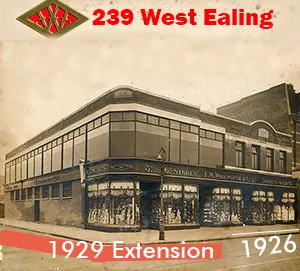 There would be initial frustrations. The roof and upper window frames leaked like a sieve, having half the normal lead content in the flashings. Frequent patching had weakened the wood and putty further, without stemming the flow. But on the positive side, every Manager in recent times had only stayed a year, leaving lots of untapped potential as sales and profit had slipped back. A second, smaller suburban store had been added nearby in 1926 and baptized '239 West Ealing'. Trading had been so buoyant that it had been tripled in size in 1929, making it much larger than the 'main store' in the town centre. '239' was larger, brighter and more modern, stil in the same road but in a section with ample free car parking. To date no effort had been made to restore the original outlet. Sprague felt that Picot's gift for engaging the media and sourcing outstanding product promotions would soon get the tills jangling again, and soon it would really clean up.
There would be initial frustrations. The roof and upper window frames leaked like a sieve, having half the normal lead content in the flashings. Frequent patching had weakened the wood and putty further, without stemming the flow. But on the positive side, every Manager in recent times had only stayed a year, leaving lots of untapped potential as sales and profit had slipped back. A second, smaller suburban store had been added nearby in 1926 and baptized '239 West Ealing'. Trading had been so buoyant that it had been tripled in size in 1929, making it much larger than the 'main store' in the town centre. '239' was larger, brighter and more modern, stil in the same road but in a section with ample free car parking. To date no effort had been made to restore the original outlet. Sprague felt that Picot's gift for engaging the media and sourcing outstanding product promotions would soon get the tills jangling again, and soon it would really clean up.
The DM assured his dinner guest that the Ealing move would not be for long. They should aim to get Worksheets approved and a scheme underway before the year end and to complete a full reconstruction before peak Christmas trading in 1939. The Chairman was determined to start the new decade with "800 stores to be proud of" particularly in areas like Ealing as local outlet of many-a-shareholder.
Once construction was complete, he would give Picot the option to spend a couple of years banking his bonus, which should be the highest yet, moving on to a similar challenge, or finally agreeing to accept a promotion. He intended to promote the Croydon Manager up to Brixton in Frank's place - a sign that it had become the premier store locally since the Annex opened. He planned to move Mr Wild out of the city smoke at 700 Cheapside down to the Surrey air of Croydon in an attempt to restore his health. Ramping up the moral pressure, Sprague told Picot that he would not only be helping himself but also his colleagues and the District, and that would not be forgotten. As a Company man, Frank put on a brave face and agreed to do what was expected of him.
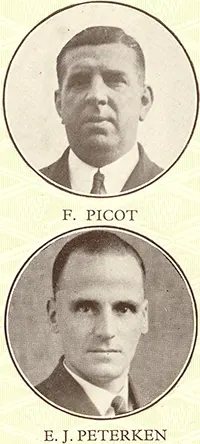 Some of the more aloof superstore managers kept themselves so remote from their staff that they were able to receive a summons to District Office at the year end without setting off a frenzy of speculation, and head to the meeting without even their Deputy guessing what was happening. Frank was much more gregarious, meaning that despite his discretion, by the time he had set off to Oxford Street everybody had picked up the signals and huddles were forming a view of what was happening. Few believed that the Company would move 'Mr P' so soon after finally finishing the opening of his beautiful new store. But the following morning, as they arrived to work, all could see the tell-tale sign - two Store Managers walking the salesfloor, looking at everything and deep in conversation. Many of the longer servers recognised the other man as Edward Peterken of the nearby superstore at Croydon. The two men spent the morning going through a lengthy, formal handover procedure, one step at a time. Both were the very model of discretion, getting on with the job in hand, speaking only to others as the process required.
Some of the more aloof superstore managers kept themselves so remote from their staff that they were able to receive a summons to District Office at the year end without setting off a frenzy of speculation, and head to the meeting without even their Deputy guessing what was happening. Frank was much more gregarious, meaning that despite his discretion, by the time he had set off to Oxford Street everybody had picked up the signals and huddles were forming a view of what was happening. Few believed that the Company would move 'Mr P' so soon after finally finishing the opening of his beautiful new store. But the following morning, as they arrived to work, all could see the tell-tale sign - two Store Managers walking the salesfloor, looking at everything and deep in conversation. Many of the longer servers recognised the other man as Edward Peterken of the nearby superstore at Croydon. The two men spent the morning going through a lengthy, formal handover procedure, one step at a time. Both were the very model of discretion, getting on with the job in hand, speaking only to others as the process required.
One of the Company's standing instructions proved particularly challenging. At every handover the new manager had to set a new safe combination. The process required special keys to be used to dismantle the lock, using a reset tool to crank in and validate the new digits. Pinpoint accuracy was essential, otherwise the safe might never open again. By the time this was complete events were running two hours behind. Despite their early start, by mid-day there was still much to do. The two chose to pop round to Wenlock's Prince of Wales Saloon for a bite to eat. Little did Frank know that, without doing anything to rock the boat, he was about to find himself in all sorts of trouble that would blight the rest of his career.
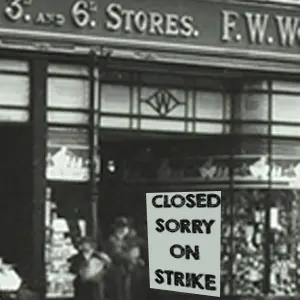 Before the two had finished their lunches a buzz went round the bar that something was happening at Woolworth's. They hurried back to find the doors locked, with a handwritten sign on the inside of the glass saying "Closed Sorry On Strike". Word among the crowd was that the girls had stormed off their counters, refusing to let customers pay, instead throwing them out into the street. They were incensed that their Manager and friend was being forced out of the store that he had built and sent to some hell on earth! Woolworth must think again. Someone had summoned the Superintendent, and promised the local and national press a story too good to miss.
Before the two had finished their lunches a buzz went round the bar that something was happening at Woolworth's. They hurried back to find the doors locked, with a handwritten sign on the inside of the glass saying "Closed Sorry On Strike". Word among the crowd was that the girls had stormed off their counters, refusing to let customers pay, instead throwing them out into the street. They were incensed that their Manager and friend was being forced out of the store that he had built and sent to some hell on earth! Woolworth must think again. Someone had summoned the Superintendent, and promised the local and national press a story too good to miss.
They let Frank straight in, but told Edward Peterken that he wasn't welcome. Within an hour, they had grudgingly accepted Picot's assurance that he was happy with the move. He had to go where the work was, sorting out the toughest, oldest stores and bringing them up-to-date. But his career was already on the bonfire.
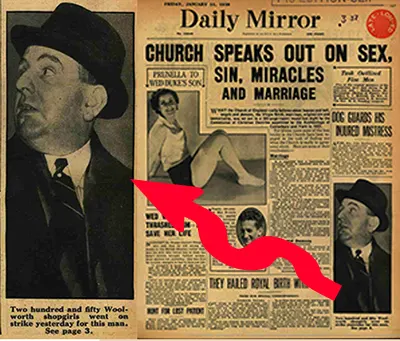 250 Woolworth Shop Girls went on strike for this man. Read the full story, Page 5.
250 Woolworth Shop Girls went on strike for this man. Read the full story, Page 5.
Explore the story in full resolution.
For Woolworth bosses appearing in the newspaper was a mortal sin, even in a law report on an inside page. So was revealing any company secret. It appeared Frank had committed multiple 'hanging offences'. He had briefed his staff against the company. He had posed for 'that photograph' and he had persuaded a high circulation red-top paper to give the story pride of place on the front page. Not one person accepted his howls of protest that he was an innocent victim, believing his sins had caught up with him, and not before time.
Without waiting for an official company view, the Superintendents from the Metropolitan District were so incensed that they saw no need to investigate directly with Frank before passing a verdict. He had sacrificed the right to defend himself. They shared their observations from spells as his line manager, adding fuel to the flames as rumours spread like wildfire. The consensus was that Picot had been a dinosaur from the start, an unreformed army man who did his own thing and rarely followed 'The Woolworth Way' of doing anything. Discipline was lax in his stores. He used first names and was over-familiar with the staff. He spent time every day gossiping and larking about rather than conducting a professional morning inspection. He believed rules were there to be broken, and appeared to do so with impunity. Long ago Picot had been the Founding MD Fred Moore Woolworth's blue-eyed boy, and had been encouraged to play the maverick and shake things up. Later Fred had evangelised his trouble-shooter's ability to get things done to his other protégé, William Stephenson, leaving the present-day Chairman with a bit of a blind spot, continuing to assign Picot to challenging projects that would encourage his rule-breaking.
In turning a blind eye to Picot's rule-breaking early in his career, the top brass had opened the door for his excesses to get worse. Rumours of a scandal at Brixton had been circulating for a while. Not only was the Manager carrying on with a shop girl when he was supposed to be a happily married man, but she had become his mistress and he had set her up in a love nest to bring up an illegitimate child. Perhaps petty jealousies lay behind the strike when it emerged that the Manager was departing for pastures new. Whatever the explanation it seemed that Picot had sown the seeds of his own destruction by breaching the strict anti-fraternization policy that applied to all Woolworth management.
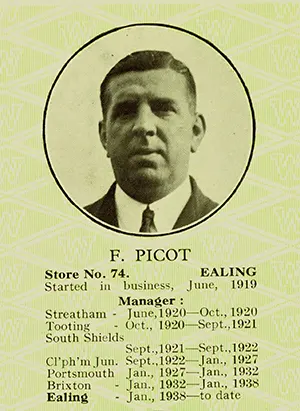
It seems particularly cruel, given his long service and many successes, that rather than Fred Sprague, as the District Manager and a Director of the Company, summoning Picot to give account of himself in some kind of disciplinary interview, or MD Denempont or Chairman Stephenson intervening, not a single word was said. The move to Ealing went ahead exactly as planned, just as if nothing had happened. He would discover over time that everything had changed, as colleagues closed ranks and simply froze him out, doing the Directors' dirty work for them with a type of bullying that went beyond cruel to vindictive and vengeful.
Things seemed normal enough on arrival at Ealing the following day. He had arranged to meet his predecessor, Peter Wilson, for the handover ay 7.30am. Peter had been a Store Manager for ten years and had managed the smaller of the two Croydon branches since January 1937 (Store 234 in Church Street). It was only about five miles from Brixton. He greeted Frank as an old friend, pleased to meet him again. He had done his homework to smooth the transition.
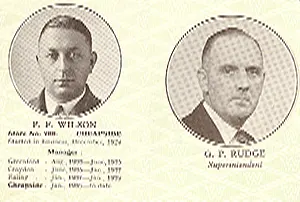
He had painstakingly prepared the Inventory/Stock Book, Freight and Claims Books and Cash and Cash Register Reports ready for a smooth transition. He had also dug out the release and reset keys for the treasury safe and Chatswood's detailed instructions of how to dial in and set a new combination. The whole process was much smoother than it had been at Brixton and by mid-morning was nearly complete. After asking Cook for a couple of coffees, Wilson called Barney Rudge, the Superintendent to let him know that the job was done and asking whether he should hang on for an official sign-off, or could safely head East to his new store at Cheapside (Store 700) in the shadow of St Paul's Cathedral in the City.
 Rudge sent Wilson on his way, asking him to tell Picot to stick around in-store as he would be along before lunchtime with the replacement locks for the front doors. If possible perhaps the new manager could avoid getting locked out until then!
Rudge sent Wilson on his way, asking him to tell Picot to stick around in-store as he would be along before lunchtime with the replacement locks for the front doors. If possible perhaps the new manager could avoid getting locked out until then!
Rudge had a reputation as a straight bat, an old school Superintendent who was a stickler for the rules, but applied them in a consistent firm and fair way. He could be ruthless if crossed, but was patient and supportive with Managers who tried their best but struggled to learn the more complex aspects of the Company's spider's web of all-enveloping paperwork. Picot might have expected a fair hearing or at least a fresh start but he got nothing of the sort. It seems that as a Company man through-and-through either Rudge had decided for himself that his new manager must be hounded out or at least cut down to size, or had been instructed to teach Picot a lesson that would resonate around the Company.
From their first meeting, Rudge was absolutely polite and correct and totally cold and blunt. He made clear that his role was to keep his Managers on the straight and narrow, inspecting their work, detailing the improvements required and enforcing the rules. He had a view that Managers had to prove their mastery of the basics before graduating onto the discretionary parts of the job like setting up their own product promotions, adapting the store layout or driving business cases for alterations in-store. And sometimes even long-serving Managers had to take a step back and re-learn the basics, proving themselves all over again. That was his read of the situation.
Frank feared that what his new boss meant but was not saying explicitly, is that he would no longer be trusted to define his own range and layout, nor permitted to deal directly with the Buyers and Architects at New Bond Street, nor the Merchandise Men and Real Estate Experts at Metropolitan District Office. That would prevent him from tackling the objective that MD Denempont had set for his new role at Ealing, as set out during his appointment interview with the District Office Manager and Director, Frank Sprague. The Superintendent's reply confirmed his worst fears:-
"I know nothing of any such objective, and do not believe that the local market could sustain rebuilding Store 74 at present. Three years ago a large new housing development came on-line along Broadway at West Ealing. Since then it has released a tranche of affordable new homes every three months or so. In my view this has dramatically boosted the potential of Store 239. It is that branch that merits new investment, not the old one in the Town Centre. That view is shared by the Architects at EO, and the team of Merchandise Men, Construction and Real Estate Experts at MDO." He added "Given the declining sales situation at Store 74 since 1935, all expenses should be pared to the bone, particularly the burgeoning running repairs to the roof, window frames and heating system."
Overnight the Company had found a way to express its displeasure at being plastered across the popular press. Sprague later admitted that he had masterminded the response, which had found favour with Denempont and Stephenson. Privately Picot would be left in no doubt that the Board was incandescent with rage. His career would go on hold for two years, an appropriate penance. A new store in Ealing Town would have wait until 1941. The Board believed that this was a balanced punishment that would avoid their long-serving manager losing face with his peers and - by honouring their commitment to maintain his earnings to the level achieved in his most successful year at Brixton - he would not suffer a significant financial loss, and could rejoin the rat-race once he had learnt his lesson and the furore had calmed down.
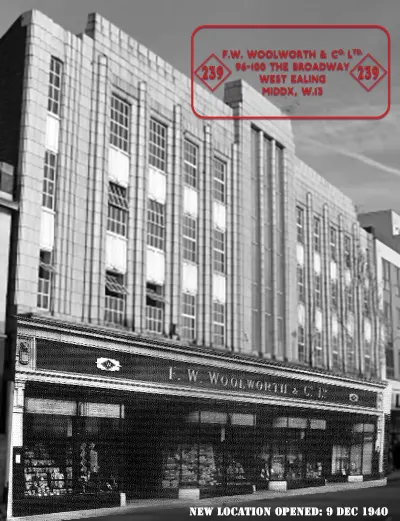
Sprague's carefully crafted response had dreadful consequences that he certainly did not intend. Seeing the writing on the wall for Picot, some middle managers stuck the boot in, taking revenge for some petty jealousy, or because they felt let down. Buyers shunned his calls even about the simplest things. Some suppliers appeared to have been told to ignore any orders that had not been countersigned by District Office.
The Property team was particularly spiteful. It maliciously confounded every attempt to have the boiler, roof or window frames at Ealing repaired, leaving the store damp and freezing cold, with large patches of mould on the wall of the Manager's private office directly above the main entrance. They also forced through a scheme to fully rebuild a huge new art deco version of the other Ealing, No. 239, the antithesis of Frank's job objective. They went to great lengths to complete the work despite shortages of labour and building materials after the outbreak of war. Construction was rushed through as the Battle of Britain raged in the skies overhead.
The new premises (right) opened to great acclaim on 9 December 1940, fifteen months into World War II, standing three times the size of the main branch in the town, as the largest Woolworth ever to open in a secondary High Street.
News of that opening put Frank into a tailspin. He had proved remarkably resilient at Ealing, settling into the role and systematically reworking the store from top-to-bottom to make it easier to manage, and to squeeze every penny of sales out of each inch of counter space. While he might no longer be able to call up the Buyer or one of the Merchandise Men at District Office for specials or extra stock of the best lines, no-one understood the company's paperwork better. Filled in correctly and sent early paper forms could unlock access to vast quantities held in the main Granary Warehouse in St Pancras. Before long his Deputies and Learners had the same skills, and were passing them down the line to those Sales Assistants who acted as Merchandisers on the Counters. The Company's arms length approach, required by Superintendent Rudge, might be unfamiliar, but it had merits and soon began to run like clockwork. It freed him to spend more time in the office - checking, correcting and managing the store on paper, to maximise availability and follow up on claims and allowances to mitigate the effects of shrinkage.

The family believes that it was Frank decision to spend more time behind the scenes, particularly in his mould-infested private office above the main entrance of the store, where he could see customers entering and leaving through the window, that caused his health to deteriorate rapidly in during late Summer and Autumn 1941. Seeing his Manager overwhelmed with cold and flu like symptoms, struggling to breathe when he arrived for a regular inspection visit, Superintendent Rudge summoned the Company Doctor at once, who diagnosed severe pneumonia. At the time there was no cure, nature would have to take its course. The Doctor recommended full company sick pay for an extended period of complete rest, recouperating in bed, which was granted without hesitation by the Board, but there was little else that he could do. For months his wife nursed him round the clock, but it was too late. Little-by-little he simply faded away, finally expiring at home in Brentford a shadow of his former self in August 1942. He was just forty-nine years old.
Brother Phil felt that while the Company had failed to break Frank's spirit after the Brixton strike, with the war hero proving that he was made of sterner stuff, the Property Teams at both District and Executive Office had questions to answer about the failure to maintain or repair the heating and building fabric at Ealing. His words fell on deaf ears, and after years of repeating them, after World War II he seemed to retreat into his shell, quietly eking out an existence as a Store Manager rather than constantly pushing himself forward. It probably also explains why middle brother George Picot decided not to exercise his right to return to his role as Associate General Manager at Edgware Road, when the Store Manager of 138 Gillingham demobilized in 1946. It seems that both of Frank’s brothers had seen the very best and worst of the Company during their long, dedicated service. At times Executives had been kind and generous, but the Company policy of “my way or the highway” had proved cruel and utterly insensitive.
With hindsight the speed and depth of the fall from grace of one of the company's most loyal, dedicated sons was shameful, and inspired this extended celebration of Frank's unique contribution to Woolworth's, finally documented for posterity eighty years after he locked the doors for the last time. The Woolworths Museum is proud to honour Frank Picot.
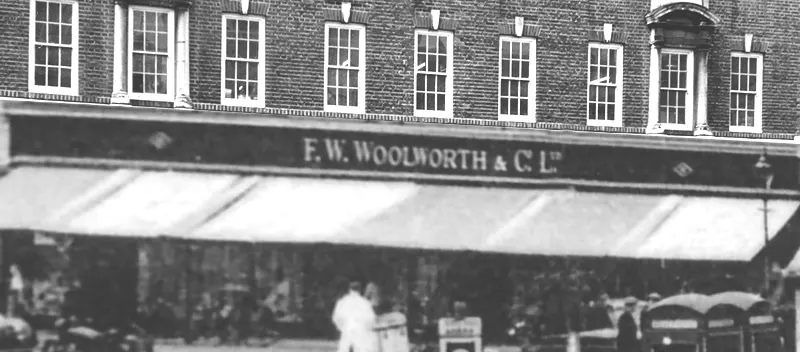
By way of an epilogue, the Ealing Broadway store in the town centre was extensively refurbished in 1957. The exterior shell was replaced with new brickwork and window frames in the 1940s style to maintain the character and charm of the building, rather than the glass, steel and concrete more commonly used at that time. This gave it the look it would have had if Frank Picot’s project had gone ahead as planned. Once again it became the major Ealing store. Thirty years later it was hand-picked for a new, experimental trading format called “Kidstore”. The learnings that it generated helped to shape Operation Focus, the project that reinvented Woolworth in the 1980s and bought it an extra twenty years as a profitable, market-leading brand that made its highest ever profit in 1997,
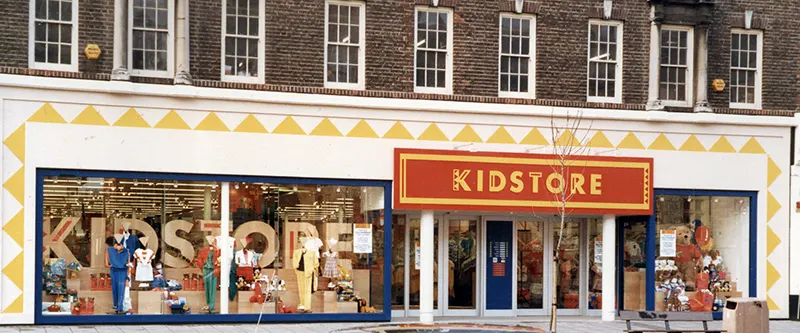
Shortcuts to the other pages in the Picot Mix Special Feature
The current page is highlighted and emboldened
